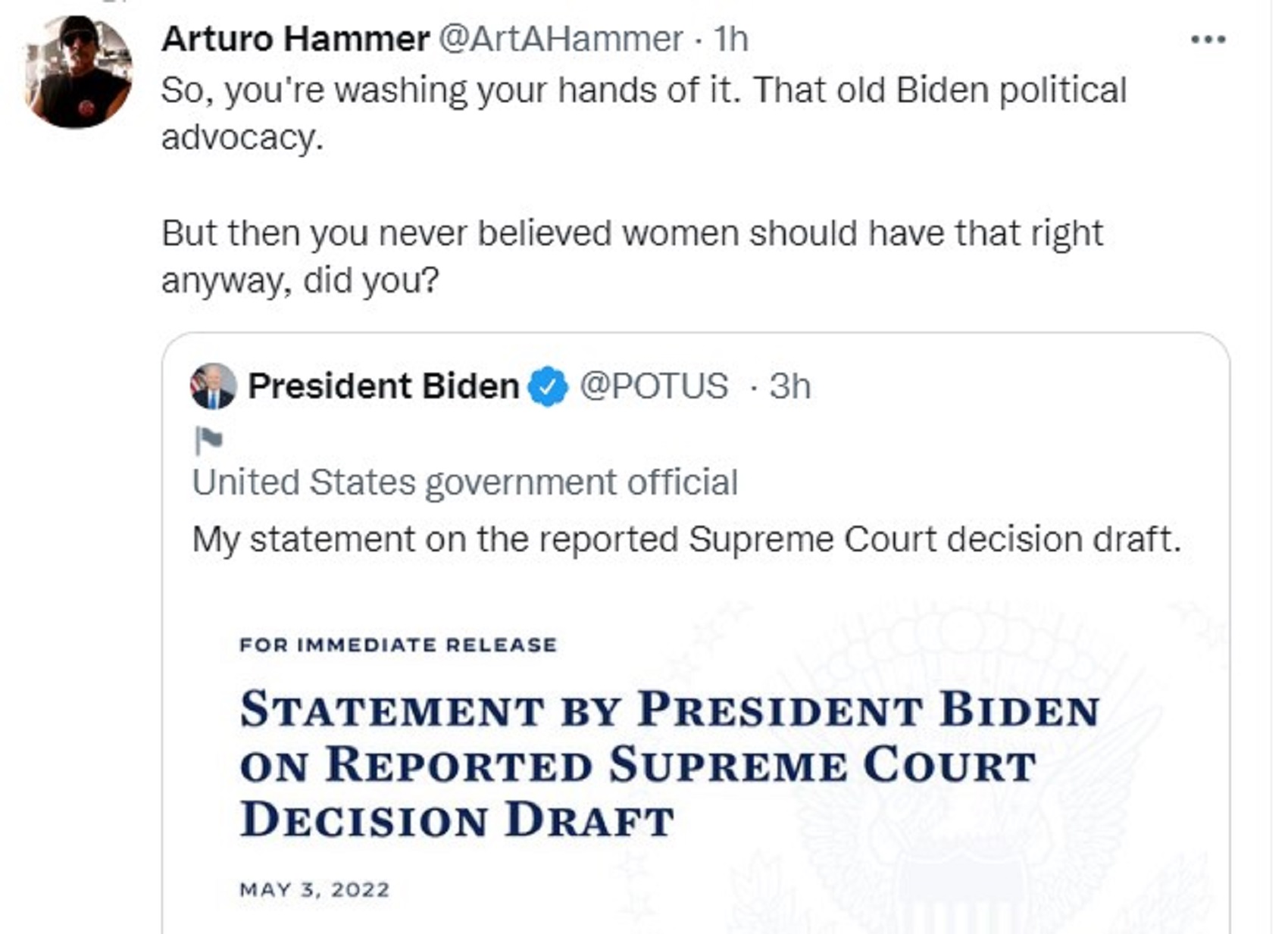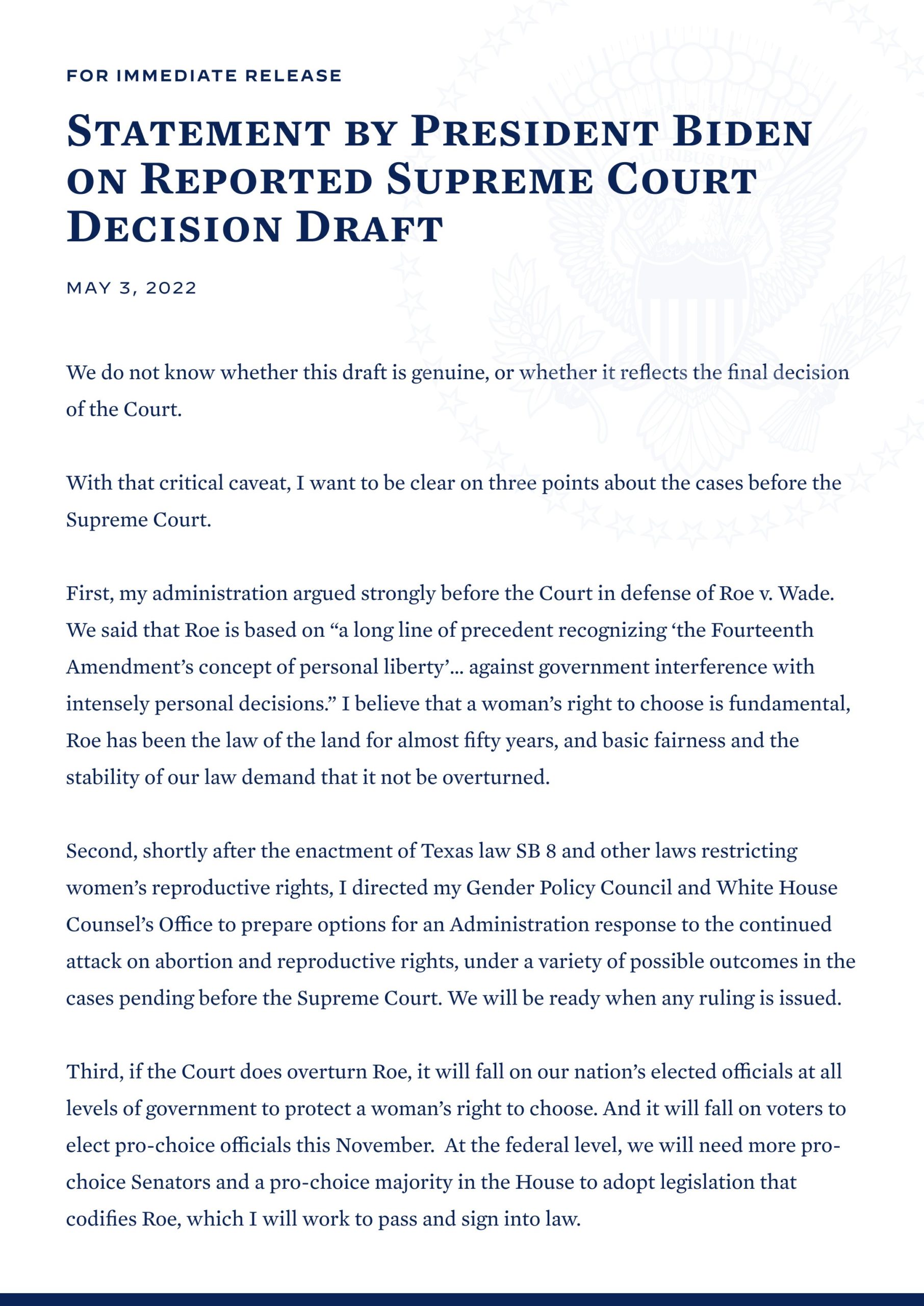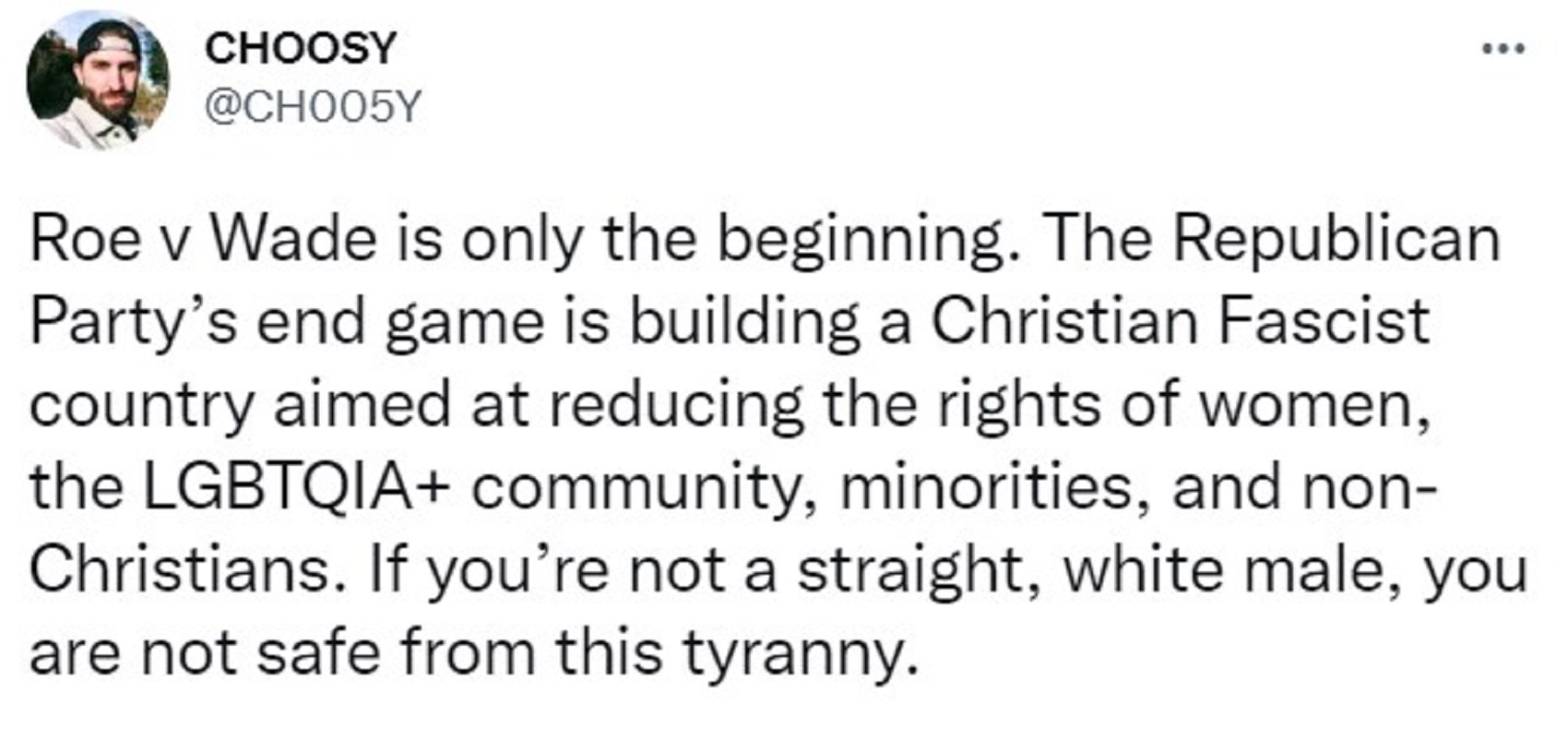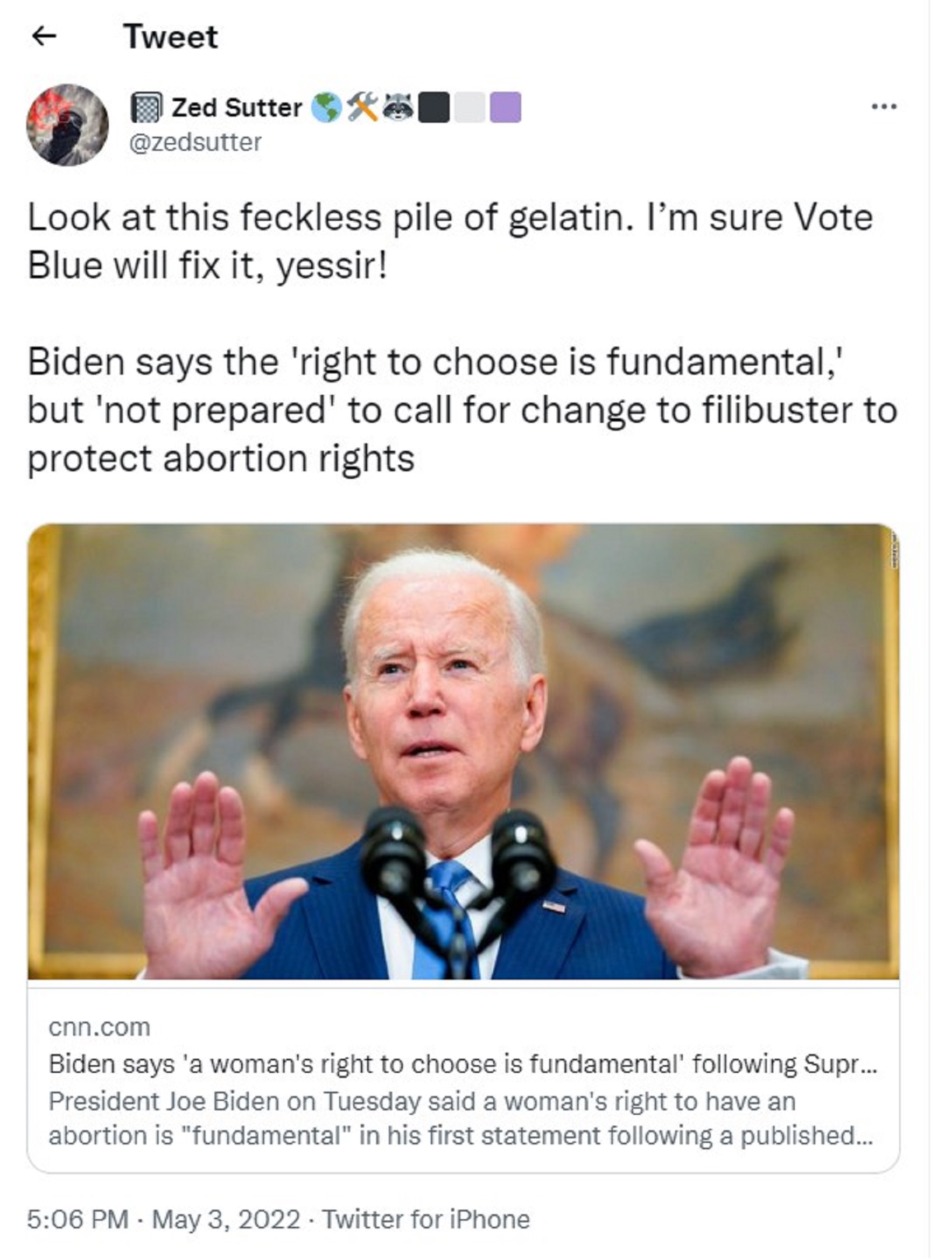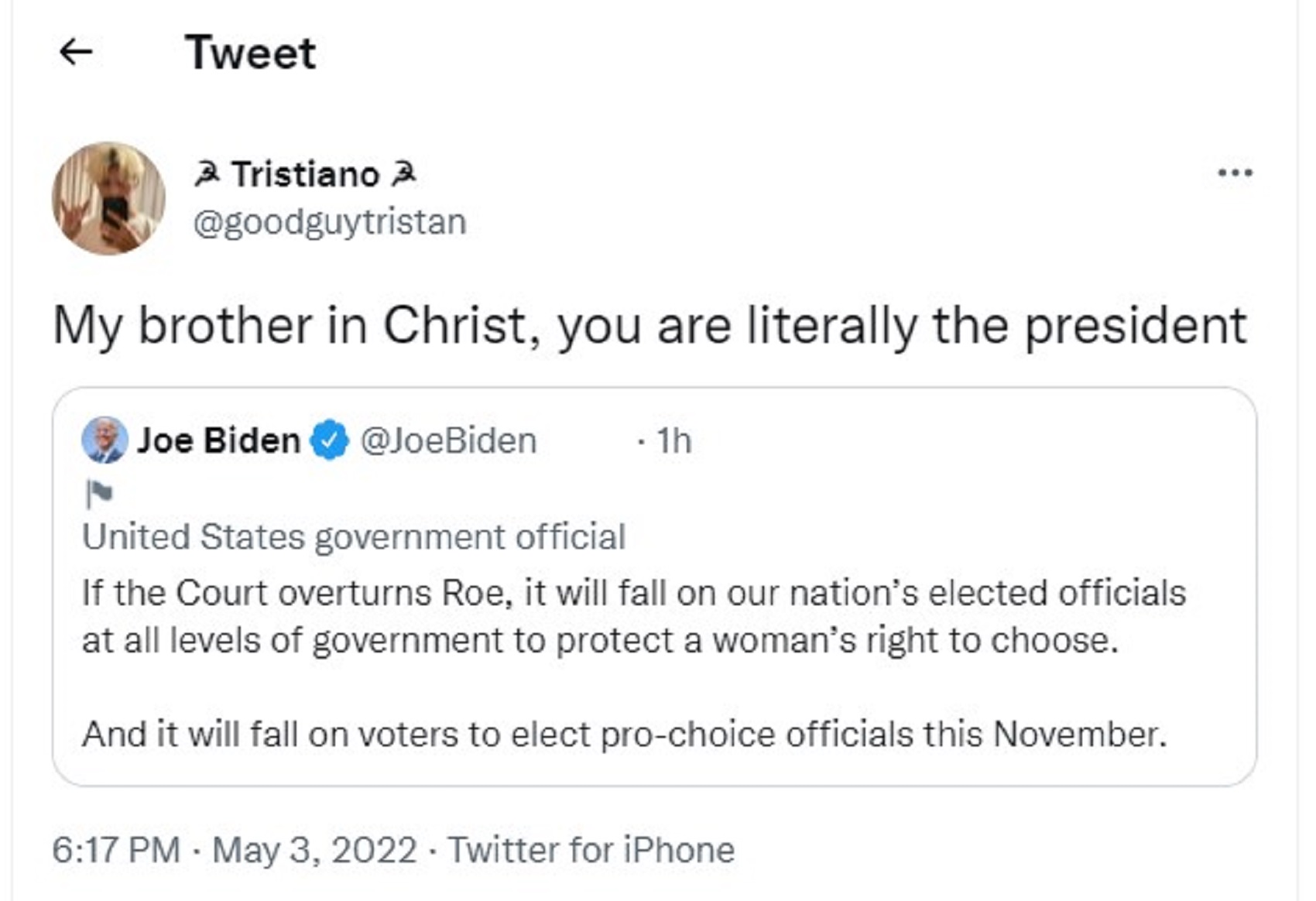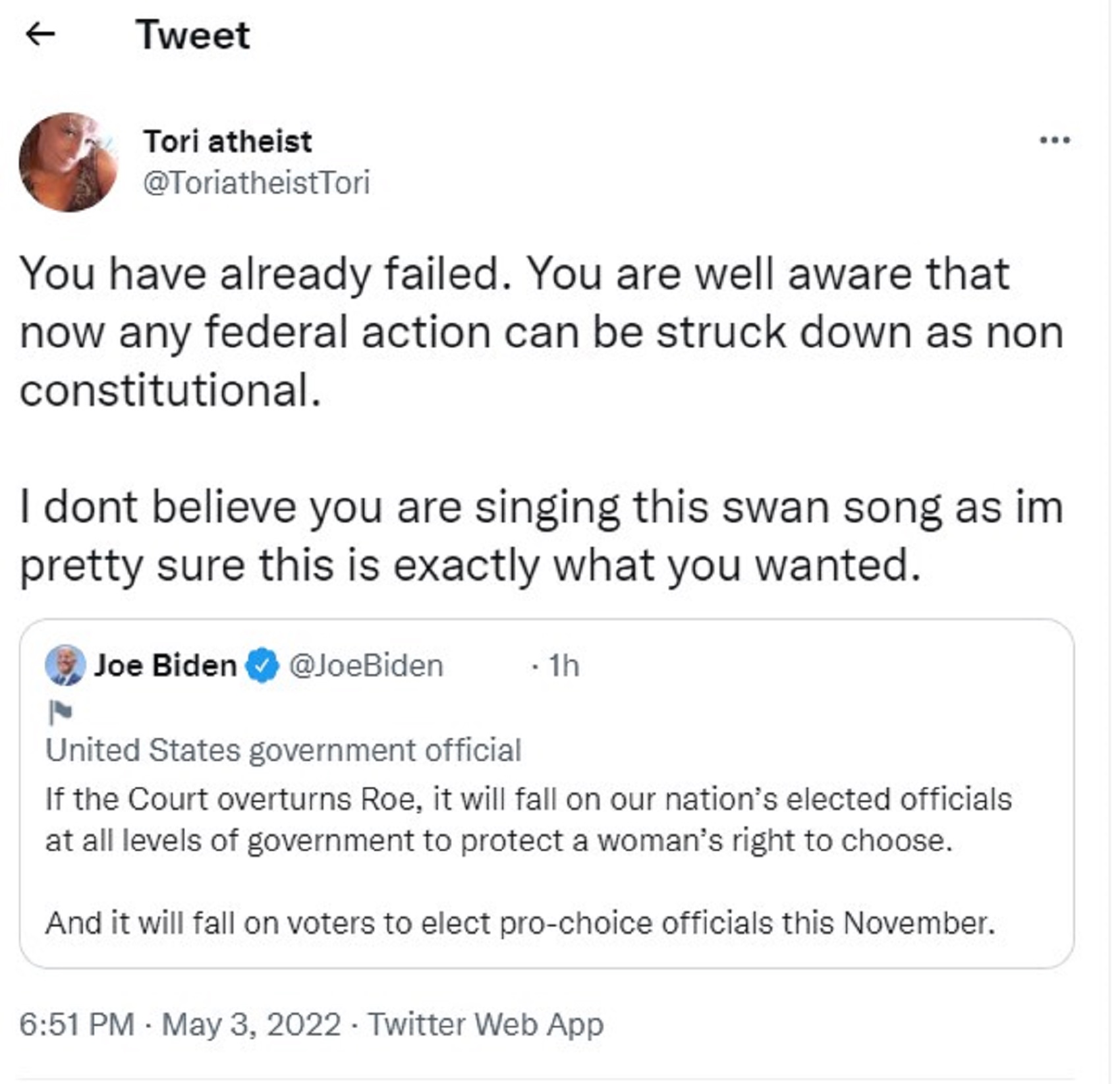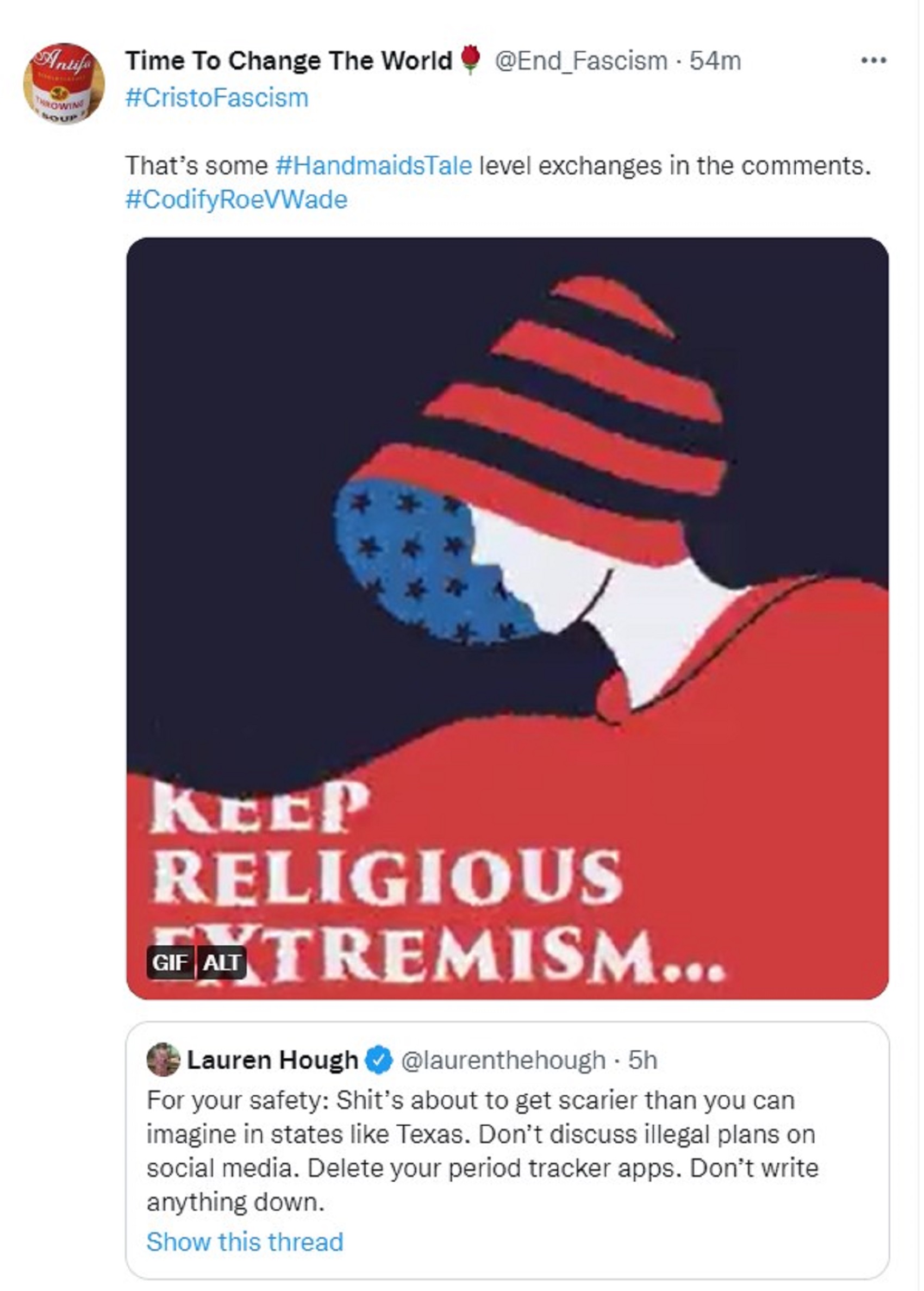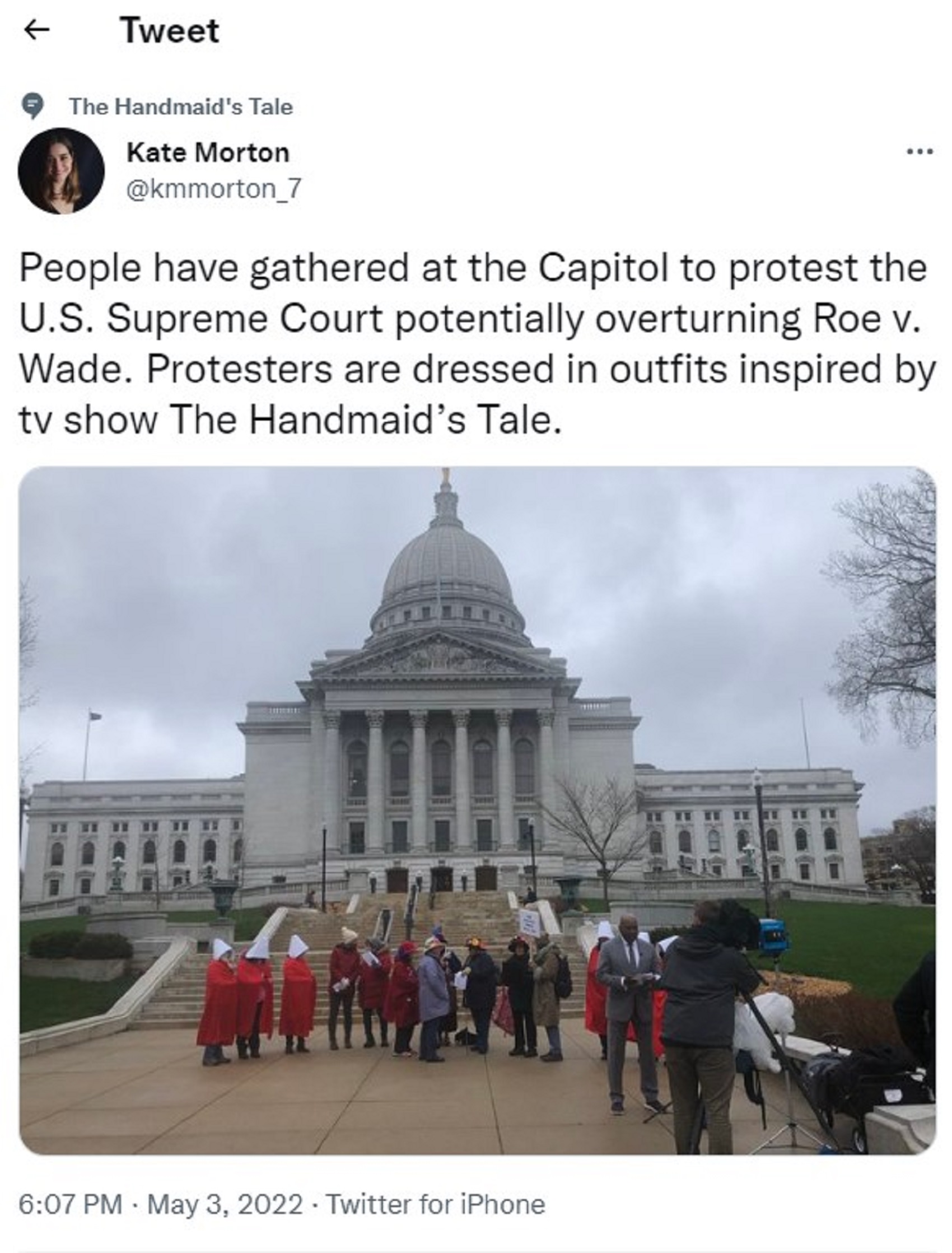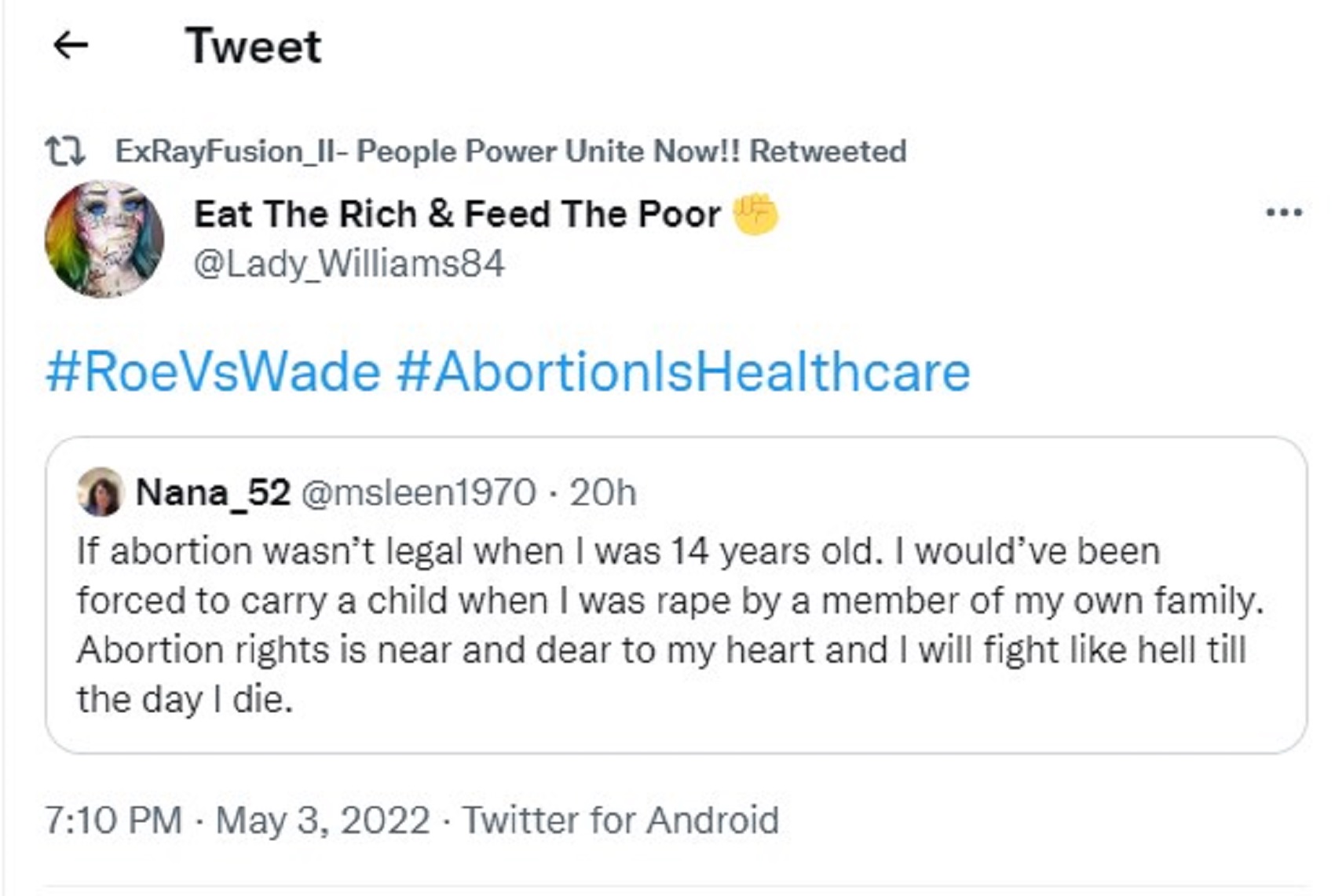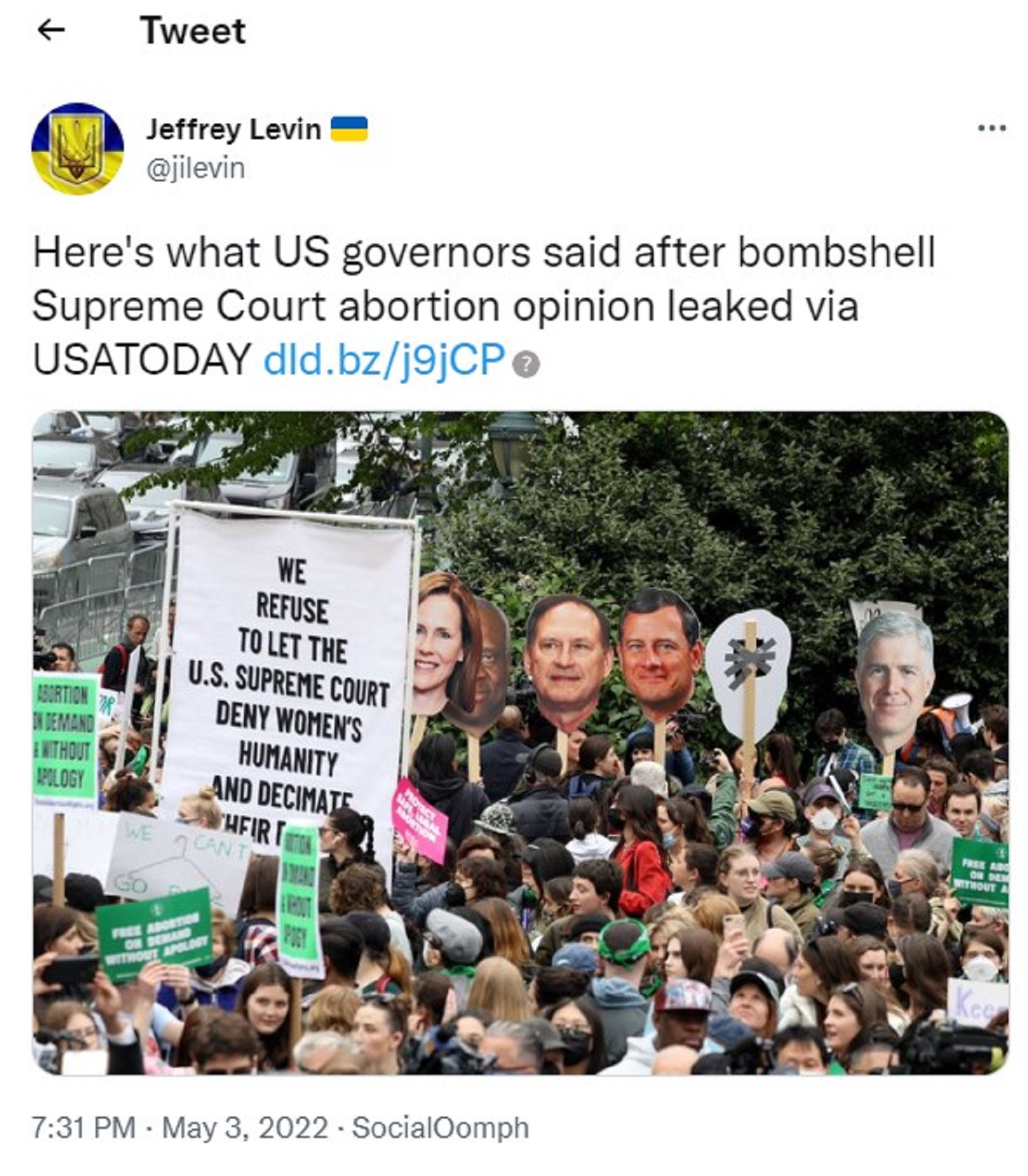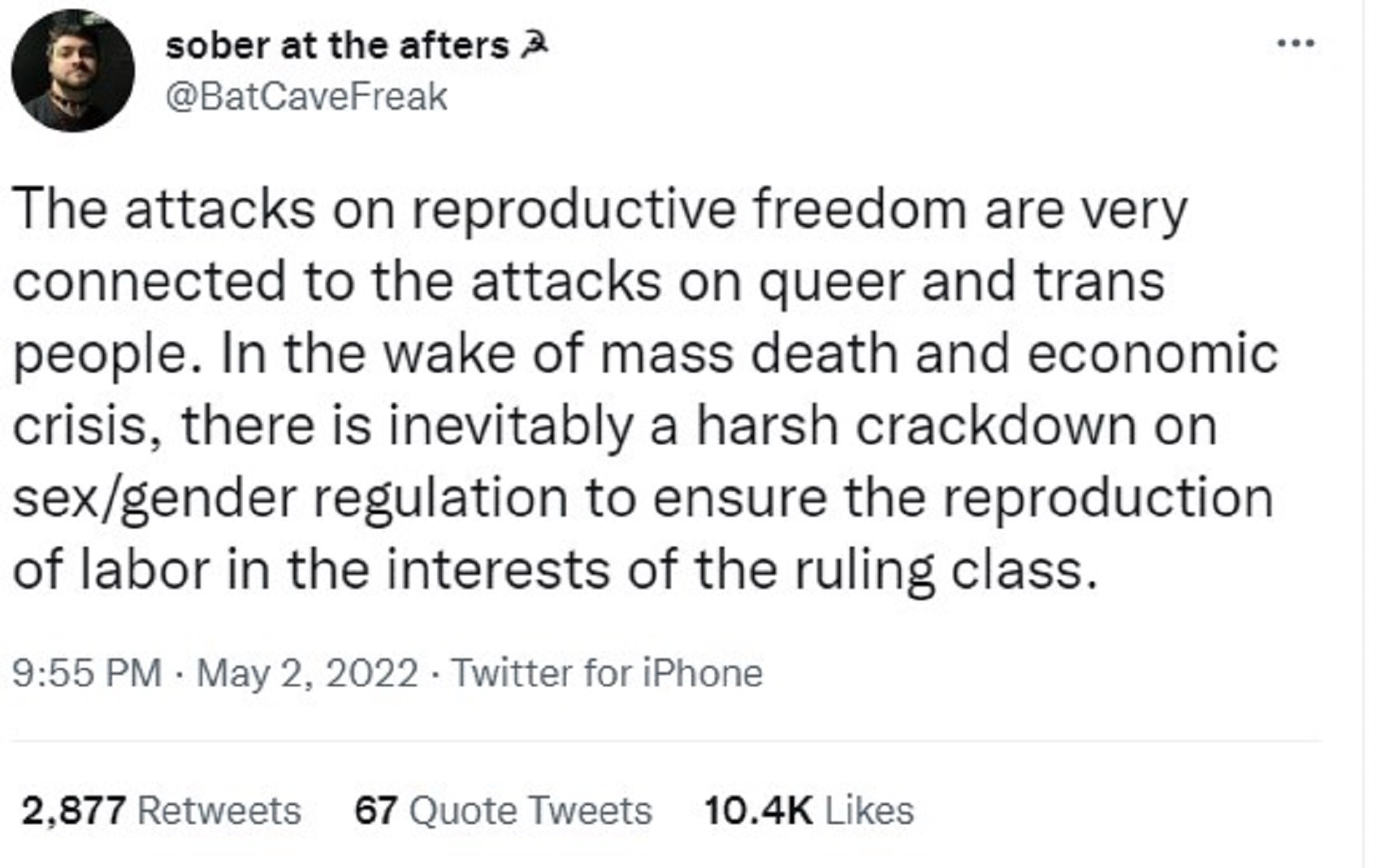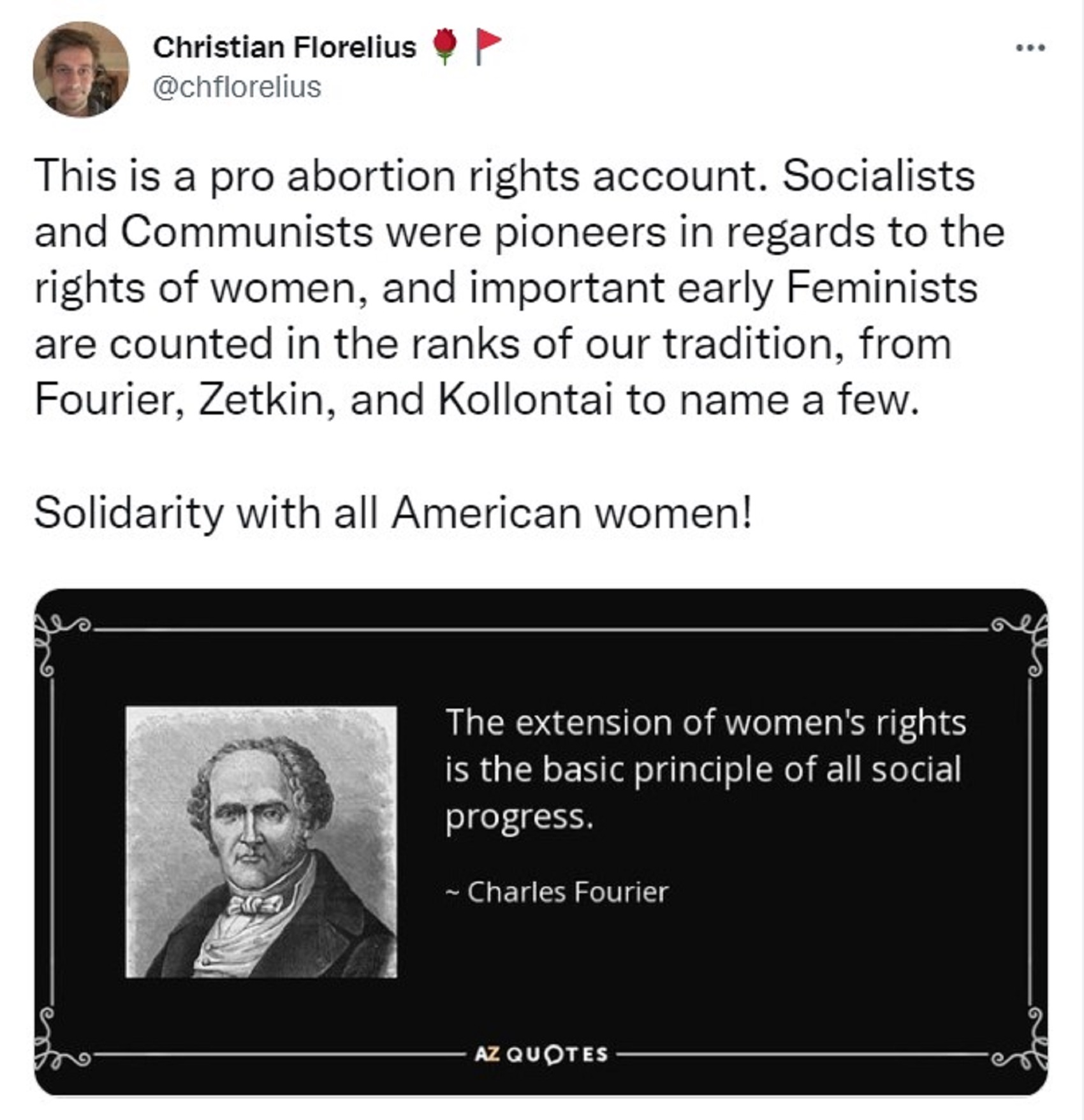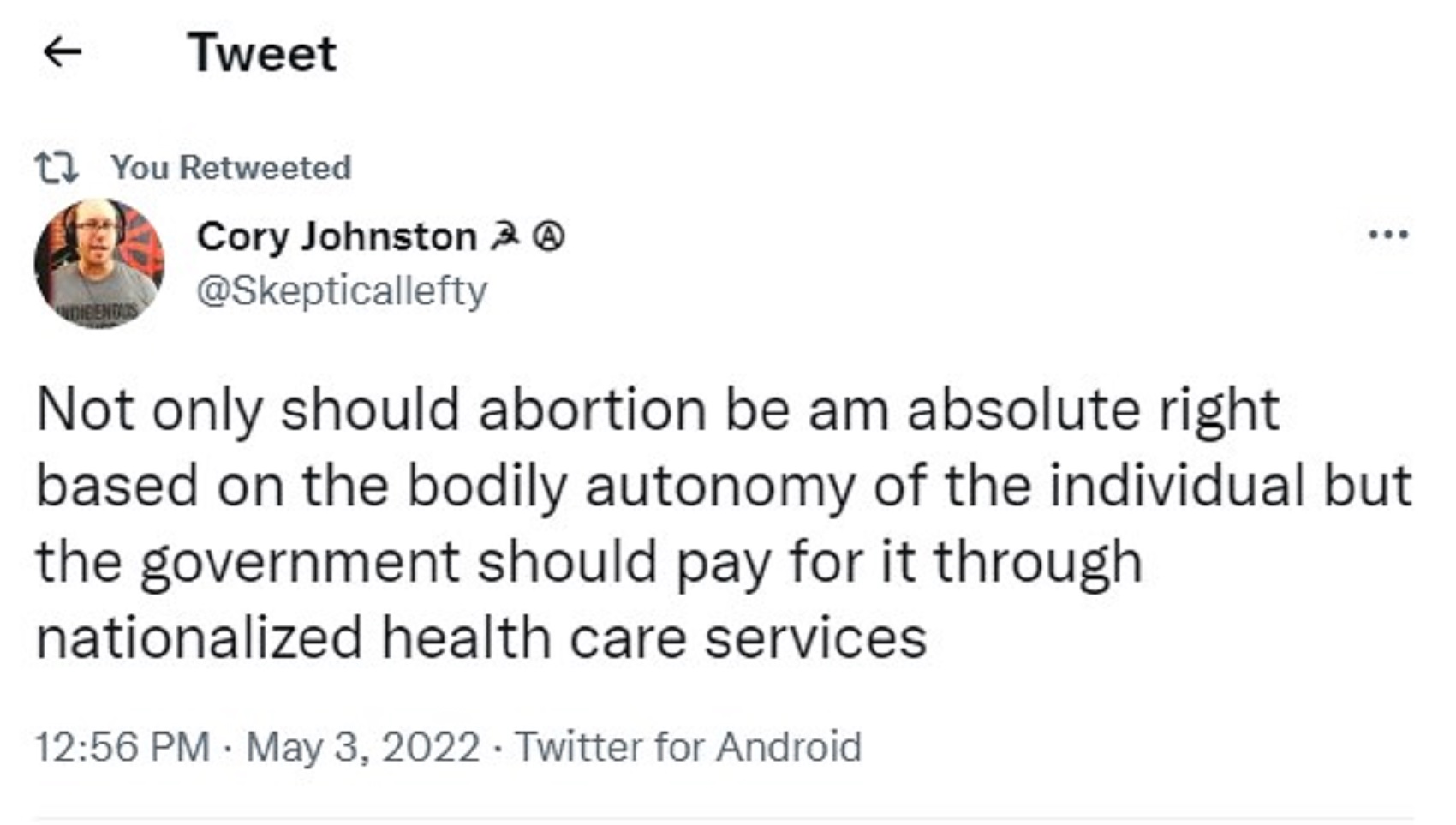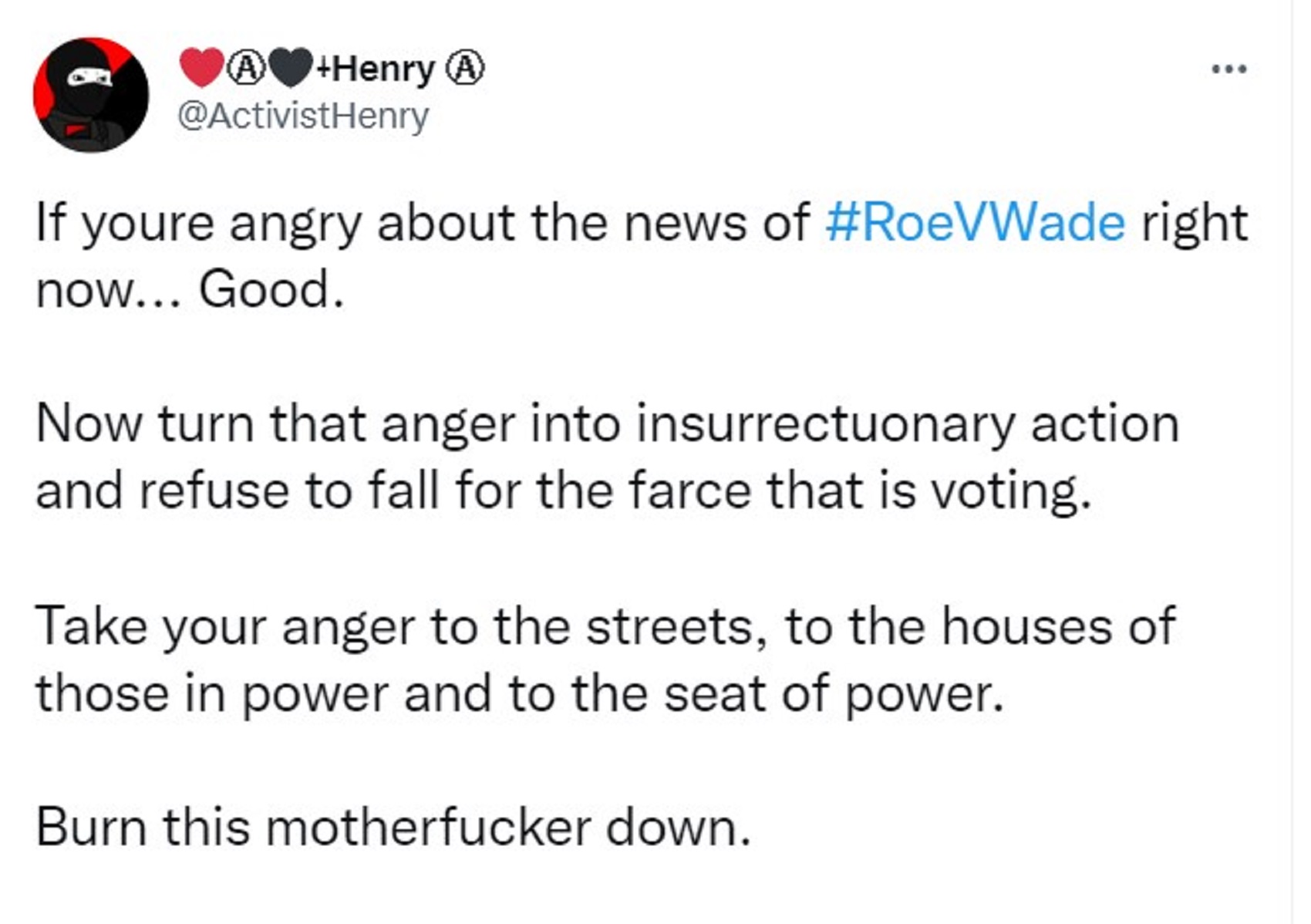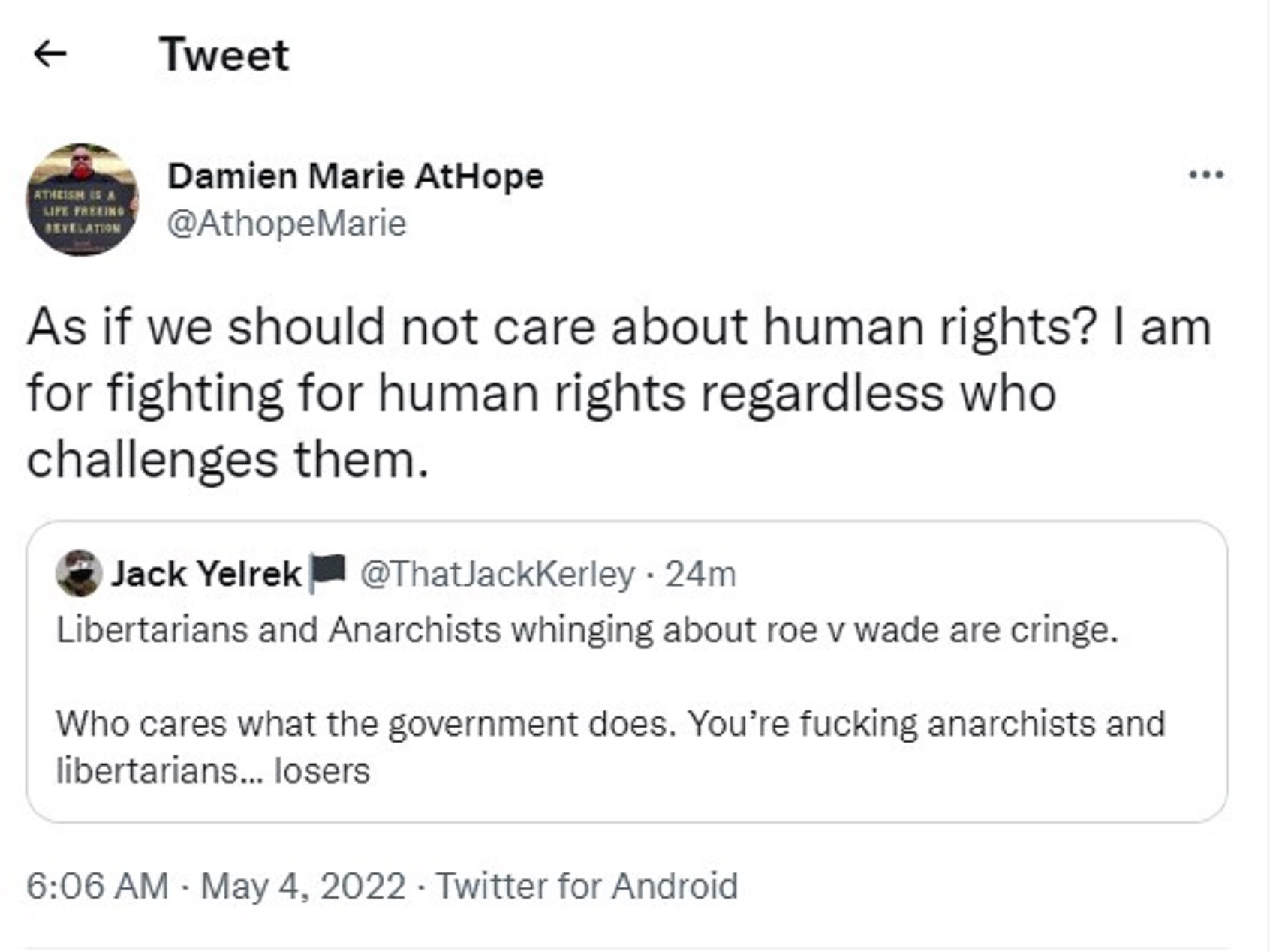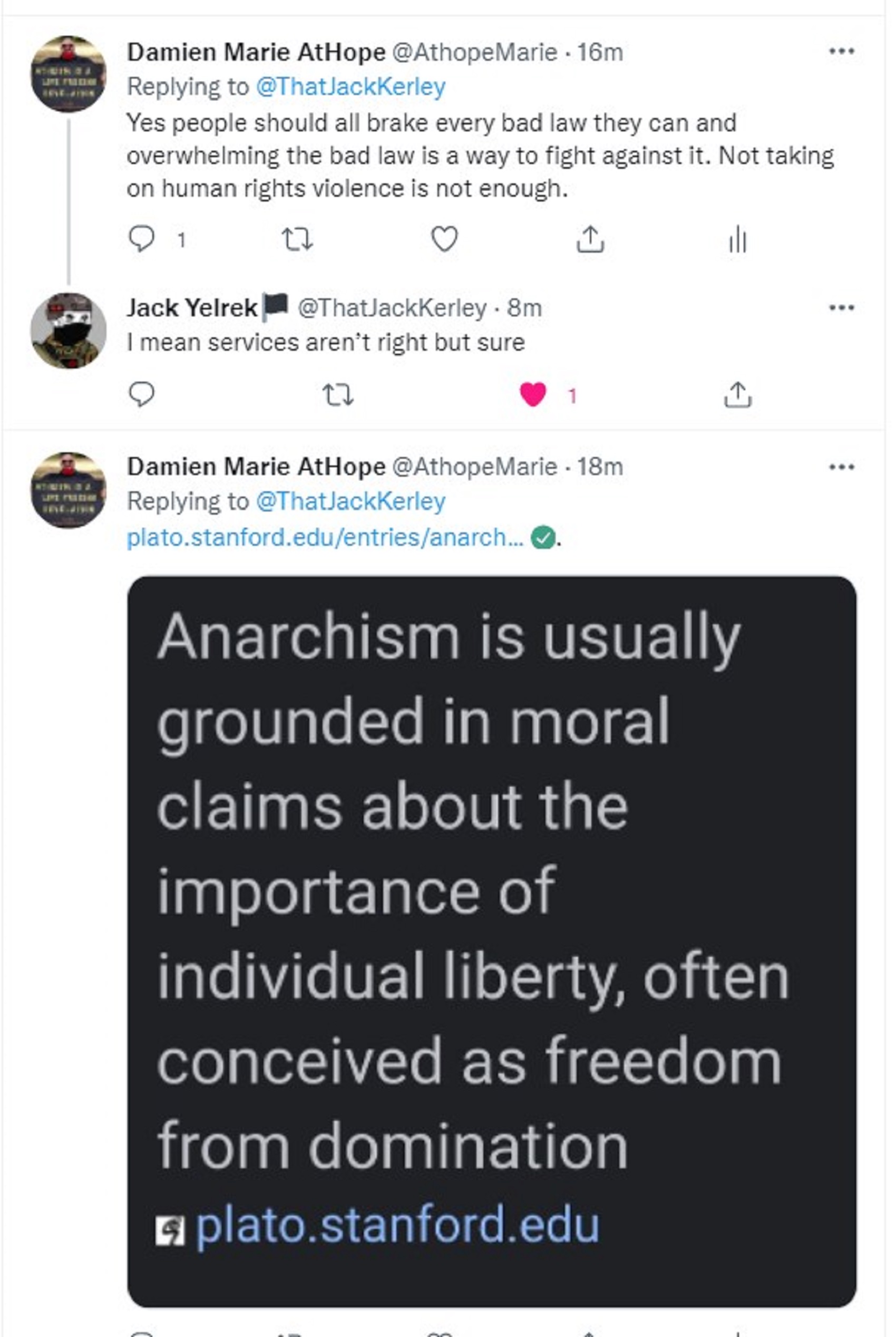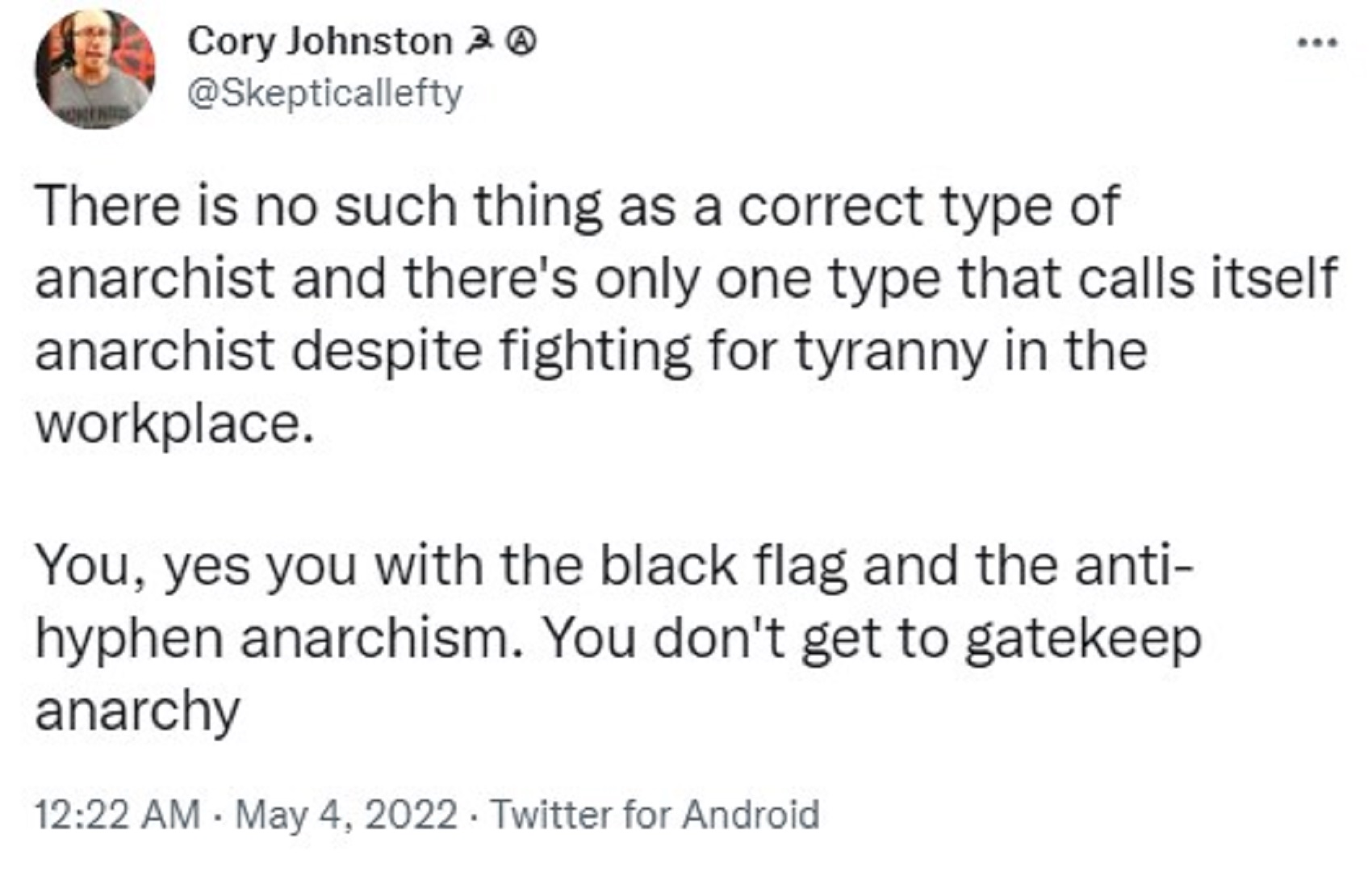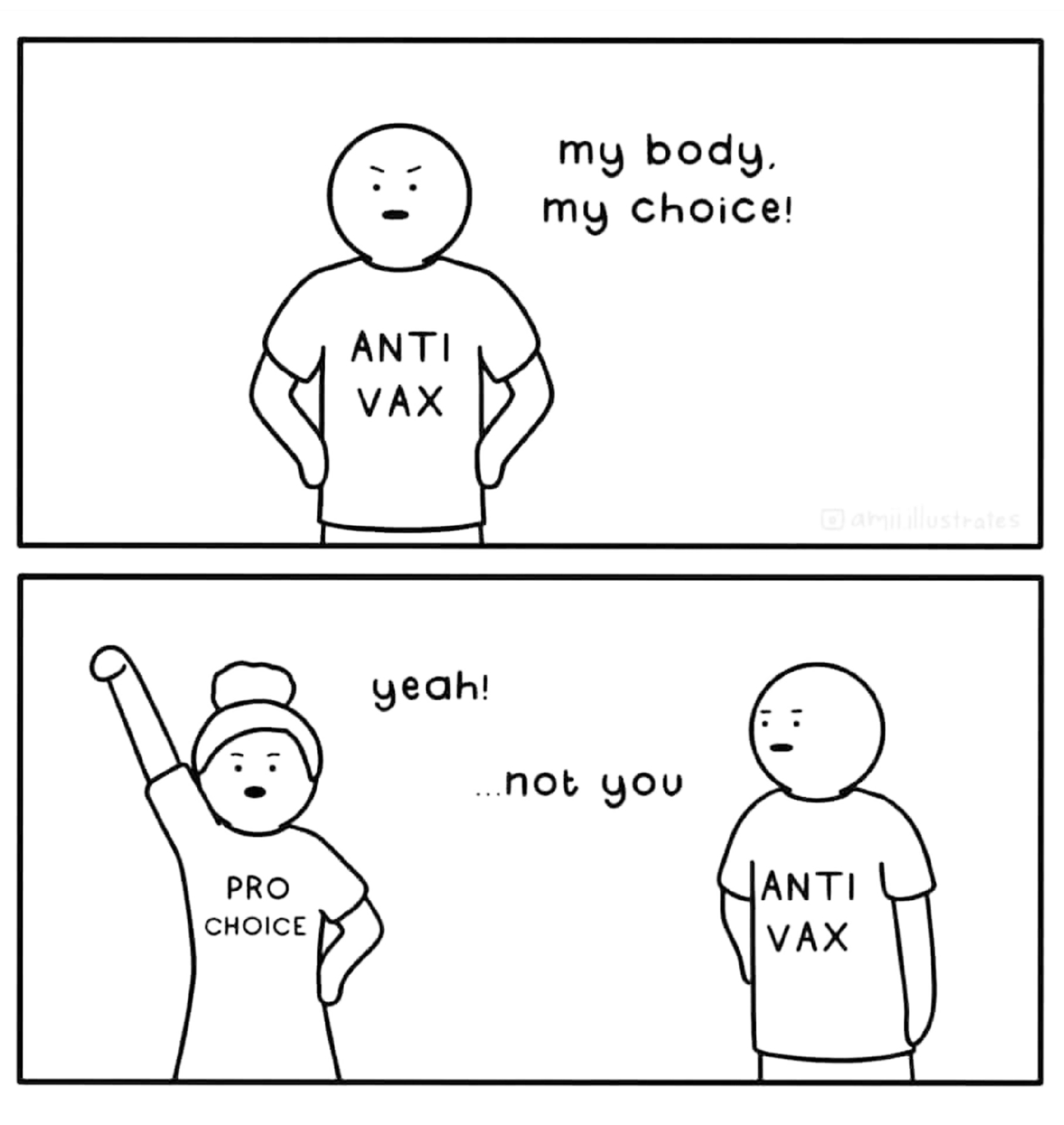
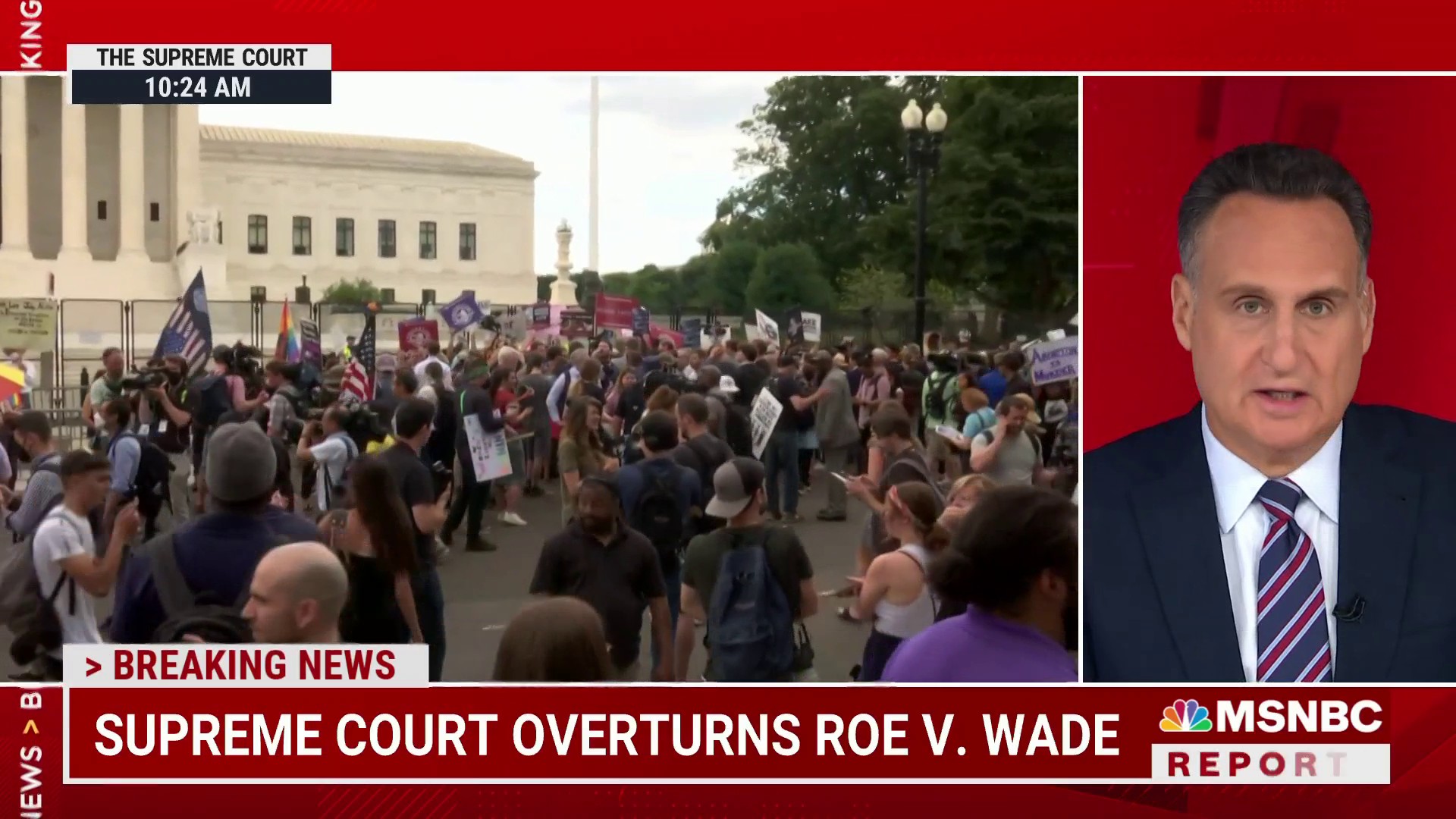
“US Supreme Court strikes down landmark abortion decision Roe v. Wade”
If you or someone you know needs an abortion, call 1-800-230-Plan or go to http://AbortionFinder.org
Jacqueline says Gay @KaoticLeftist· “This is really fucking bad in a solo opinion by Clarence Thomas “we should reconsider all of this Court’s substantive due process precedents, including Griswold, Lawrence, and Obergefell.” #AbolishSCOTUS” ref
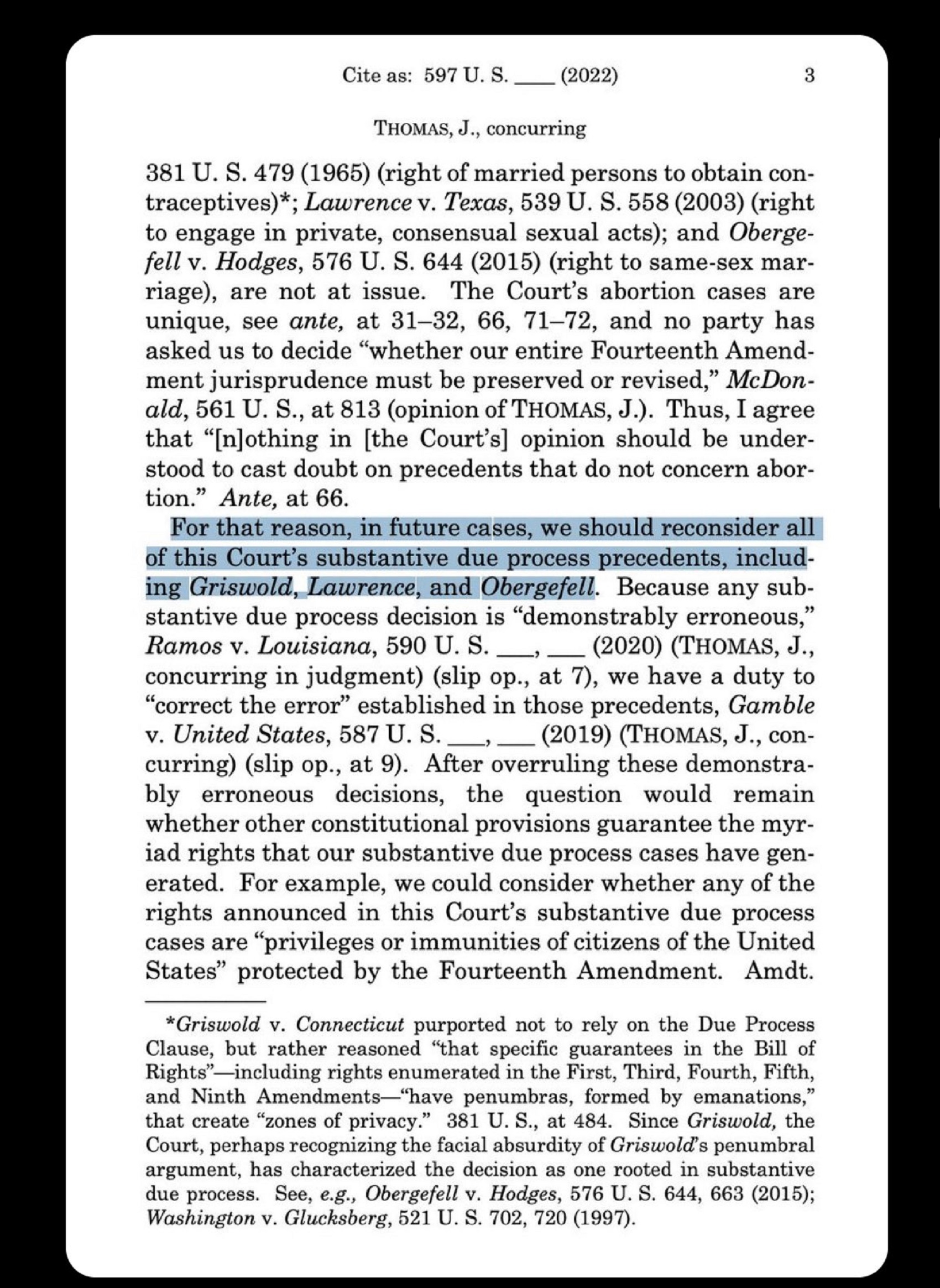
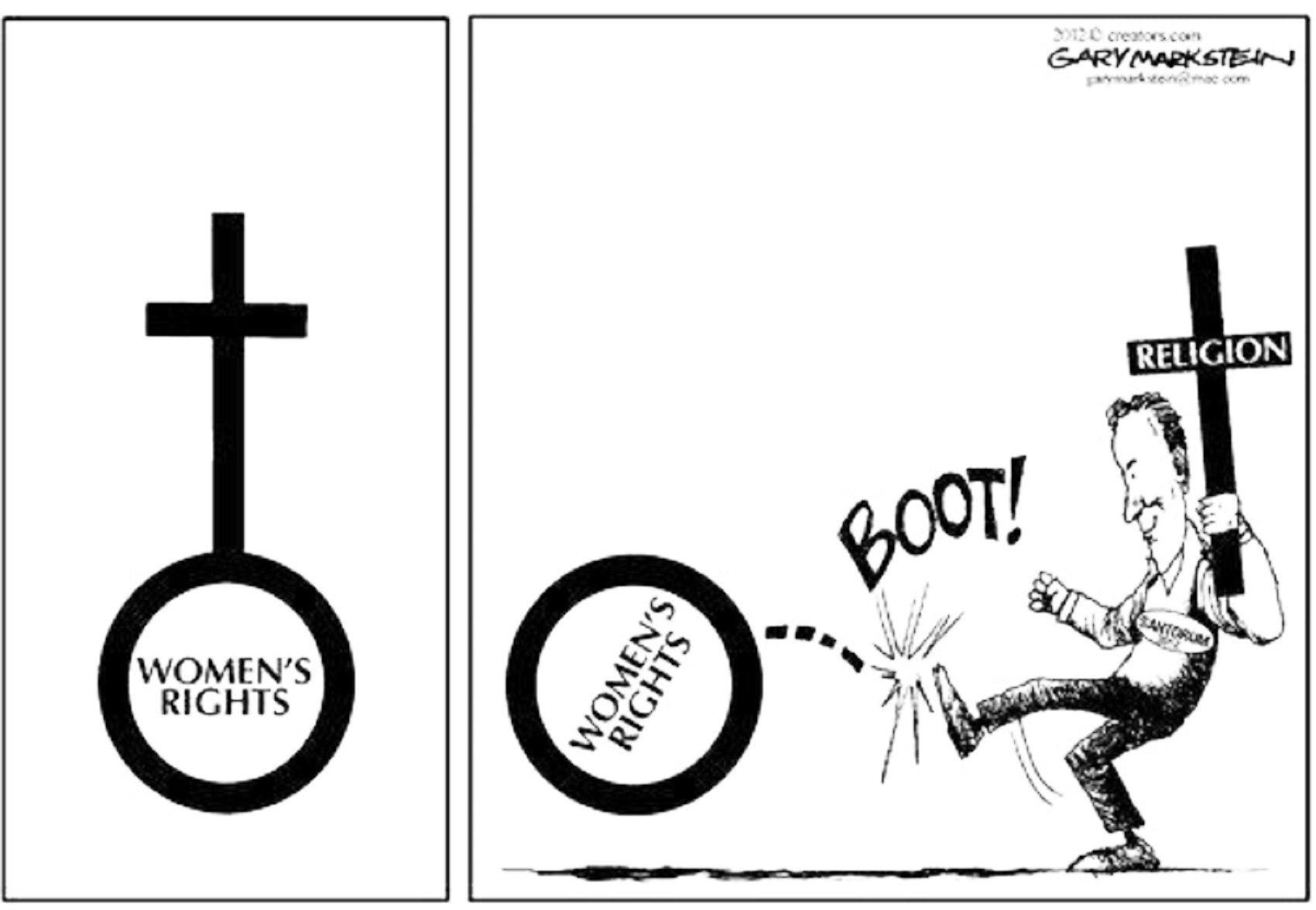
“Christian Nationalism”
“Christian nationalism is Christianity-affiliated religious nationalism. Christian nationalists primarily focus on internal politics, such as passing laws that reflect their view of Christianity and its role in political and social life. In countries with a state Church, Christian nationalists, in seeking to preserve the status of a Christian state, uphold an antidisestablishmentarian position. Christian nationalists have emphasized a recovery of territory in which Christianity formerly flourished, historically to establish a Pan-Christian state out of the countries within Christendom.” ref
“They actively promote religious (Christian) discourses in various fields of social life, from politics and history, to culture and science; with respect to legislation for example, Christian nationalists advocate blue laws. Christian nationalists have encouraged evangelism, as well as for families to have more children as a means of increasing the Christian population growth (cf. Quiverfull). Christian nationalists support the presence of Christian symbols and statuary in the public square, as well as state patronage for the display of religion, such as school prayer and the exhibition of nativity scenes during Christmastide or the Christian Cross on Good Friday.” ref
“Christian nationalists draw support from the broader Christian right. Christian nationalistic movements often have complex leadership structures, depending on the nature of their relationship with local Church institutions. Some movements are lay-oriented, with symbolic clerical participation and indirect support from local Church structures, while others are led or strongly influenced by local clergy. The involvement of clergy in various Christian nationalistic movements since the 19th century has led to the development of particular forms of Christian nationalism which are known as clerical nationalism (otherwise known as clero-nationalism or clerico-nationalism). Christian nationalists have often cooperated across denominational lines, fostering a spirit of ecumenism in order to advance certain objectives.” ref
“Christian nationalism in the United States manifests itself through the promotion of religious art and symbolism in the public square, such as the displaying of the Ten Commandments and the national motto “In God We Trust“, which came into force in order to distinguish the United States from the state atheism of the former Soviet Union. The Foundation for Moral Law, for example, was founded for this purpose. The ideology also advocates the view that public policy should be formed strictly by Christian beliefs, such as imposing legal restrictions against abortion. Christian nationalists support Sunday blue laws in keeping with traditional first-day Sabbatarian principles; the Lord’s Day Alliance (LDA) was organized by representatives of various Christian denominations to this end. In 2018, the Congressional Prayer Caucus Foundation began Project Blitz to achieve these goals.” ref
“The National Reform Association is an organization, founded in 1864 and active to this day, that seeks to introduce a Christian amendment to the Constitution of the United States. Advocacy groups, such as the Alliance Defending Freedom and First Liberty Institute, work to defend their view of the free exercise clause of the First Amendment. The Christian Liberty Party is a political party that sees the United States as a Christian country.” ref
“Christian nationalists believe that the US is meant to be a Christian nation and want to “take back” the US for God. Experts say that Christian-associated support for right-wing politicians and social policies, such as legislation related to immigration, gun control, and poverty is best understood as Christian nationalism, rather than as evangelicalism per se. Some studies of white evangelicals show that, among people who self-identify as evangelical Christians, the more they attend church, the more they pray, and the more they read the Bible, the less support they have for nationalist (though not socially conservative) policies. Non-nationalistic evangelicals agree ideologically with Christian nationalists in areas such as patriarchal policies, gender roles, and sexuality.” ref
“Andrew Whitehead and Samuel Perry summarize Christian nationalism with the following statements:
- The federal government should declare the United States a Christian nation.
- The federal government should advocate Christian values.
- The federal government should not enforce the strict separation of church and state.
- The federal government should allow religious symbols in public spaces.
- The success of the United States is part of God’s plan.
- The federal government should allow prayer in public schools.” ref
Blue Laws?
“Blue laws, also known as Sunday laws, Sunday trade laws, and Sunday closing laws, are laws restricting or banning certain activities on specified days, usually Sundays in the western world. The laws were adopted originally for religious reasons, specifically to promote the observance of the Christian day of worship, but since then have come to serve secular purposes as well.” ref
“Blue laws commonly ban certain business and recreational activities on Sundays and impose restrictions on the retail sale of hard goods and consumables, particularly alcoholic beverages. The laws also place limitations on a range of other endeavors, including travel, fashions, hunting, professional sports, stage performances, movie showings, and gambling. While less prevalent today, blue laws continue to be enforced in parts of the United States and Canada as well as in European countries, such as Austria, Germany, Norway, and Poland, where most stores are required to close on Sundays.” ref
“In the United States, the Supreme Court has upheld blue laws as constitutional, recognizing their religious origins but citing secular justifications that have resulted, most notably the provision of a day of rest for the general population. Meanwhile, various state courts have struck down the laws as either unenforceable or in violation of their states’ constitutions. In response, state legislators have re-enacted certain Sunday laws to satisfy the rulings while allowing some of the other statutes to remain on the books with no intention to enforce them.” ref
Christian Fascism “Christofascism”
“Christian fascism denotes the intersection between fascism and Christianity and it also encompasses the fascistic, totalitarian, and imperialistic aspects of the Christian Church. It is sometimes referred to as “Christofascism“, a neologism coined by liberation theologist Dorothee Sölle in 1970.” ref
“Tom F. Driver, the Paul Tillich Professor Emeritus at Union Theological Seminary, expressed concern “that the worship of God in Christ not divide Christian from Jew, man from woman, clergy from laity, white from black, or rich from poor”. To him, Christianity is in constant danger of Christofascism, stating that “[w]e fear christofascism, which we see as the political direction of all attempts to place Christ at the center of social life and history” and that “[m]uch of the churches’ teaching about Christ has turned into something that is dictatorial in its heart and is preparing society for an American fascism.” ref
“Christofascism “disposed or allowed Christians, to impose themselves not only upon other religions but other cultures, and political parties which do not march under the banner of the final, normative, victorious Christ” – as Paul F. Knitter describes Sölle’s view. George Hunsinger, director of the Centre for Barth Studies at Princeton Theological Seminary, regards the conception of Christofascism as being an attack, at a very sophisticated level of theological discourse, on the biblical depiction of Jesus. He equates what is viewed as Christofascism with “Jesus Christ as depicted in Scripture” and contrasts it with the “nonnormative Christology” that is offered as an alternative by some theologians, which he characterizes as extreme relativism that reduces Jesus Christ to “an object of mere personal preference and cultural location” and that he finds difficult to see as not contributing to the same problems encountered by the Christian church in Germany that were noted by theologian Karl Barth.” ref
“Douglas John Hall, Professor of Christian Theology at McGill University, relates Sölle’s concept of Christofascism to Christomonism, which inevitably ends in religious triumphalism and exclusivity, noting Sölle’s observation of American fundamentalist Christianity that Christomonism easily leads to Christofascism, and violence is never far away from militant Christomonism. (Christomonism only accepts one divine person, Jesus Christ, rather than the Trinity.) He states that the over-divinized (“high”) Christology of Christendom is demonstrated to be wrong by its “almost unrelieved anti-Judaism“. He suggests that the best way to guard against this is for Christians not to neglect the humanity of Jesus Christ in favor of his divinity, and remind themselves that Jesus was also a Jewish human being.” ref
“Chris Hedges and David Neiwert contend that the origins of American Christofascism date back to the Great Depression, when Americans first espoused forms of fascism that were “explicitly ‘Christian’ in nature”. Hedges writes that “fundamentalist preachers such as Gerald B. Winrod and Gerald L. K. Smith fused national and Christian symbols to advocate the country’s first crude form of Christo-fascism”. Smith’s Christian Nationalist Crusade stated that a “Christian character is the basis of all real Americanism”. Hedges also believes that William Dudley Pelley was another prominent advocate of Christofascism. Nonetheless, some historians contend the presence of Christian fascism in the Antebellum United States.” ref
“By the late 1950s, adherents of these philosophies founded the John Birch Society, whose policy positions and rhetoric have greatly influenced modern dominionists. Likewise, the Posse Comitatus movement was founded by former associates of Pelley and Smith. The 1980s saw the founding of the Council for National Policy and the Moral Majority carry on the tradition, while the patriot and militia movements represented efforts to mainstream the philosophy in the 1990s.” ref
“Incidents of anti-abortion violence, including the Atlanta and Birmingham bombings which were committed by Eric Rudolph and the assassination of George Tiller at his Wichita, Kansas church in 2009, have also been considered acts which were motivated by Christofascism. The term caused controversy in 2007, when Melissa McEwan, a campaign blogger for then-presidential candidate John Edwards, referred to religious conservatives as “Christofascists” on her personal blog.” ref
Supreme Court of the United States (SCOTUS)
“The Supreme Court of the United States (SCOTUS) is the highest court in the federal judiciary of the United States. It has ultimate and largely discretionary appellate jurisdiction over all federal and state court cases that involve a point of federal law, and original jurisdiction over a narrow range of cases, specifically “all Cases affecting Ambassadors, other public Ministers and Consuls, and those in which a State shall be Party.” The court holds the power of judicial review, the ability to invalidate a statute for violating a provision of the Constitution. It is also able to strike down presidential directives for violating either the Constitution or statutory law. However, it may act only within the context of a case in an area of law over which it has jurisdiction. The court may decide cases having political overtones but has ruled that it does not have power to decide non-justiciable political questions.” ref
The Supreme Court has been the object of criticisms and controversies on a range of issues. Among them:
Judicial activism
“The Supreme Court has been criticized for not keeping within Constitutional bounds by engaging in judicial activism, rather than merely interpreting law and exercising judicial restraint. Claims of judicial activism are not confined to any particular ideology. An often cited example of conservative judicial activism is the 1905 decision in Lochner v. New York, which has been criticized by many prominent thinkers, including Robert Bork, Justice Antonin Scalia, and Chief Justice John Roberts, and which was reversed in the 1930s.” ref
“An often-cited example of liberal judicial activism is Roe v. Wade (1973), which legalized abortion on the basis of the “right to privacy” inferred from the Fourteenth Amendment, a reasoning that some critics argued was circuitous. Legal scholars, justices, and presidential candidates have criticized the Roe decision. The progressive Brown v. Board of Education decision banning racial segregation in public schools has been criticized by conservatives such as Patrick Buchanan, former associate justice nominee and solicitor general Robert Bork, and former presidential contender Barry Goldwater.” ref
“More recently, Citizens United v. Federal Election Commission was criticized for expanding upon the precedent in First National Bank of Boston v. Bellotti (1978) that the First Amendment applies to corporations, including campaign spending. President Abraham Lincoln warned, referring to the Dred Scott decision, that if government policy became “irrevocably fixed by decisions of the Supreme Court…the people will have ceased to be their own rulers.” Former justice Thurgood Marshall justified judicial activism with these words: “You do what you think is right and let the law catch up.” ref
“During different historical periods, the court has leaned in different directions. Critics from both sides complain that activist judges abandon the Constitution and substitute their own views instead. Critics include writers such as Andrew Napolitano, Phyllis Schlafly, Mark R. Levin, Mark I. Sutherland, and James MacGregor Burns. Past presidents from both parties have attacked judicial activism, including Franklin D. Roosevelt, Richard Nixon, and Ronald Reagan. Failed Supreme Court nominee Robert Bork wrote: “What judges have wrought is a coup d’état,– slow-moving and genteel, but a coup d’état nonetheless.” Brian Leiter wrote that “Given the complexity of the law and the complexity involved in saying what really happened in a given dispute, all judges, and especially those on the Supreme Court, often have to exercise a quasi-legislative power,” and “Supreme Court nominations are controversial because the court is a super-legislature, and because its moral and political judgments are controversial.” ref
Individual rights
“Court decisions have been criticized for failing to protect individual rights: the Dred Scott (1857) decision upheld slavery; Plessy v. Ferguson (1896) upheld segregation under the doctrine of separate but equal; Kelo v. City of New London (2005) was criticized by prominent politicians, including New Jersey governor Jon Corzine, as undermining property rights. Some critics suggest the 2009 bench with a conservative majority has “become increasingly hostile to voters” by siding with Indiana’s voter identification laws which tend to “disenfranchise large numbers of people without driver’s licenses, especially poor and minority voters”, according to one report. Senator Al Franken criticized the court for “eroding individual rights.” However, others argue that the court is too protective of some individual rights, particularly those of people accused of crimes or in detention. For example, Chief Justice Warren Burger was an outspoken critic of the exclusionary rule, and Justice Scalia criticized the court’s decision in Boumediene v. Bush for being too protective of the rights of Guantanamo detainees, on the grounds that habeas corpus was “limited” to sovereign territory.” ref
Power excess
“This criticism is related to complaints about judicial activism. George Will wrote that the court has an “increasingly central role in American governance.” It was criticized for intervening in bankruptcy proceedings regarding ailing carmaker Chrysler Corporation in 2009. A reporter wrote that “Justice Ruth Bader Ginsburg’s intervention in the Chrysler bankruptcy” left open the “possibility of further judicial review” but argued overall that the intervention was a proper use of Supreme Court power to check the executive branch. Warren E. Burger, before becoming Chief Justice, argued that since the Supreme Court has such “unreviewable power”, it is likely to “self-indulge itself”, and unlikely to “engage in dispassionate analysis.” Larry Sabato wrote “excessive authority has accrued to the federal courts, especially the Supreme Court.” ref
Courts are a poor check on executive power
“British constitutional scholar Adam Tomkins sees flaws in the American system of having courts (and specifically the Supreme Court) act as checks on the Executive and Legislative branches; he argues that because the courts must wait, sometimes for years, for cases to navigate their way through the system, their ability to restrain other branches is severely weakened. In contrast, various other countries have a dedicated constitutional court that has original jurisdiction on constitutional claims brought by persons or political institutions; for example, the Federal Constitutional Court of Germany, which can declare a law unconstitutional when challenged.” ref
Federal versus state power
“There has been debate throughout American history about the boundary between federal and state power. While Framers such as James Madison and Alexander Hamilton argued in The Federalist Papers that their then-proposed Constitution would not infringe on the power of state governments, others argue that expansive federal power is good and consistent with the Framers’ wishes. The Tenth Amendment to the United States Constitution explicitly grants “powers not delegated to the United States by the Constitution, nor prohibited by it to the States, are reserved to the States respectively, or to the people.” ref
“The court has been criticized for giving the federal government too much power to interfere with state authority. One criticism is that it has allowed the federal government to misuse the Commerce Clause by upholding regulations and legislation which have little to do with interstate commerce, but that were enacted under the guise of regulating interstate commerce; and by voiding state legislation for allegedly interfering with interstate commerce. For example, the Commerce Clause was used by the Fifth Circuit Court of Appeals to uphold the Endangered Species Act, thus protecting six endemic species of insect near Austin, Texas, despite the fact that the insects had no commercial value and did not travel across state lines; the Supreme Court let that ruling stand without comment in 2005. Chief Justice John Marshall asserted Congress’s power over interstate commerce was “complete in itself, may be exercised to its utmost extent, and acknowledges no limitations, other than are prescribed in the Constitution.” Justice Alito said congressional authority under the Commerce Clause is “quite broad”;[260] modern-day theorist Robert B. Reich suggests debate over the Commerce Clause continues today.” ref
“Advocates of states’ rights such as constitutional scholar Kevin Gutzman have also criticized the court, saying it has misused the Fourteenth Amendment to undermine state authority. Justice Brandeis, in arguing for allowing the states to operate without federal interference, suggested that states should be laboratories of democracy. One critic wrote “the great majority of Supreme Court rulings of unconstitutionality involve state, not federal, law.” Others see the Fourteenth Amendment as a positive force that extends “protection of those rights and guarantees to the state level.” More recently, the issue of federal power is central in the prosecution of Gamble v. United States, which is examining the doctrine of “separate sovereigns”, whereby a criminal defendant can be prosecuted by a state court and then by a federal court.” ref
Secretive proceedings
“The court has been criticized for keeping its deliberations hidden from public view. According to a review of Jeffrey Toobin‘s 2007 expose The Nine: Inside the Secret World of the Supreme Court; “Its inner workings are difficult for reporters to cover, like a closed ‘cartel’, only revealing itself through ‘public events and printed releases, with nothing about its inner workings.'” The reviewer writes: “few (reporters) dig deeply into court affairs. It all works very neatly; the only ones hurt are the American people, who know little about nine individuals with enormous power over their lives.” Larry Sabato complains about the court’s “insularity”; a Fairleigh Dickinson University poll conducted in 2010 found that 61% of American voters agreed that televising Court hearings would “be good for democracy”, and 50% of voters stated they would watch Court proceedings if they were televised. More recently, several justices have appeared on television, written books, and made public statements to journalists. In a 2009 interview on C-SPAN, journalists Joan Biskupic of USA Today and Lyle Denniston of SCOTUSblog argued that the court is a “very open” institution with only the justices’ private conferences inaccessible to others. In October 2010, the court began the practice of posting on its website recordings and transcripts of oral arguments on the Friday after they occur.” ref
Judicial interference in political disputes
“Some Court decisions have been criticized for injecting the court into the political arena, and deciding questions that are the purview of the other two branches of government. The Bush v. Gore decision, in which the Supreme Court intervened in the 2000 presidential election and effectively chose George W. Bush over Al Gore, has been criticized extensively, particularly by liberals. Another example are Court decisions on apportionment and re-districting: in Baker v. Carr, the court decided it could rule on apportionment questions; Justice Frankfurter in a “scathing dissent” argued against the court wading into so-called political questions.” ref
Not choosing enough cases to review
“Senator Arlen Specter said the court should “decide more cases”; on the other hand, although Justice Scalia acknowledged in a 2009 interview that the number of cases that the court heard then was smaller than when he first joined the Supreme Court, he also stated that he had not changed his standards for deciding whether to review a case, nor did he believe his colleagues had changed their standards. He attributed the high volume of cases in the late 1980s, at least in part, to an earlier flurry of new federal legislation that was making its way through the courts.” ref
Lifetime tenure
“Critic Larry Sabato wrote: “The insularity of lifetime tenure, combined with the appointments of relatively young attorneys who give long service on the bench, produces senior judges representing the views of past generations better than views of the current day.” Sanford Levinson has been critical of justices who stayed in office despite medical deterioration based on longevity. James MacGregor Burns stated lifelong tenure has “produced a critical time lag, with the Supreme Court institutionally almost always behind the times.” Proposals to solve these problems include term limits for justices, as proposed by Levinson and Sabato as well as a mandatory retirement age proposed by Richard Epstein, among others. However, others suggest lifetime tenure brings substantial benefits, such as impartiality and freedom from political pressure. Alexander Hamilton in Federalist 78 wrote “nothing can contribute so much to its firmness and independence as permanency in office.” ref
Accepting gifts and outside income
“The 21st century has seen increased scrutiny of justices accepting expensive gifts and travel. All of the members of the Roberts Court have accepted travel or gifts. In 2012, Justice Sonia Sotomayor received $1.9 million in advances from her publisher Knopf Doubleday. Justice Scalia and others took dozens of expensive trips to exotic locations paid for by private donors. Private events sponsored by partisan groups that are attended by both the justices and those who have an interest in their decisions have raised concerns about access and inappropriate communications. Stephen Spaulding, the legal director at Common Cause, said: “There are fair questions raised by some of these trips about their commitment to being impartial.” ref
Roe v. Wade
“Roe v. Wade, 410 U.S. 113 (1973), was a landmark decision of the U.S. Supreme Court in which the Court ruled that the Constitution of the United States protects a pregnant woman’s liberty to choose to have an abortion without excessive government restriction. The decision struck down many U.S. federal and state abortion laws. Roe fueled an ongoing abortion debate in the United States about whether or to what extent abortion should be legal, who should decide the legality of abortion, and what the role of moral and religious views in the political sphere should be. It also shaped debate concerning which methods the Supreme Court should use in constitutional adjudication.” ref

Abortion
The main argument of the anti-abortion or anti-choice movement boils down to this: a human zygote, blastocyst, embryo, or fetus is a human being with a right to life, and abortion is therefore murder of a human being. Anti-choicers must claim that fetuses are human beings, of course, or they really have no case against abortion. However, the stages of embryonic development: A zygote is a single-celled fertilized egg. A blastocyst is the fertilized egg after cell division. At implantation, it becomes an embryo through to the eighth week of development, and a fetus from eight weeks to birth. The common law rule is that a fetus is not considered a living human being until it has been born alive. Therefore, if a defendant kills a pregnant woman he can only be charged with one count of murder for killing the mother, but no charges can be brought against him for the death of the fetus. Some jurisdictions have moved even farther than that and have defined murder as the unlawful killing of a human being or fetus with malice aforethought. Notice how human being and fetus are separate? That’s because a fetus is not a person. Ref Ref
I think it’s the mother’s choice to decide what she wants to do with her body grin emoticon. If she wants to keep it , let her keep it. If she wants to abort it, let her abort it. The word murder is a legal clarification on killing (someone who is a human ie born) unlawfully. I do think terminating a pregnancy by means of a kind of killing but so is the cow, pig, and chicken I ate in the last two days. They are not murder and neither is abortion. Some say even a dead body has rights so a human zygote, blastocyst, embryo, or fetus should two, however, this is wrong and seems to misunderstands so-called rights of the dead just as they seem to confuse what or who is owed human rights as a person.
The Rights of the Dead is more accurately stated the Rights of Survivors. In general, the legal rights of the next of kin include: the right to immediately possess the remains for burial, the right to oppose disinterment, the right to oppose autopsy or organ donation, and the right to seek damages for mutilation of the body. Who counts as next of kin? As a general matter, both common law and state statutes give first preference to spouses in determining what will happen to the deceased. If there is no spouse, decision-making authority goes by the same consanguinity rules that apply to inheritance. Legal disputes have arisen where same-sex partners or unmarried lovers are excluded from these decisions.
Well, it’s not a viable being outside of the mother, and as it’s not born it’s not yet an actually a citizen of anything. As in if the mother travels the baby could be born in a different state or country creating different issues.
A late termination of pregnancy often refers to an induced ending of pregnancy after the 20th week of gestation. The exact point when a pregnancy becomes late-term, however, is not clearly defined. Premature babies born at 22 weeks are more likely to survive outside the womb than previously thought, according to new research.
And 89-92% of all abortions happen during the first trimester, prior to the 13th week of gestation (AGI/CDC).
In 2012, 7.2% of all abortions occurred between 14-20 weeks’ gestation; 1.3% occurred ≥21 weeks’ gestation (CDC). Evidence regarding the capacity for fetal pain is limited but indicates that fetal perception of pain is unlikely before the third trimester.” The third trimester begins at 27 to 28 weeks from conception.
So the fetus is not an aware sovereign being or citizen to suppress the rights of the who is both an aware sovereign being and a citizen with both human rights and government entitled citizen protection. Likewise, the fetus is being aborted before it can experience with the pain of death or some connected response to it. Ref
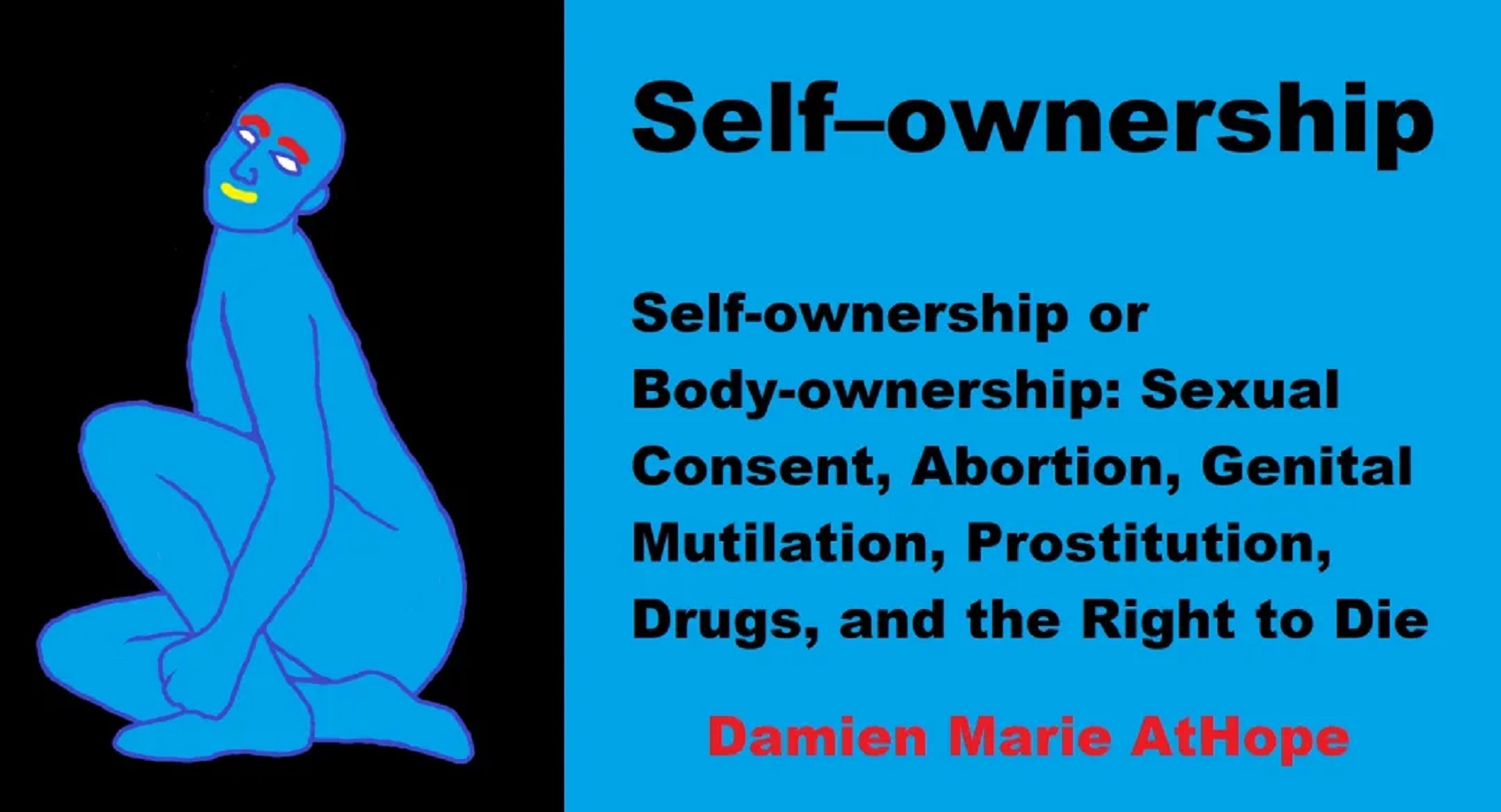
Self-ownership/Body-ownership: “Abortion”
I am a staunch believer in Self–ownership.
Axiological Ethics not Pseudo Morality
Self–ownership (or sovereignty of the individual, individual sovereignty, or individual autonomy) is the concept of property in one’s own person, expressed as the moral or natural right of a person to have bodily integrity, and be the exclusive controller of his own body and life.
In a general sense, the concept of rights means that an individual, and by extension all people in society are justified in rejecting force agent themselves or using force to defend themselves or others in certain circumstances from human rights violations, “self-ownership violations” meaning “the individual owns themselves and thus has rights to their body and what interacts with it or how it is used (self-governed body).” This is something that very few people would dispute, and thus the concept of human rights or self-ownership basically highlights the thinking connected to one’s right to life as well as how that life is used. “Self-ownership” can thus be interpreted as meaning: we have individual body sovereignty, we have moral legitimacy to our rights in our bodies, and our liberty s connected to this understanding, we are the only ones who (should) have control over ourselves, we are self-ownership agents on equal standing with every other self-ownership agent in society. Therefore, “Self-ownership” is the capacity to live wholly in accordance with the full and free exercise of our private judgment about and to our body. Ref
“Self-ownership” can be thought of as a person’s self-management and can thus be interpreted as supported under: Civil liberties “sovereignty of the individual”.
Civil liberties are personal guarantees and freedoms that the government cannot abridge, either by law or by judicial interpretation without due process. Though the scope of the term differs amongst various countries, some examples of civil liberties include the freedom from torture, freedom from forced disappearance, freedom of conscience, freedom of press, freedom of religion, freedom of expression, freedom of assembly, the right to security and liberty, freedom of speech, the right to privacy, the right to equal treatment under the law and due process, the right to a fair trial, and the right to life. Other civil liberties include the right to own property, the right to defend oneself, and the right to bodily integrity. In America we not only have Bill of Rights a collective name for amendments to the United States Constitution states have a constitution such as a bill of rights, or similar constitutional documents that enumerate and seek to guarantee civil liberties. Likewise, there is the European Convention on Human Rights and the International Covenant on Civil and Political Rights. Ref
The Thirteenth Amendment to the United States Constitution (abolished slavery and involuntary servitude) is sometimes viewed as an implementation of the concept of self-ownership, as are some portions of the Bill of Rights. Ref
“Self-ownership” can be thought of as involving a person’s bodily integrity which is the inviolability of the physical body and emphasizes the importance of personal autonomy and the self-determination of human beings over their own bodies. It considers the violation of bodily integrity as an unethical infringement. Ref
Self-ownership, Human Rights, and Societal Liberty or Freedoms
What is the price of a tear, what is the cost of a smile; can one see clear when others pay the price of their fear? If we don’t stop the suffering and harm, will the cost be more than we can take to our humanity?
What governments do is give and remove human rights at their whim. They have no ethics that they must adhere to and instead allow or force their will for their own ends even if this is unethical to human rights. This makes for the future where you feel you need to beg them by voting.

If Roe v. Wade is overturned, here’s how abortion laws in each state will stand
“A leak of a draft opinion from the Supreme Court suggests it may overturn Roe v. Wade, allowing states to make abortion illegal. The draft was published by Politico on Monday and not independently verified by USA TODAY. If the Supreme Court overturns the decision, then abortion laws would be handled by the individual states.” ref
“Roe was egregiously wrong from the start,” Associate Justice Samuel Alito wrote in the draft obtained by Politico. “We hold that Roe and Casey must be overruled.” The 1973 decision of Roe v. Wade constitutionally established the right to abortion.” ref
“If the Supreme Court does overturn Roe v. Wade, 22 states have laws or constitutional amendments that would take effect immediately or as soon as possible to ban abortion, according to Guttmacher Institute. According to the institute, four other states – Florida, Indiana, Montana, and Nebraska – have indicators that could likely ban abortion as soon as possible without federal protections.” ref
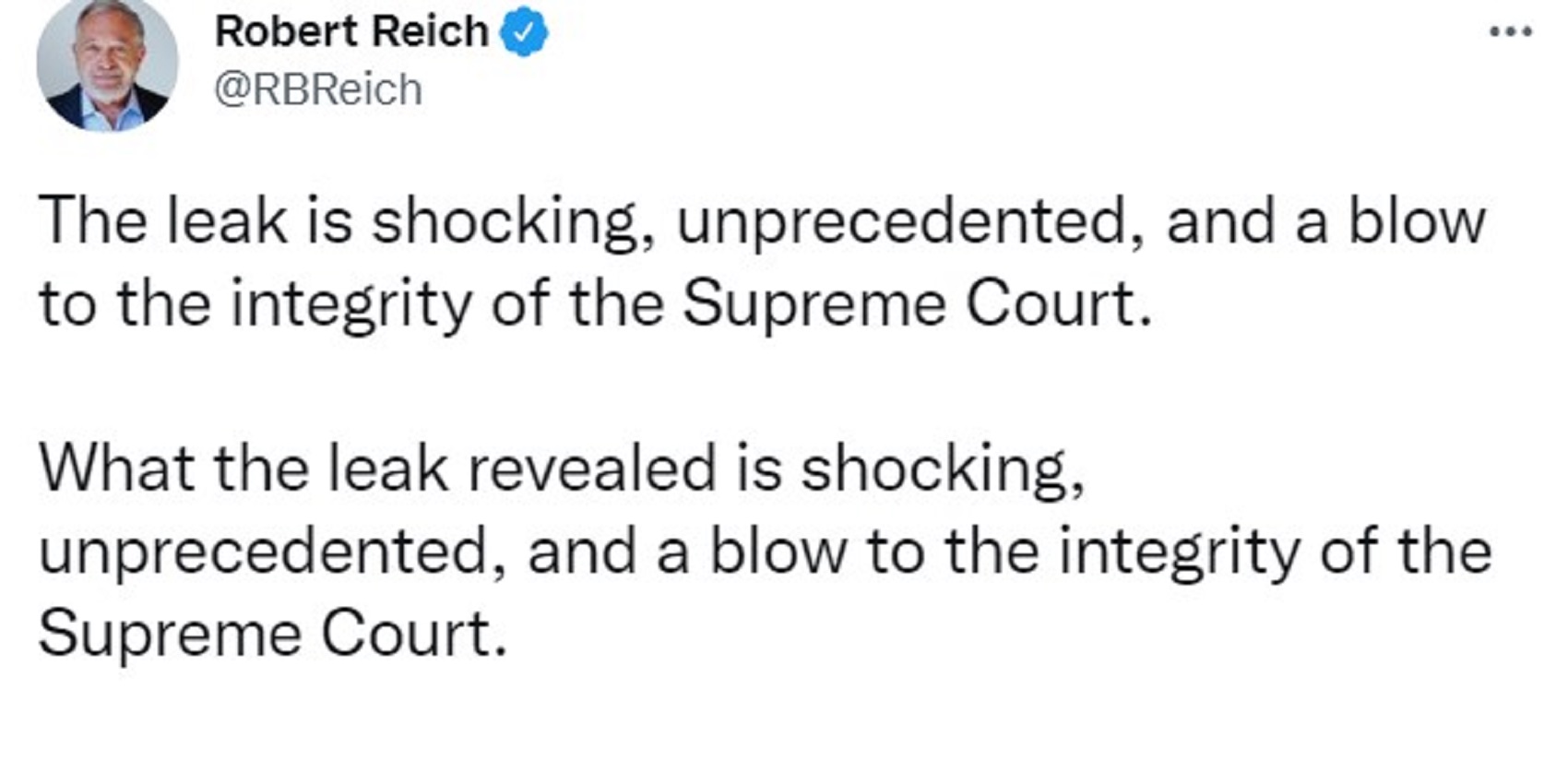
https://twitter.com/RBReich/status/1521542630726770689 Robert Reich @RBReich
What happens if Roe v. Wade is overturned?: What we know about Supreme Court’s leaked draft
“This is an earthquake – for what it portends for the future not only of Roe, but of all implied fundamental rights, and for the stunning breach of the court’s norms of confidentiality,” tweeted Stephen Vladeck, a professor at the University of Texas at Austin School of Law.” ref
States with bans on abortions
“According to Guttmacher Institute, there are 22 states with bans or potential bans on abortion if Roe v. Wade is overturned. Some states have pre-Roe bans that were enacted before 1973 and were never removed. Trigger bans are laws “triggered” into effect automatically or by state action if Roe v. Wade is overturned, according to the institute. Other states have six-week abortion bans, eight-week abortion bans, and state constitution bars protection.” ref
“Here’s where states stand, according to Guttmacher:
- Alabama: Pre-Roe ban, near-total ban, state constitution bars protection
- Arizona: Pre-Roe ban
- Arkansas: Pre-Roe ban, trigger ban, near-total ban
- Georgia: Six-week ban
- Idaho: Trigger ban, six-week ban
- Iowa: Six-week ban
- Kentucky: Trigger ban, six-week ban
- Louisiana: Trigger ban, near-total ban, six-week ban, state constitution bars protection
- Michigan: Pre-Roe ban
- Mississippi: Pre-Roe ban, trigger ban, six-week ban
- Missouri: Trigger ban, eight-week ban
- North Dakota: Trigger ban, six-week ban
- Ohio: Six-week ban
- Oklahoma: Pre-Roe ban, trigger ban (effective November 1, 2021), near-total ban, six-week ban
- South Carolina: Six-week ban
- South Dakota: Trigger ban
- Tennessee: Trigger ban, six-week ban, state constitution bars protection
- Texas: Pre-Roe ban, trigger ban, six-week ban
- Utah: Trigger ban, near-total ban
- West Virginia: Pre-Roe ban, state constitution bars protection
- Wisconsin: Pre-Roe ban
- Wyoming: Trigger ban” ref
States with protections on abortions
“There are 16 states and the District of Columbia who have laws that protect the right to abortion despite if Roe v. Wade is overturned, according to Guttmacher.” ref
“Here are the states with protections:
- California: Prior to viability
- Colorado: Throughout pregnancy
- Connecticut: Prior to viability
- Delaware: Prior to viability
- District of Columbia: Throughout pregnancy
- Hawaii: Prior to viability
- Illinois: Prior to viability
- Maine: Prior to viability
- Maryland: Prior to viability
- Massachusetts: Prior to viability
- Nevada: Prior to viability
- New Jersey: Throughout pregnancy
- New York: Prior to viability
- Oregon: Throughout pregnancy
- Rhode Island: Prior to viability
- Vermont: Throughout pregnancy
- Washington: Prior to viability” ref

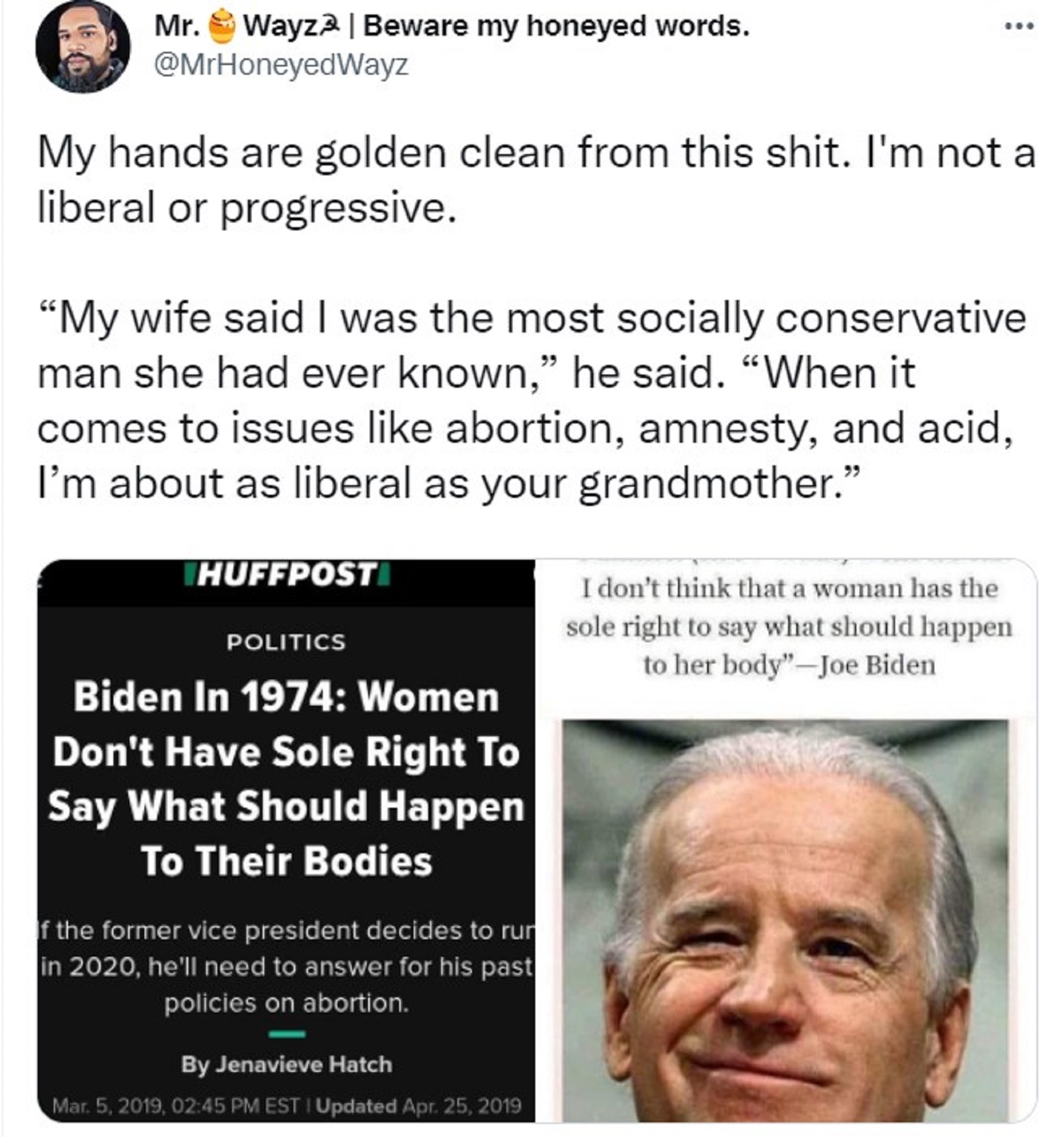
https://twitter.com/MrHoneyedWayz/status/1521527511867346947 Mr. Wayz☭ | Beware my honeyed words. @MrHoneyedWayz


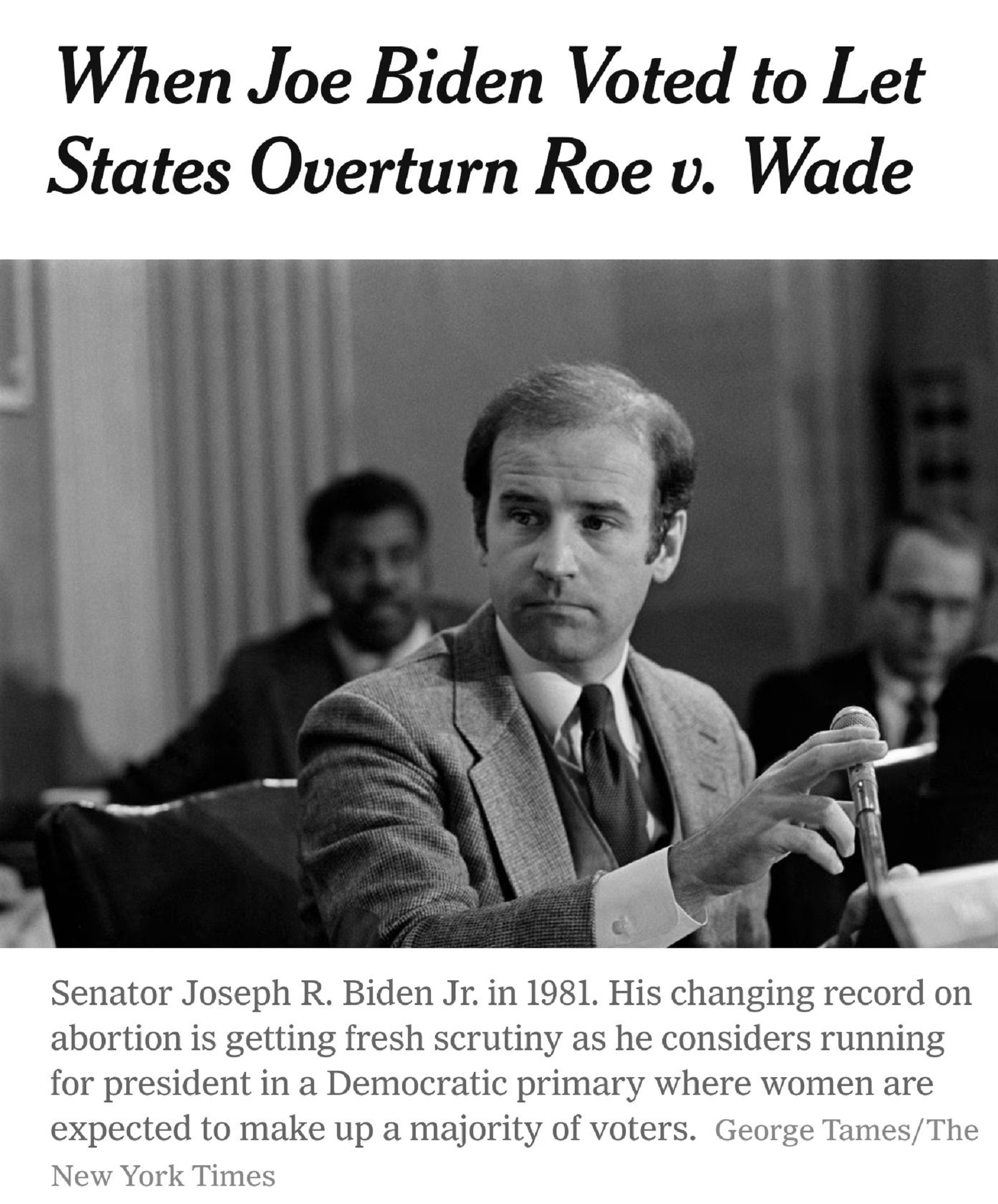

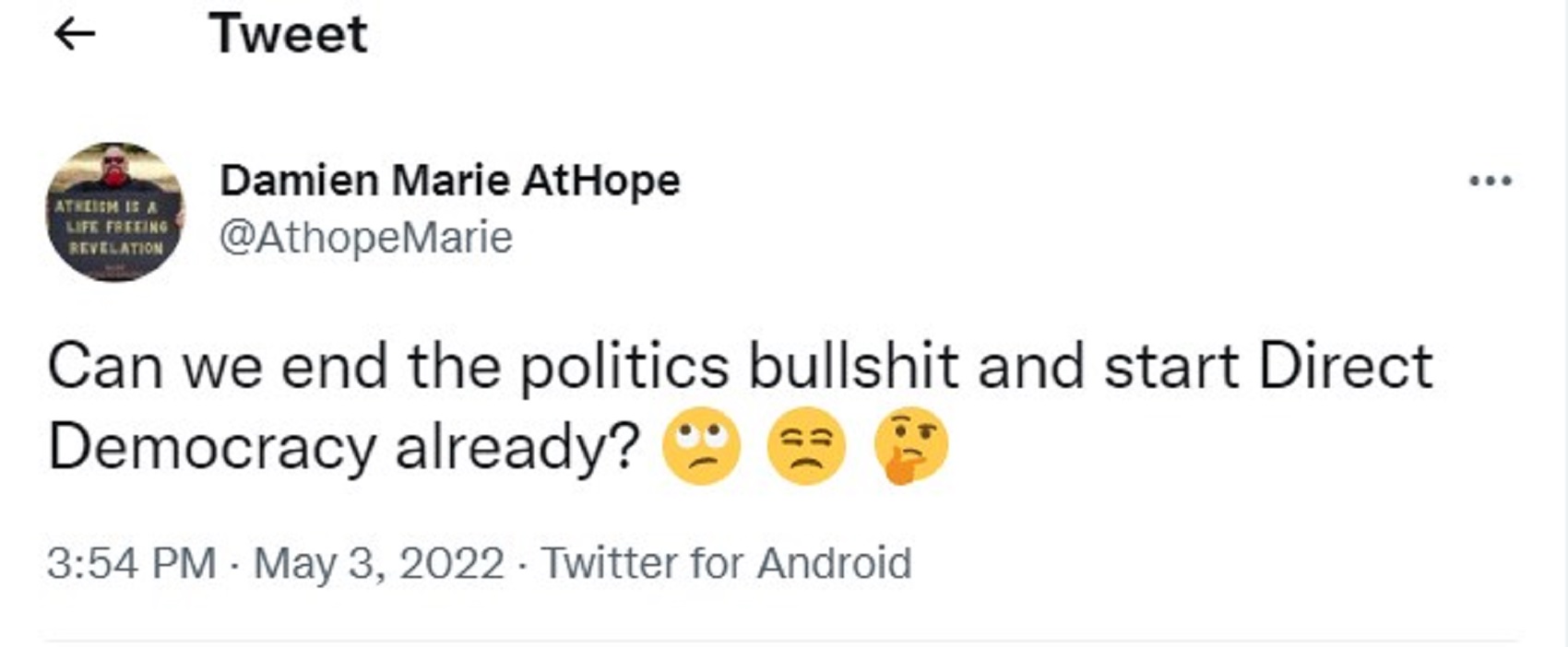
Direct Democracy
“Direct democracy or pure democracy is a form of democracy in which the electorate decides on policy initiatives without elected representatives as proxies. This differs from the majority of currently established democracies, which are representative democracies. The theory and practice of direct democracy and participation as its common characteristic was the core of work of many theorists, philosophers, politicians, and social critics, among whom the most important are Jean Jacques Rousseau, John Stuart Mill, and G.D.H. Cole.” ref
“In direct democracy, the people decide on policies without any intermediary or representative, whereas in a representative democracy people vote for representatives who then enact policy initiatives. Depending on the particular system in use, direct democracy might entail passing executive decisions, the use of sortition, making laws, directly electing or dismissing officials, and conducting trials. Two leading forms of direct democracy are participatory democracy and deliberative democracy.” ref
“Semi-direct democracies, in which representatives administer day-to-day governance, but the citizens remain the sovereign, allow for three forms of popular action: referendum (plebiscite), initiative, and recall. The first two forms—referendums and initiatives—are examples of direct legislation. As of 2019, thirty countries allowed for referendums initiated by the population on the national level.” ref
“A compulsory referendum subjects the legislation drafted by political elites to a binding popular vote. This is the most common form of direct legislation.” ref
“A popular referendum empowers citizens to make a petition that calls existing legislation to a vote by the citizens. Institutions specify the timeframe for a valid petition and the number of signatures required, and may require signatures from diverse communities to protect minority interests. This form of direct democracy effectively grants the voting public a veto on laws adopted by the elected legislature, as in Switzerland.” ref
“A citizen-initiated referendum (also called an initiative) empowers members of the general public to propose, by petition, specific statutory measures or constitutional reforms to the government and, as with other referendums, the vote may be binding or simply advisory. Initiatives may be direct or indirect: with the direct initiative, a successful proposition is placed directly on the ballot to be subject to vote (as exemplified by California’s system). With an indirect initiative, a successful proposition is first presented to the legislature for their consideration; however, if no acceptable action is taken after a designated period of time, the proposition moves to a direct popular vote. Constitutional amendments in Switzerland, Liechtenstein, and Uruguay go through such a form of indirect initiative.” ref
“A deliberative referendum is a referendum that increases public deliberation through purposeful institutional design.” ref
“The power of “Recall” gives the public the power to remove elected officials from office before the end of their designated standard term of office.” ref
Direct Democracy in Antiquity?
“One strand of thought sees direct democracy as common and widespread in pre-state societies. The earliest well-documented direct democracy is said to be the Athenian democracy of the 5th century BCE. The main bodies in the Athenian democracy were the assembly, composed of male citizens; the boulê, composed of 500 citizens; and the law courts, composed of a massive number of jurors chosen by lot, with no judges.” ref
“Ancient Attica had only about 30,000 male citizens, but several thousand of them were politically active in each year, and many of them quite regularly for years on end. The Athenian democracy was direct not only in the sense that the assembled people made decisions, but also in the sense that the people – through the assembly, boulê, and law courts – controlled the entire political process, and a large proportion of citizens were involved constantly in public affairs. Most modern democracies, being representative, not direct, do not resemble the Athenian system.” ref
“Also relevant to the history of direct democracy is the history of Ancient Rome, specifically during the Roman Republic, traditionally founded around 509 BCE. Rome displayed many aspects of democracy, both direct and indirect, from the era of Roman monarchy all the way to the collapse of the Roman Empire. While the Roman senate was the main body with historical longevity, lasting from the Roman kingdom until after the collapse of the Western Roman Empire in 476 CE, it did not embody a purely democratic approach, being made up – during the late republic – of former elected officials, providing advice rather than creating law.” ref
“The democratic aspect of the constitution resided in the Roman popular assemblies, where the people organized into centuriae or into tribes – depending on the assembly – and cast votes on various matters, including elections and laws, proposed before them by their elected magistrates. Some classicists have argued that the Roman republic deserves the label of “democracy”, with universal suffrage for adult male citizens, popular sovereignty, and transparent deliberation of public affairs. Many historians mark the end of the Republic with the lex Titia, passed on 27 November 43 BCE, which eliminated many oversight provisions.” ref
The greatest lie ever, was the fraud of democracy, from its conceptions in Greece, claiming the freedom to vote, all the while upholding the institution of slavery. We today are sold the lie of capitalism, and the elite that play in space, while children starve in the streets…
The sad history of democracy is one of continued bigotry of elites and slaves, but now with a happy face or less unhappy faces, I should say, for more accuracy, as some non-slaves were a little more equal in a limited kind of way and/or scope.
If Americanism has taught us anything, it is that this “land” (people claiming colonialism as a birthright) loves bigotry, hate, lying, violence, denial, and unscientific explanations to just about any damn thing that can’t get away fast enough.
Modern era Direct Democracy
“Modern-era citizen-lawmaking occurs in the cantons of Switzerland from the 13th century. In 1847 the Swiss added the “statute referendum” to their national constitution. They soon discovered that merely having the power to veto Parliament’s laws was not enough. In 1891 they added the “constitutional amendment initiative”. Swiss politics since 1891 have given the world a valuable experience-base with the national-level constitutional amendment initiative. In the past 120 years, more than 240 initiatives have been put to referendums. The populace has proven itself conservative, approving only about 10% of these initiatives; in addition, they have often opted for a version of the initiative rewritten by the government. (See “Direct democracy in Switzerland” below.)” ref
“Modern direct democracy also occurs within the Crow Nation, a Native American Tribe in the United States of America. The tribe is organized around a General Council formed of all voting-age members. The General Council has the power to create legally-binding decisions through referendums. The General Council was first enshrined in the 1948 Crow Constitution and was upheld and re-instated with the 2002 Constitution.” ref
“Some of the issues surrounding the related notion of a direct democracy using the Internet and other communications technologies are dealt with in the article on e-democracy and below under the heading Electronic direct democracy. More concisely, the concept of open-source governance applies principles of the free software movement to the governance of people, allowing the entire populace to participate in government directly, as much or as little as they please.” ref
“Direct democracy is the basis of anarchist and left-libertarian political thought. Direct democracy has been championed by anarchist thinkers since its inception, and direct democracy as a political theory has been largely influenced by anarchism.” ref
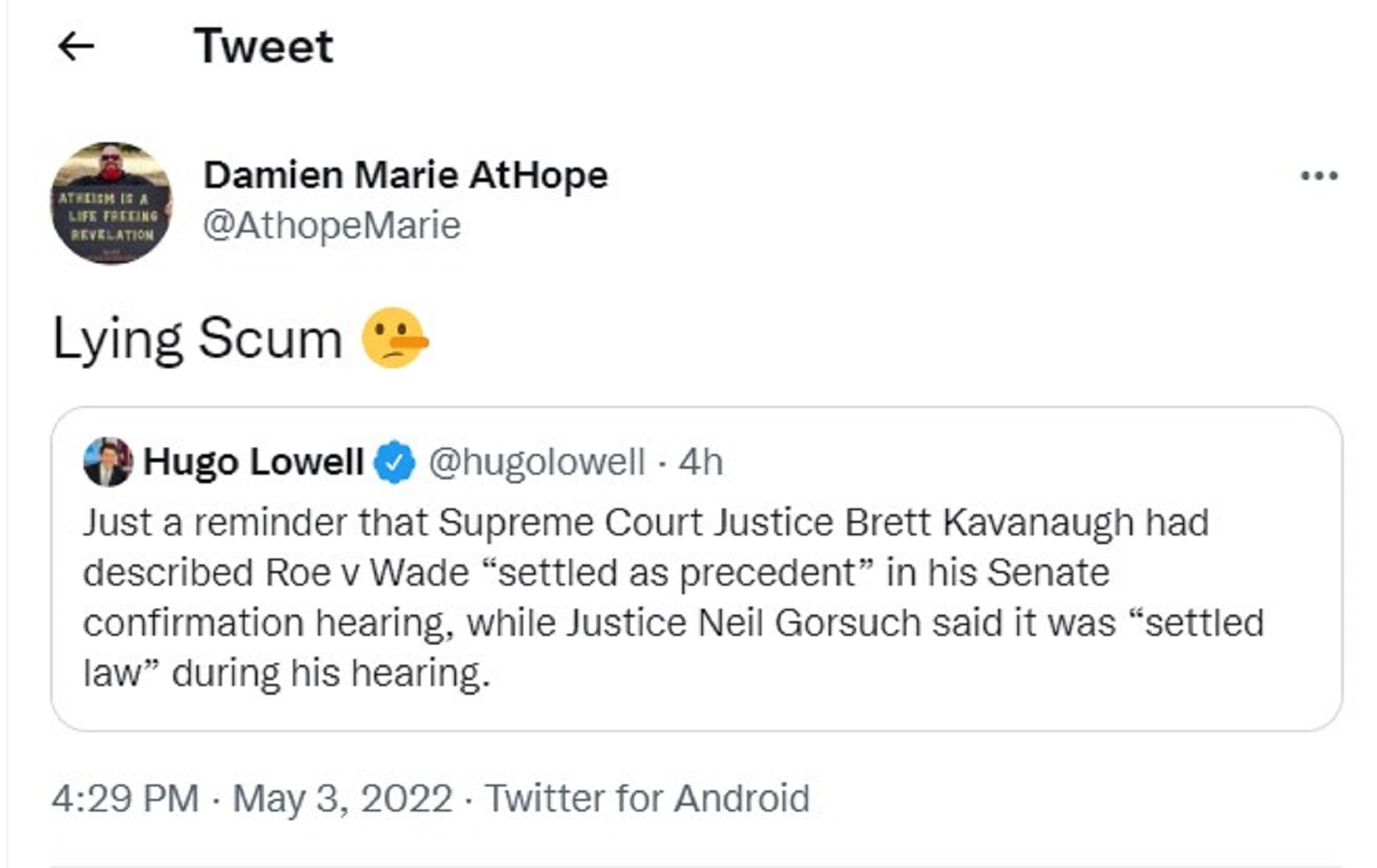
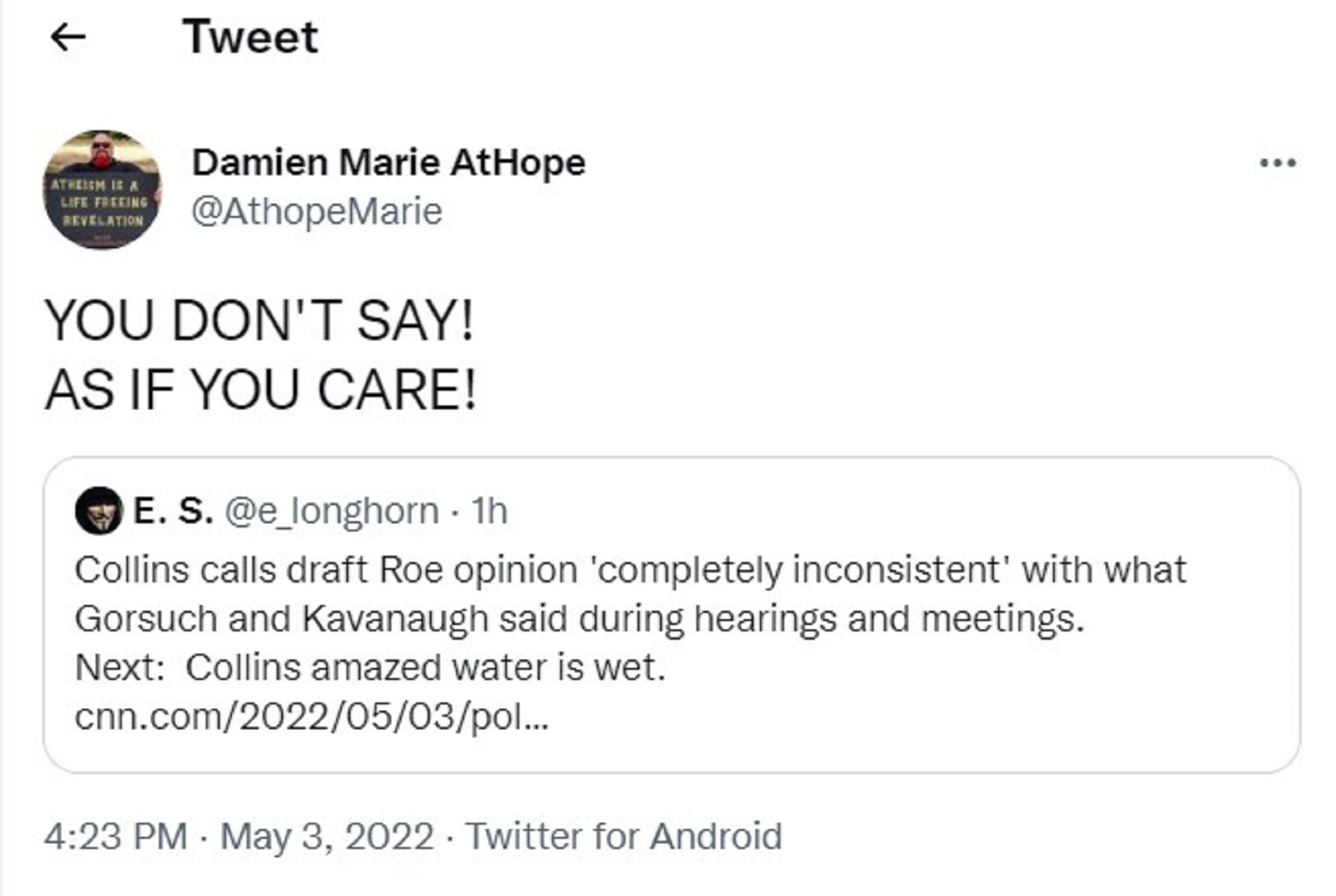
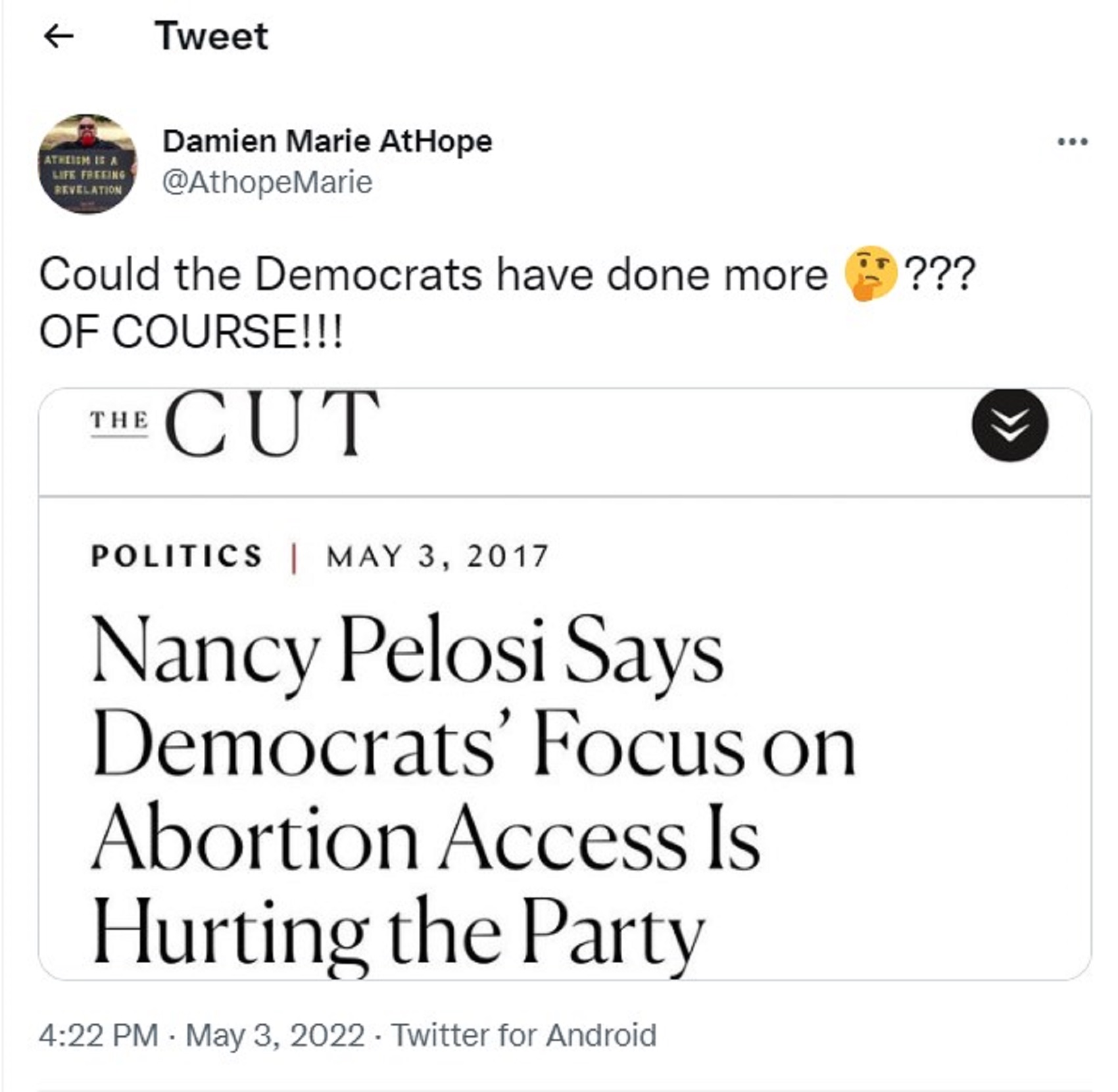
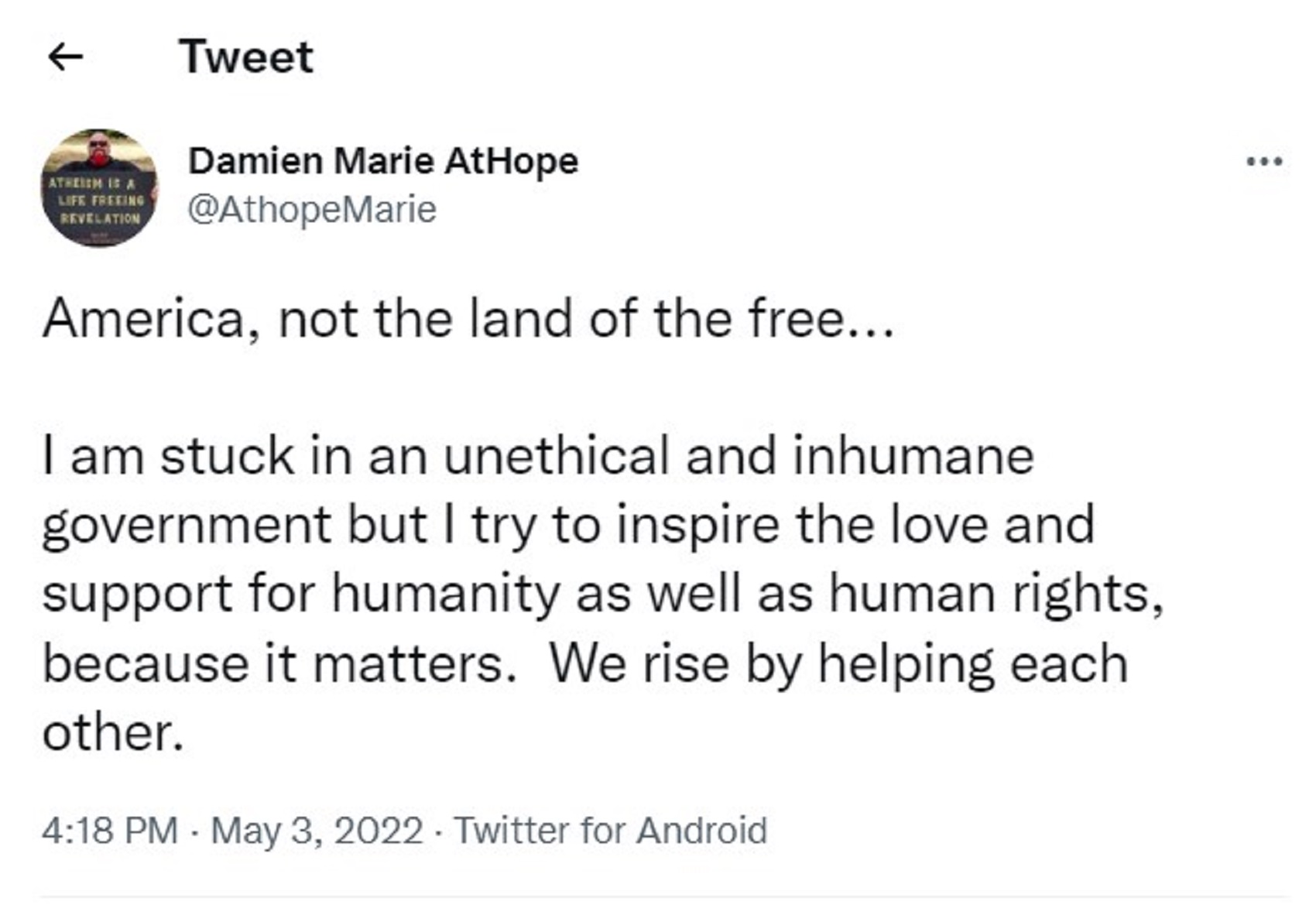
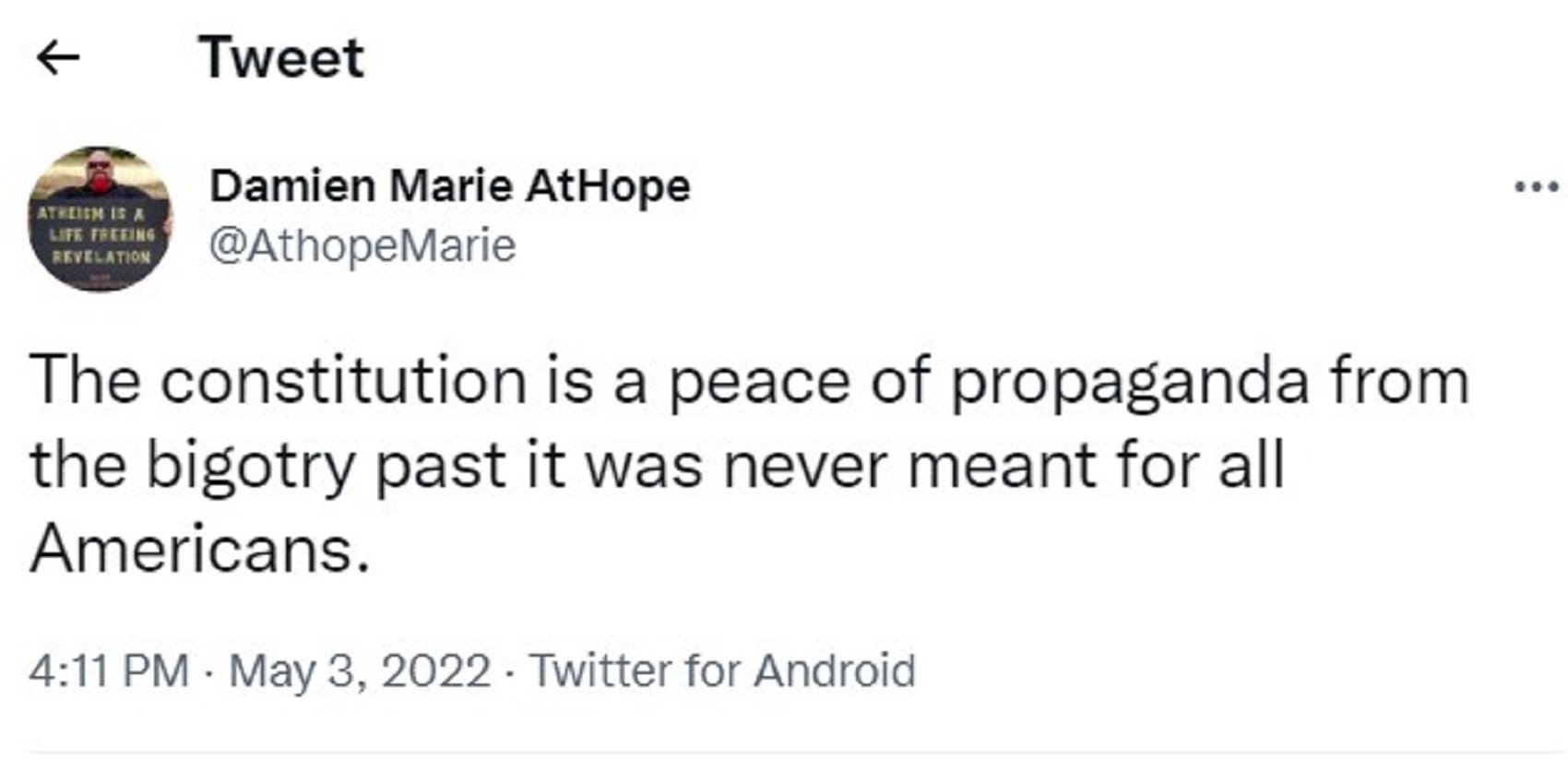
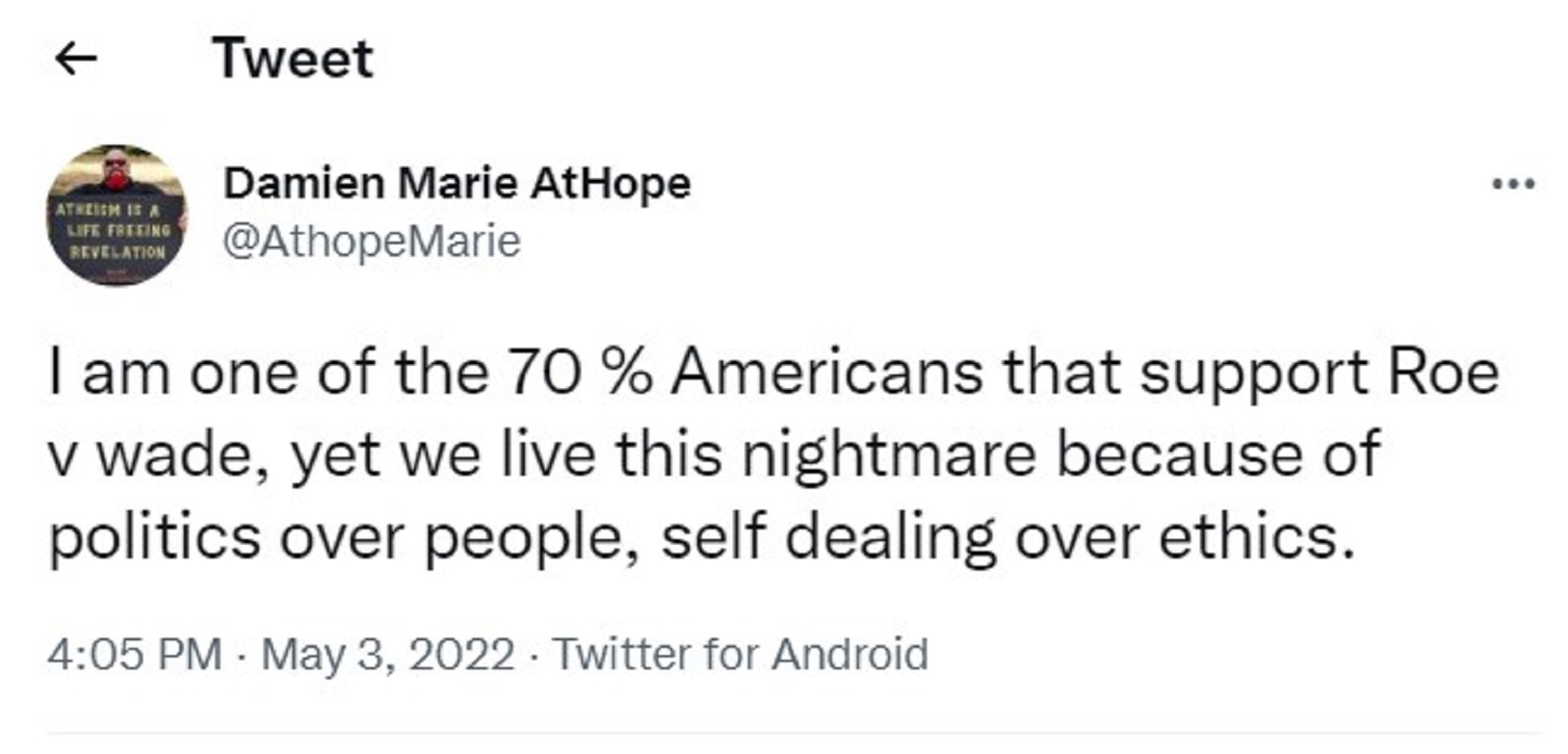
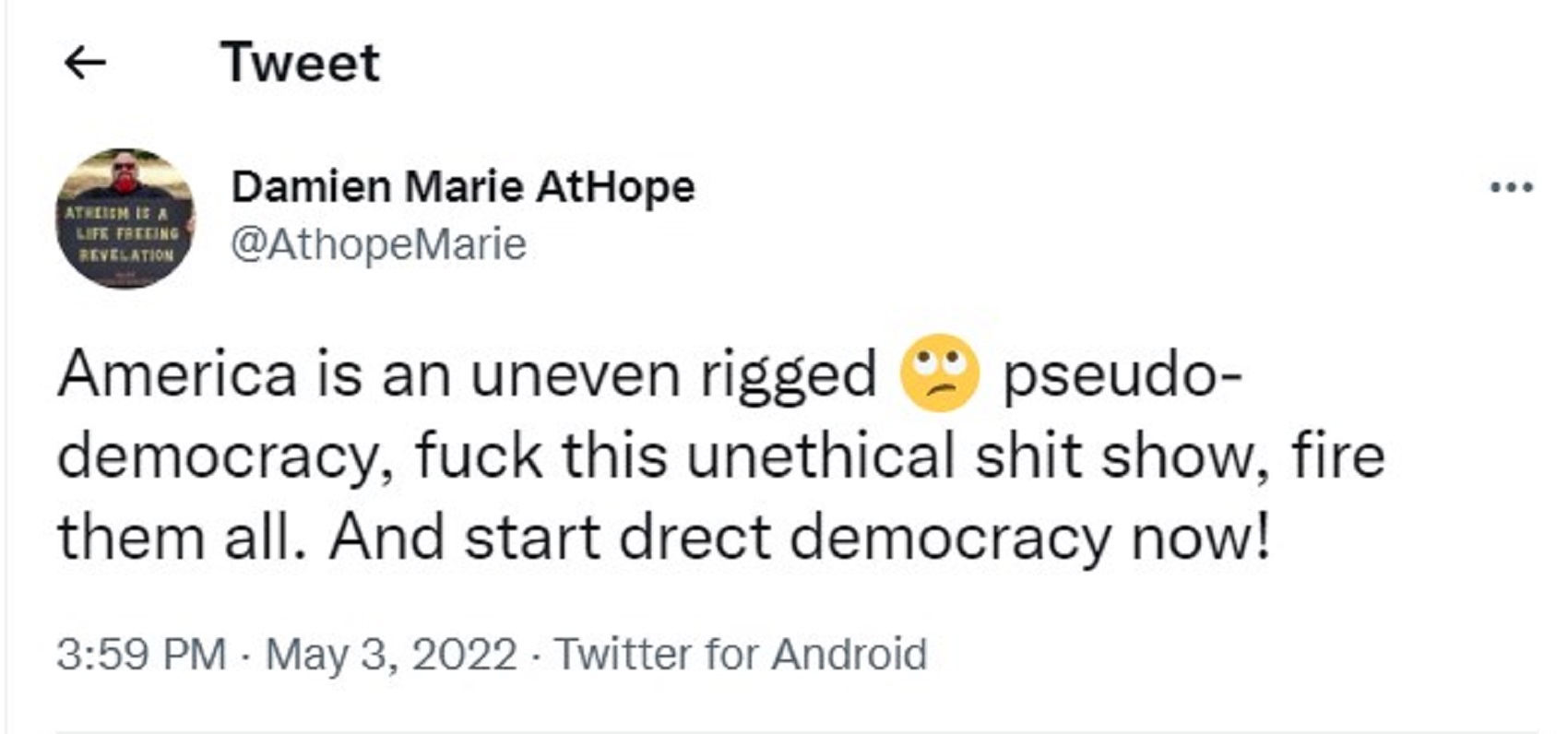


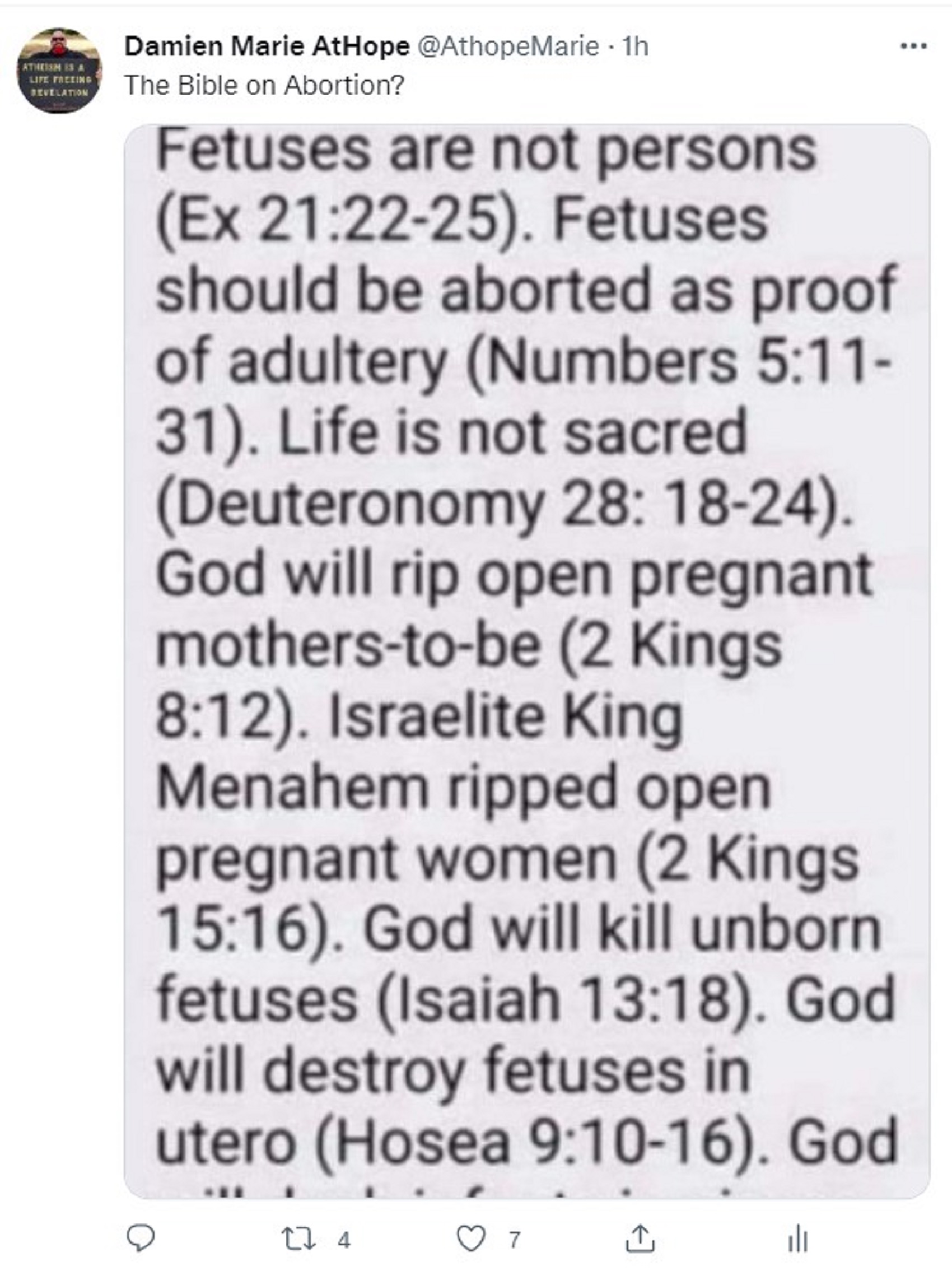
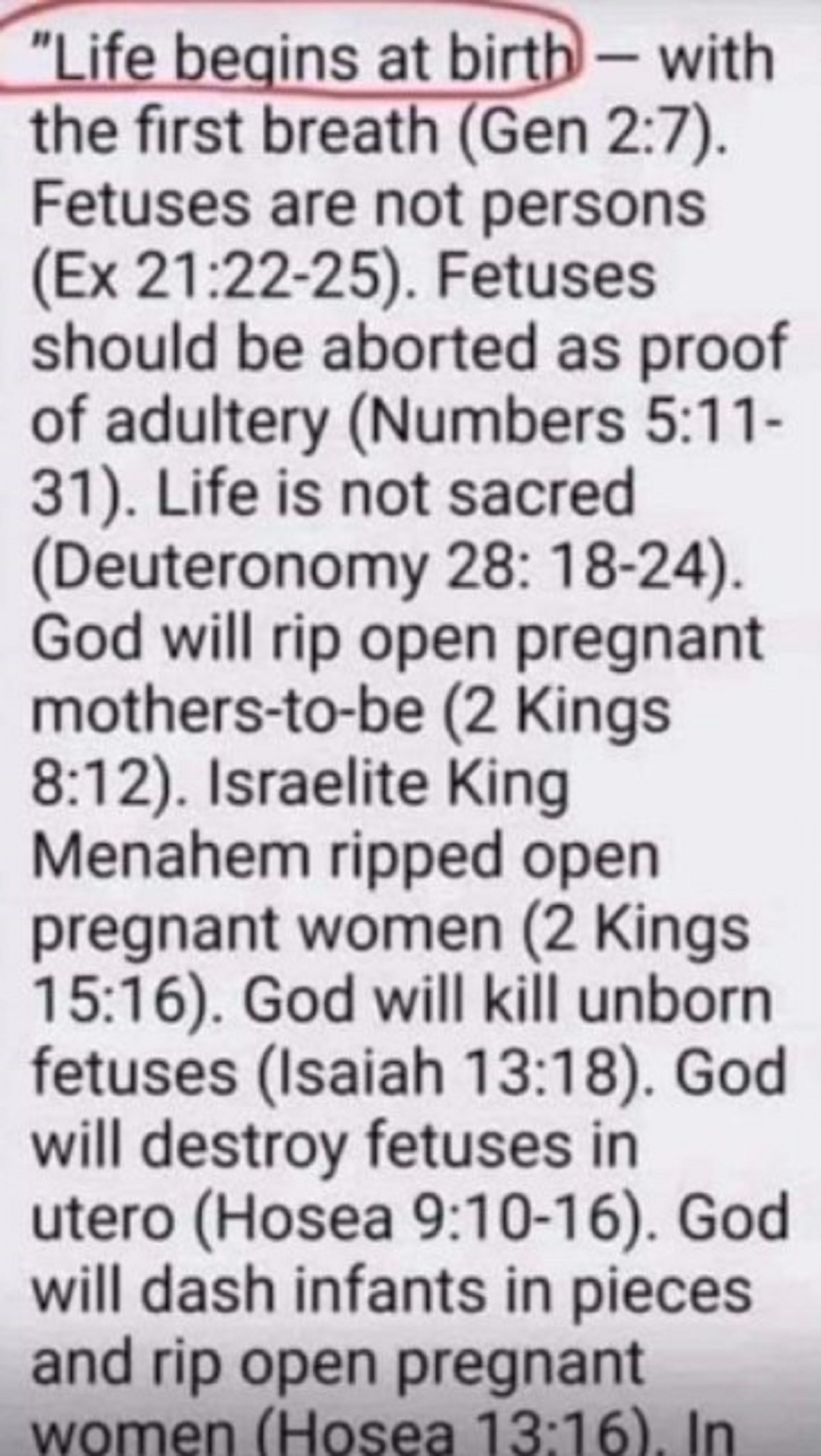
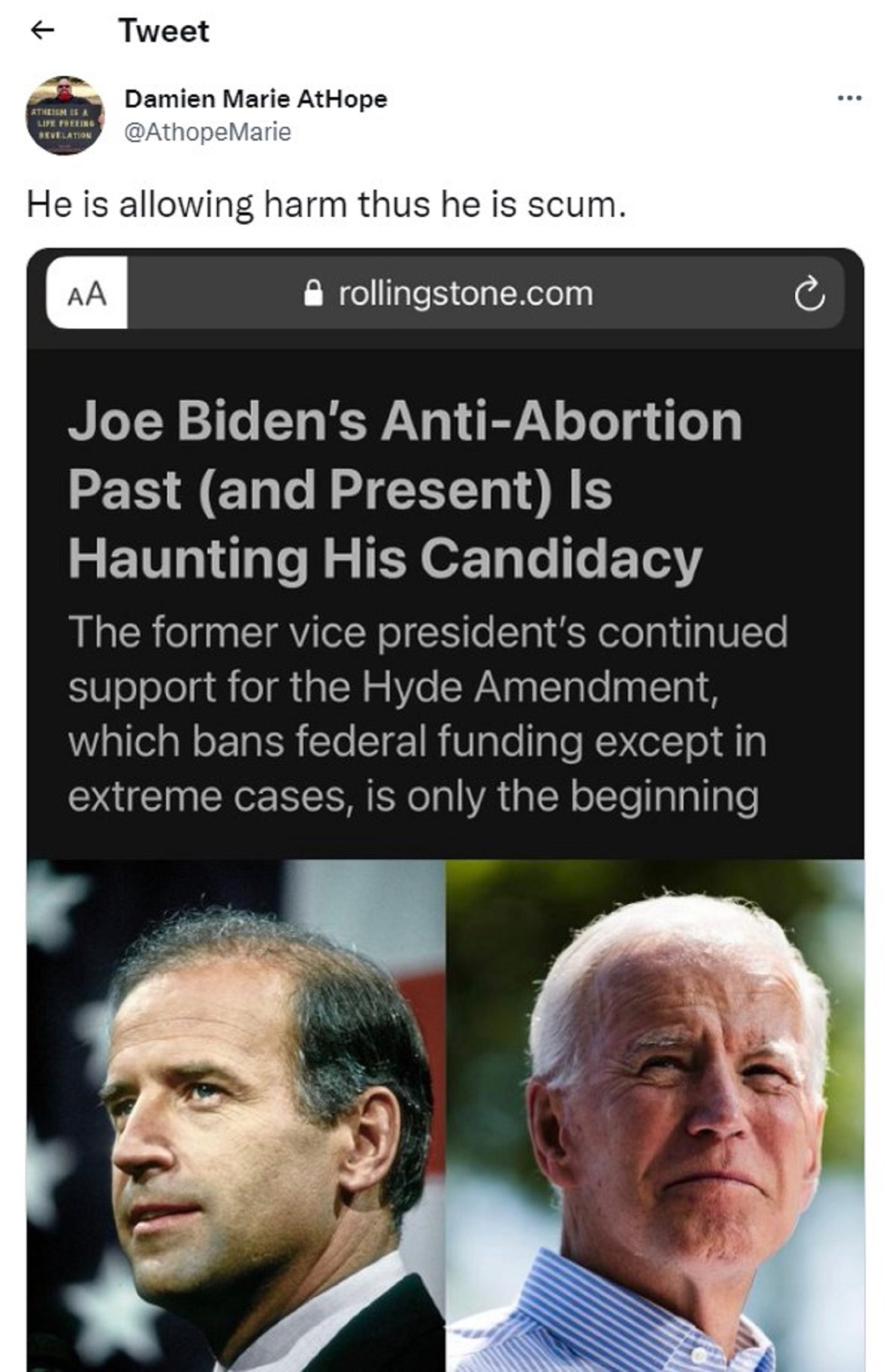
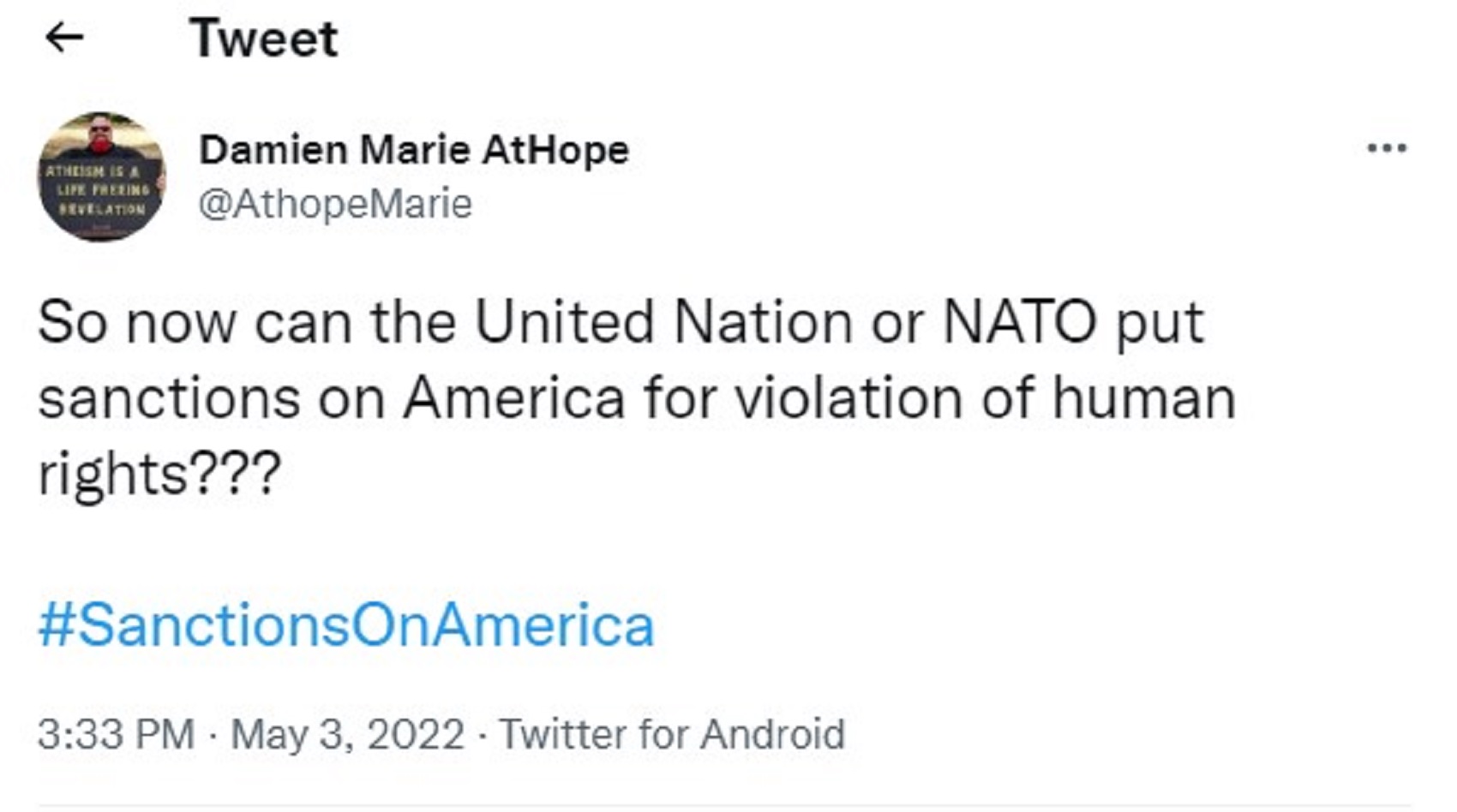
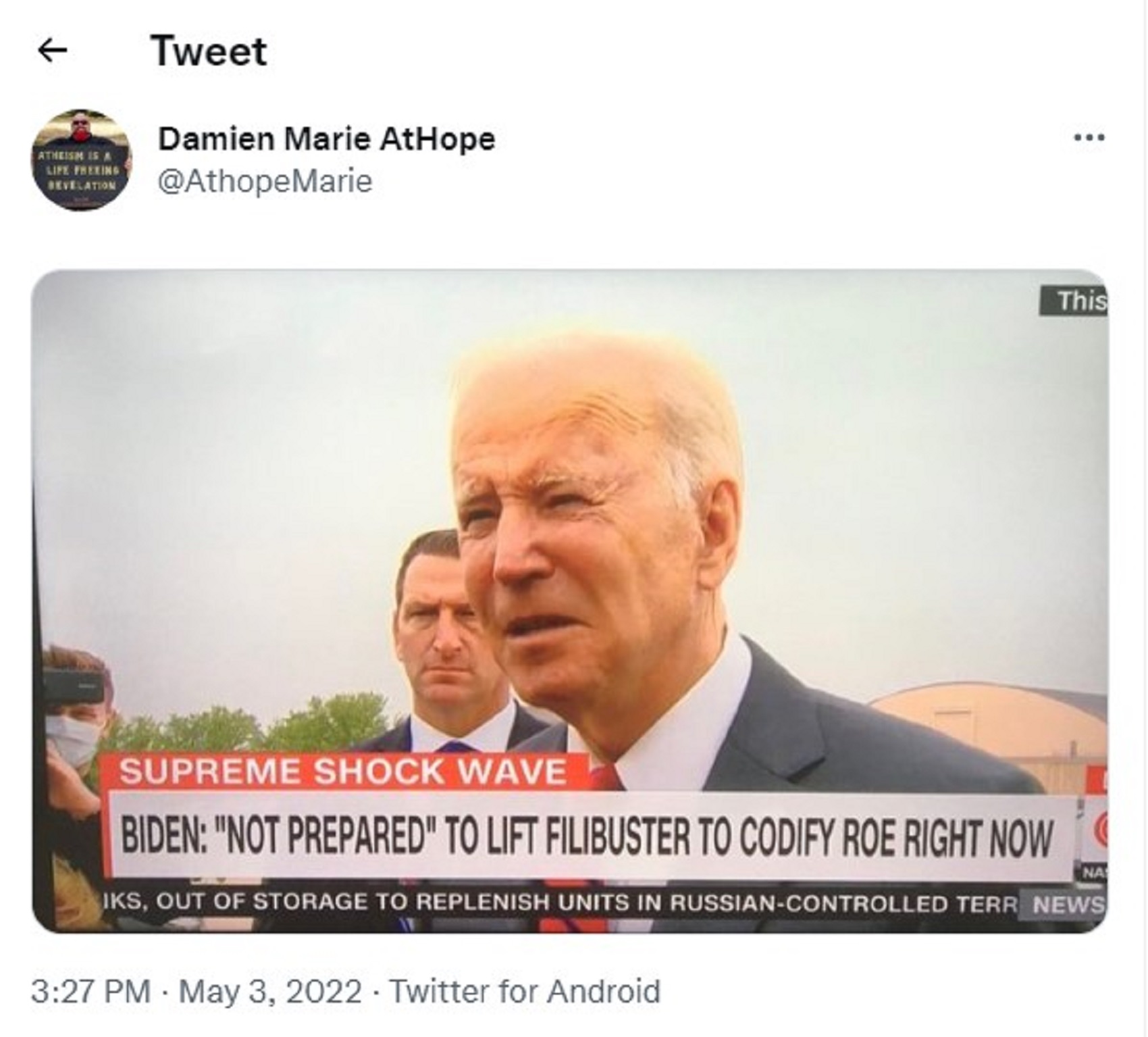
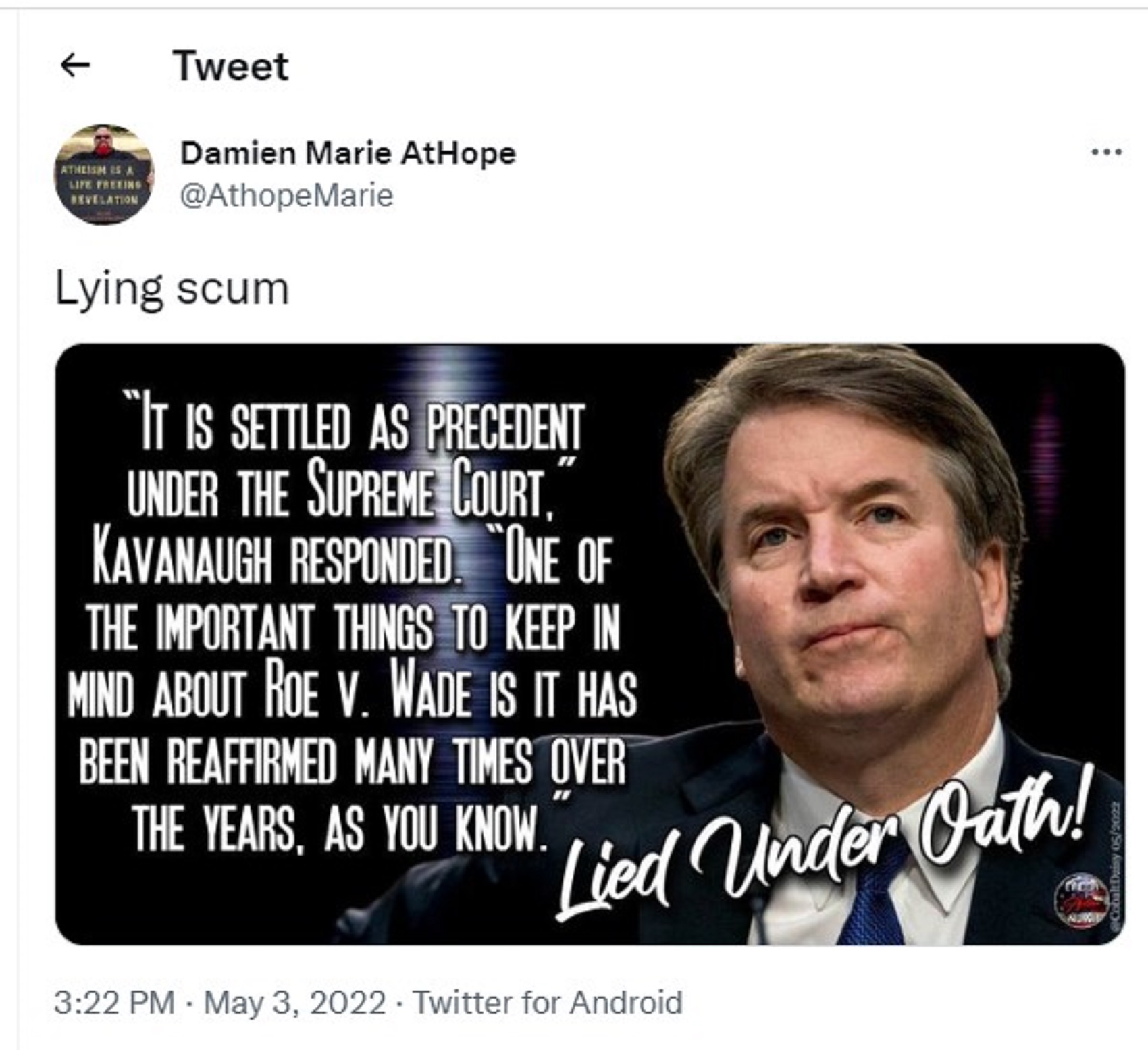
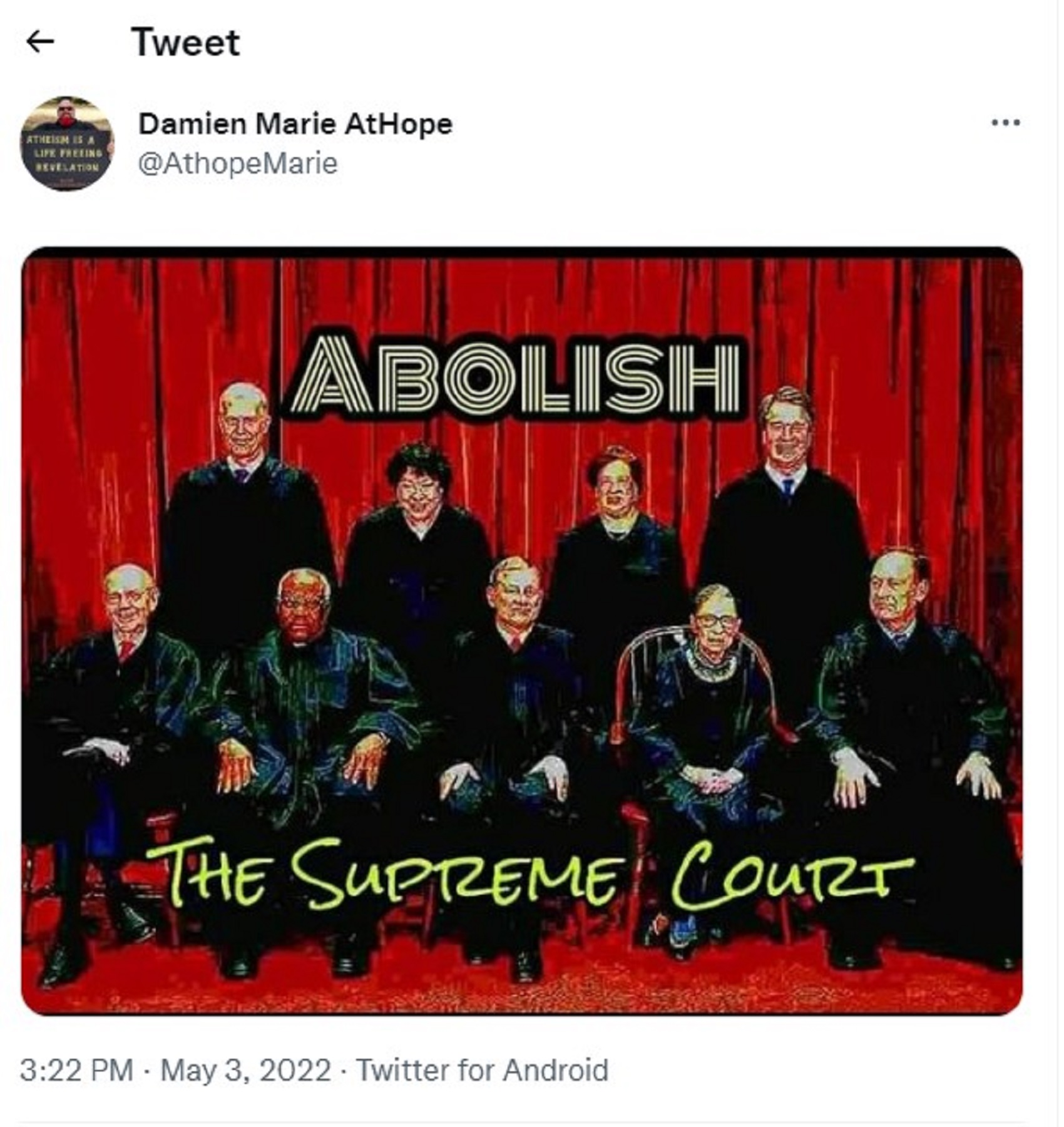
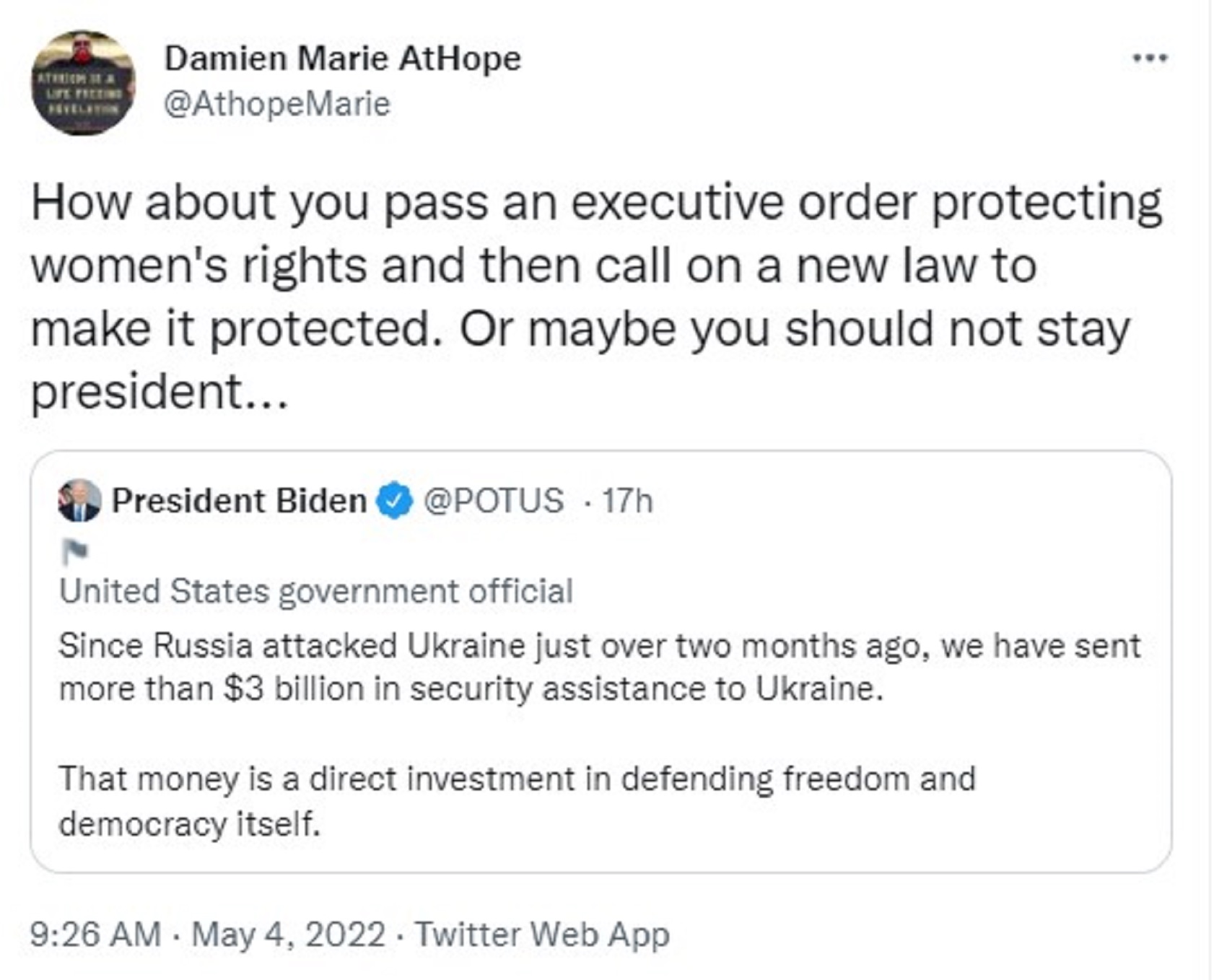
Impeach Biden as he will not do what it takes to protect women’s rights. It is all about protecting power not protecting the rights of people. Put up or shut up. And this should be so with all politicians who claim to care. If you do nothing then you must go…
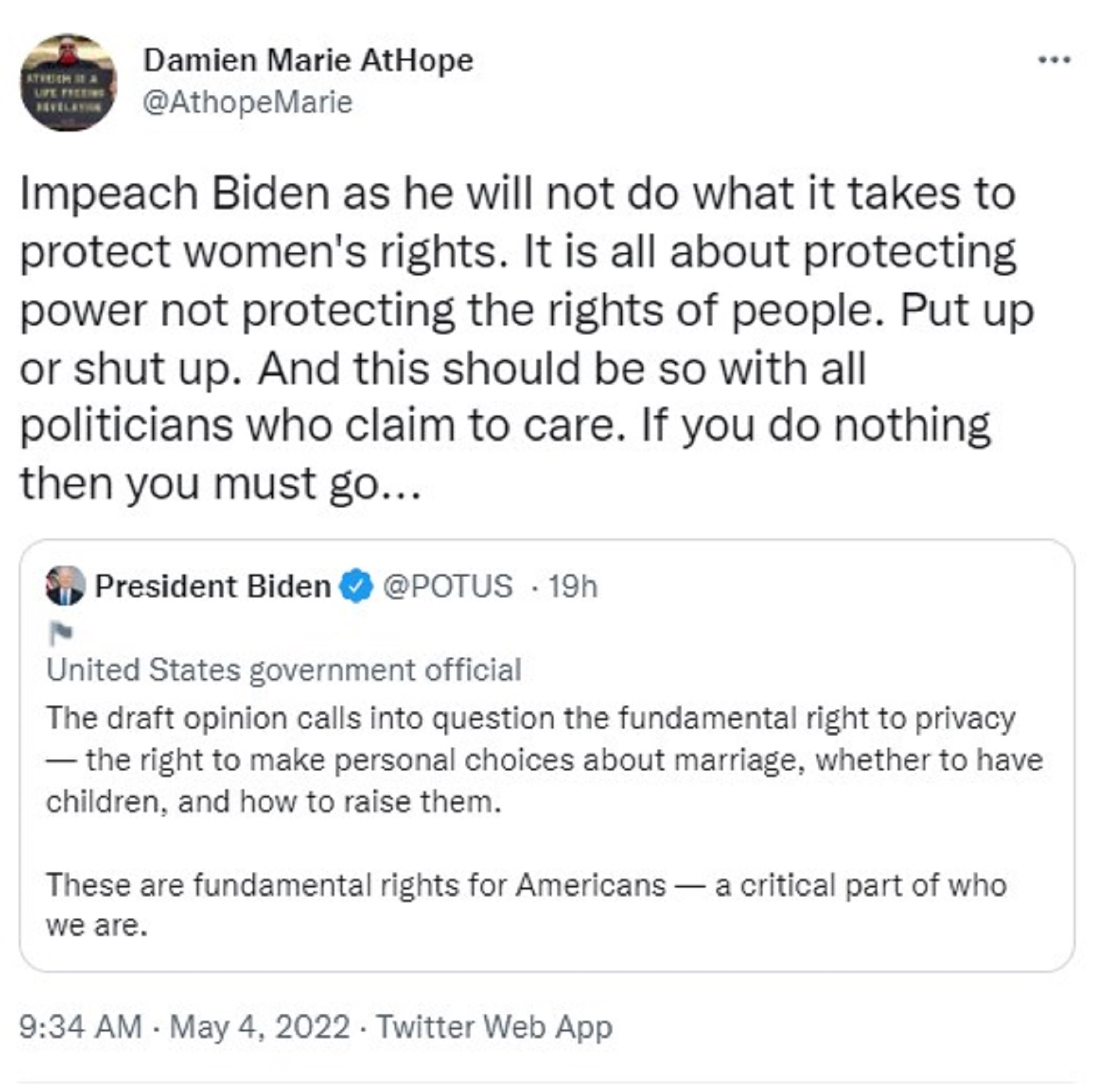
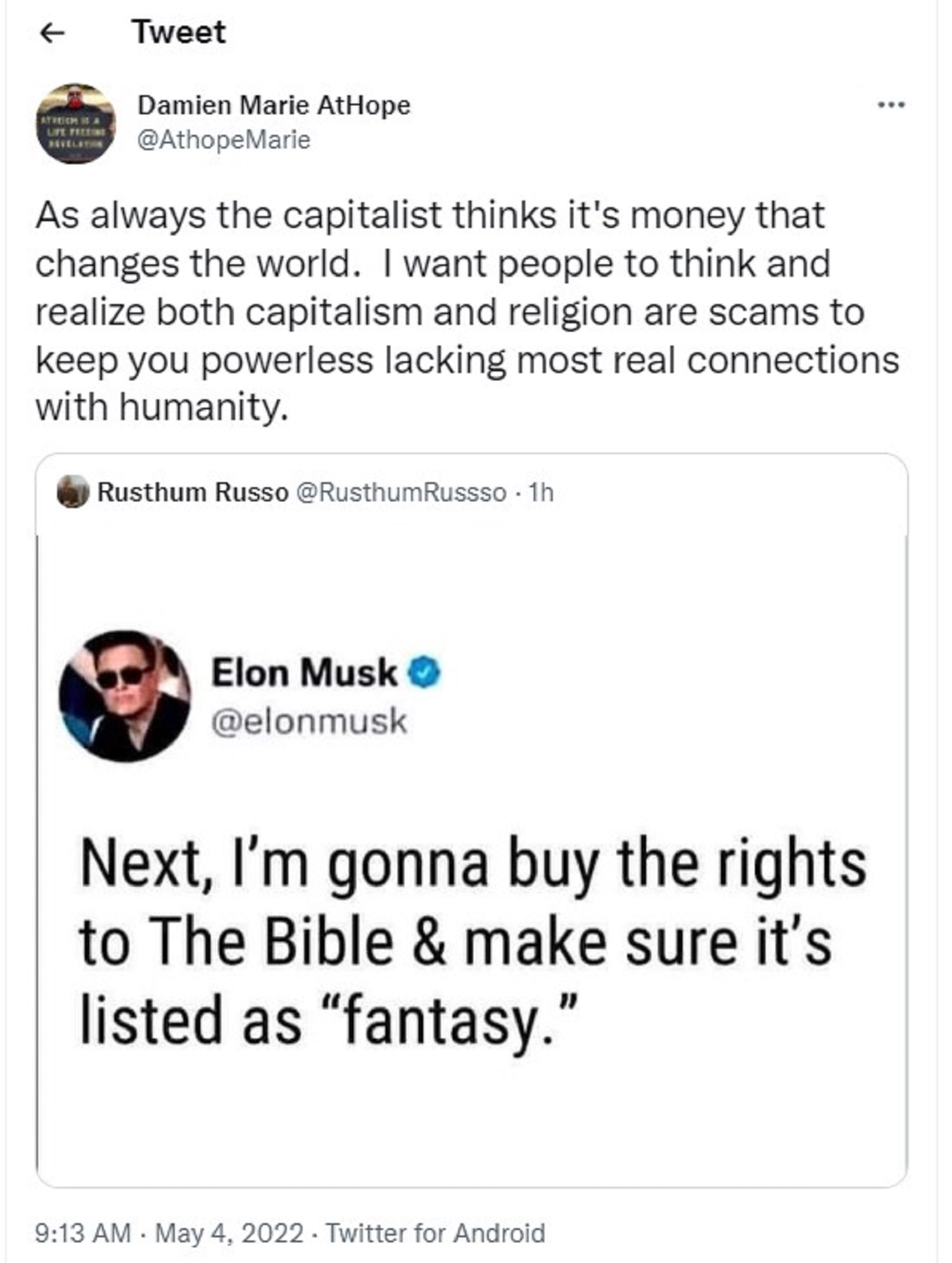
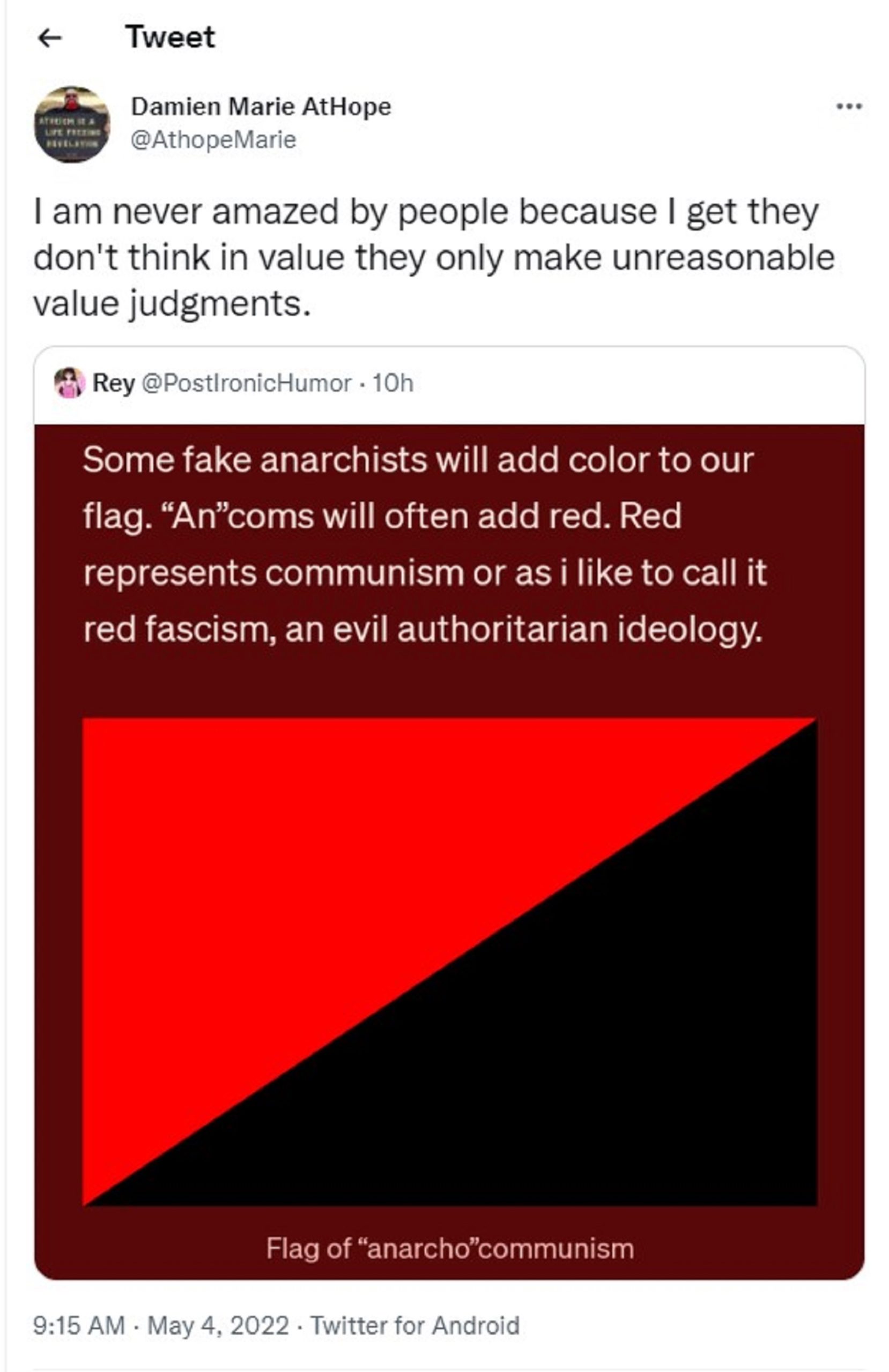

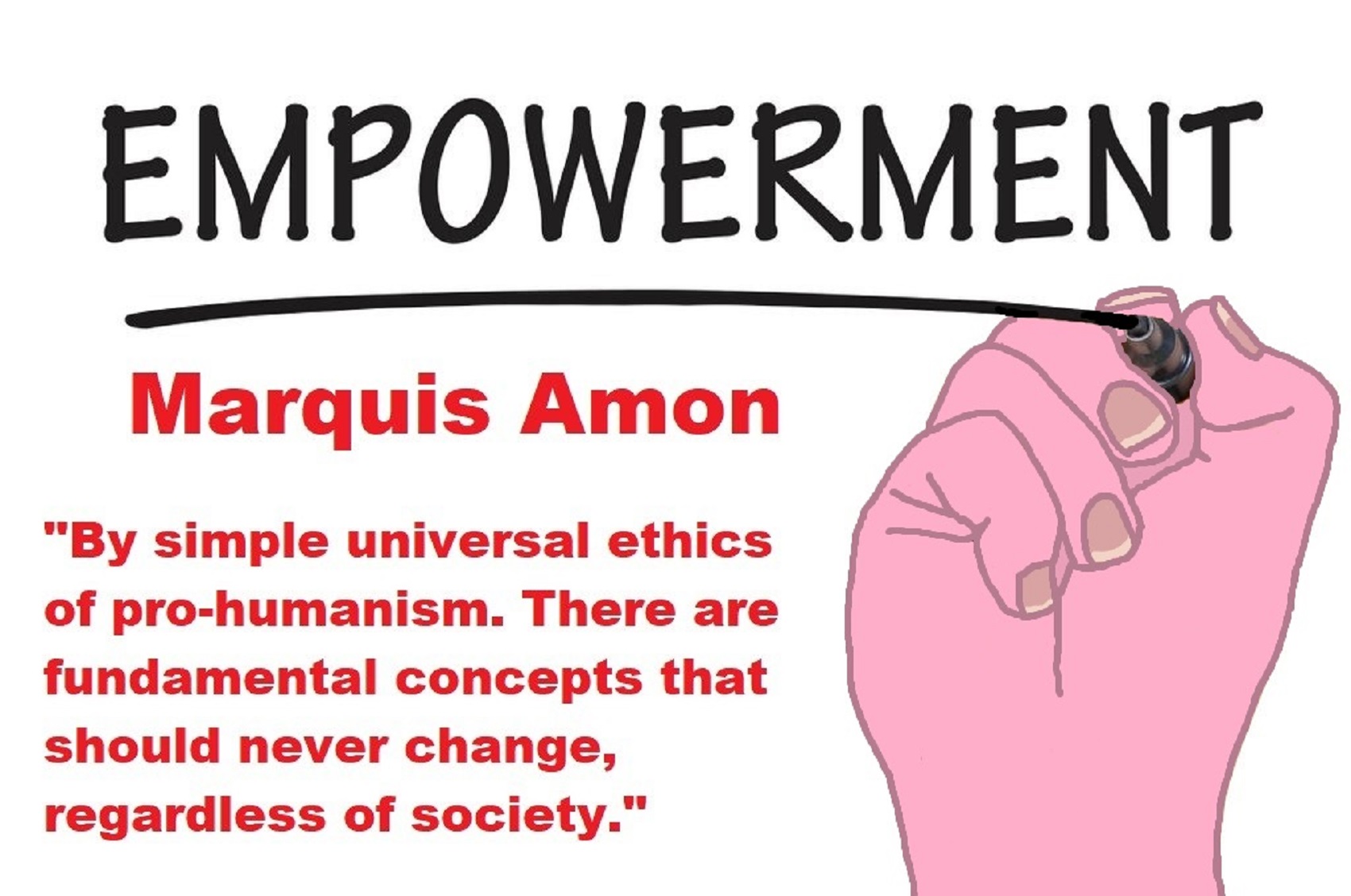
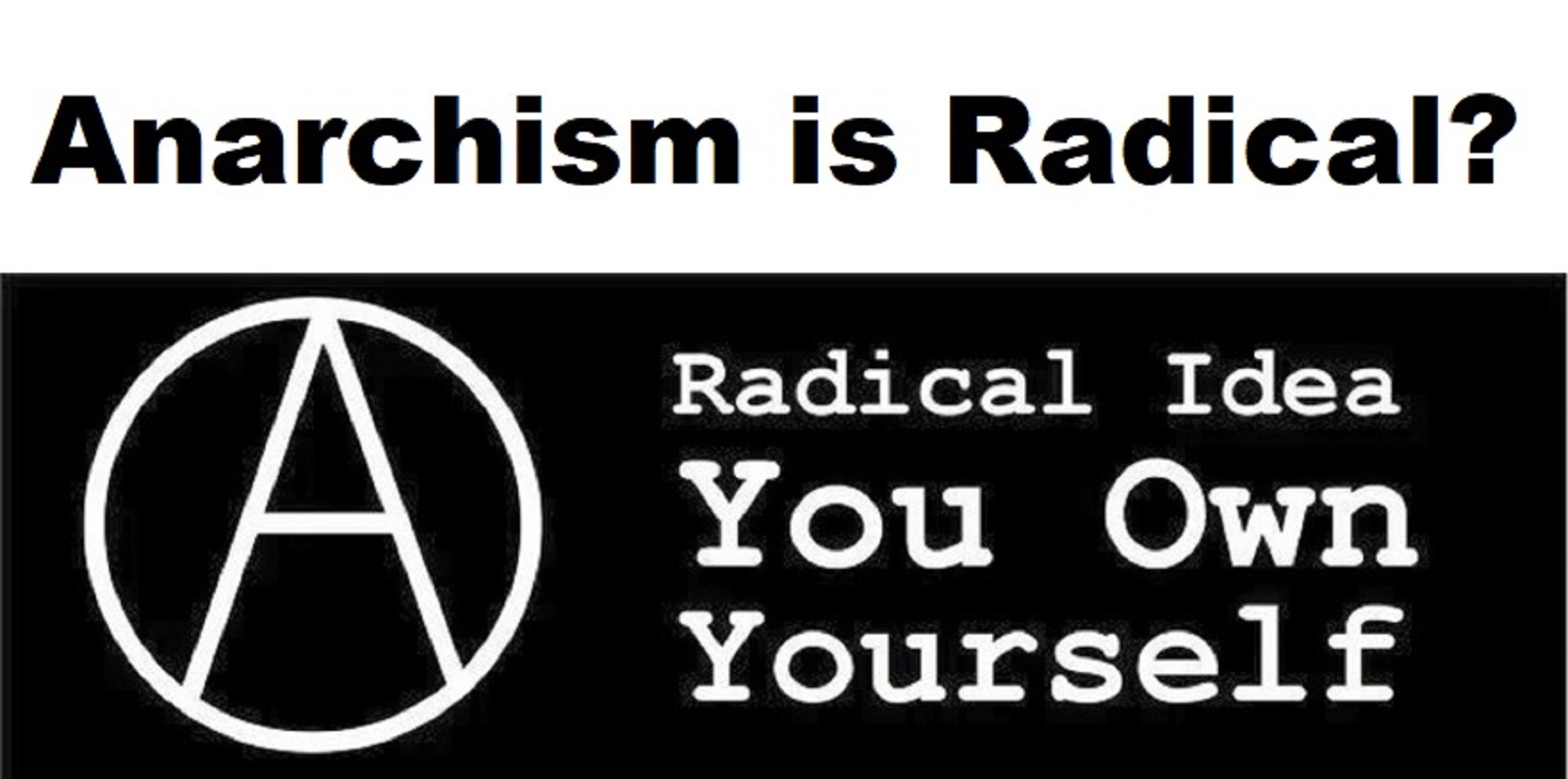



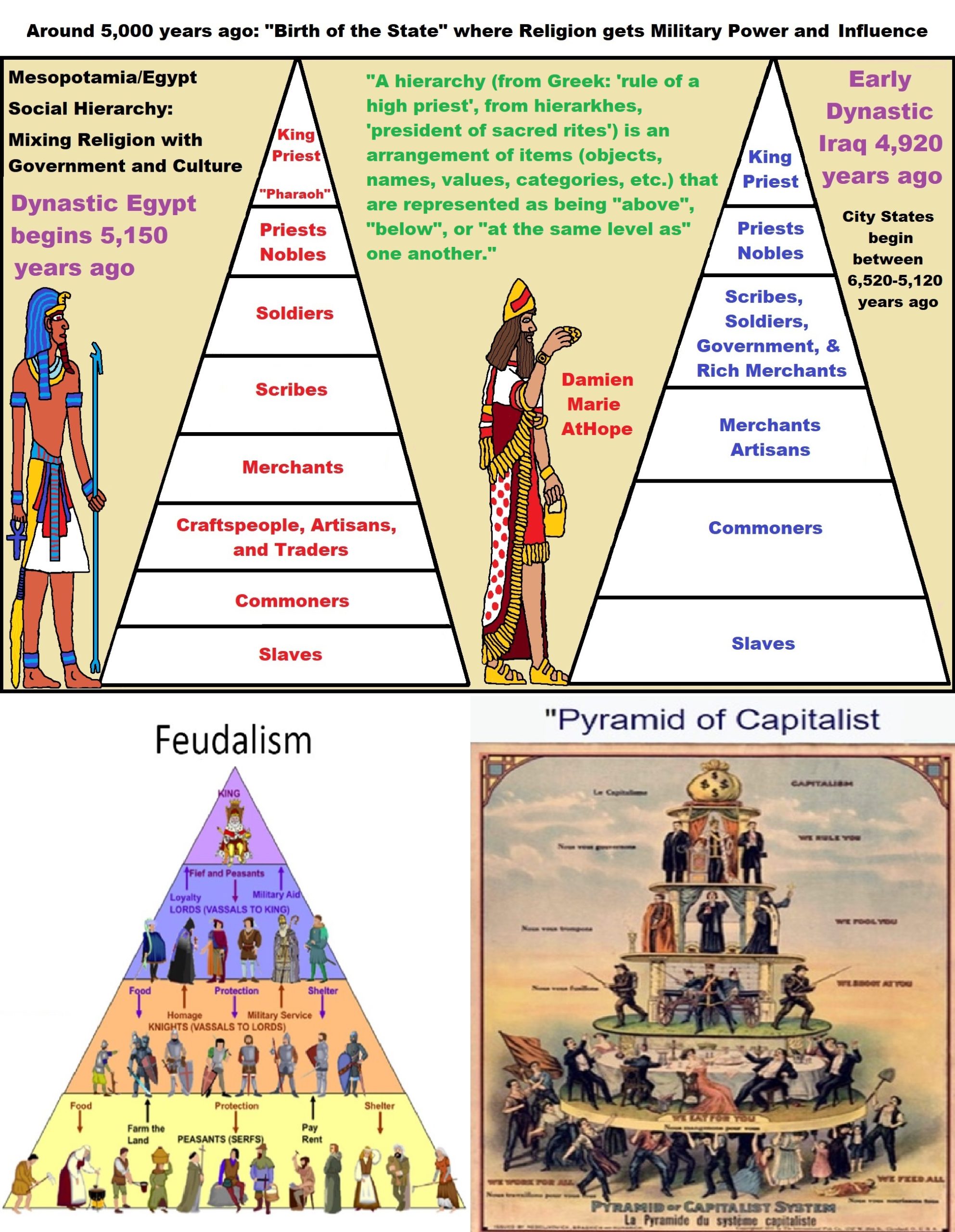
“A hierarchy (from Greek: ‘rule of a high priest’, from hierarkhes, ‘president of sacred rites’) is an arrangement of items (objects, names, values, categories, etc.) that are represented as being “above”, “below”, or “at the same level as” one another.” ref


While hallucinogens are associated with shamanism, it is alcohol that is associated with paganism.
The Atheist-Humanist-Leftist Revolutionaries Shows in the prehistory series:
Show two: Pre-animism 300,000 years old and animism 100,000 years old: related to “Anarchism and Socialism”
Show tree: Totemism 50,000 years old: related to “Anarchism and Socialism”
Show four: Shamanism 30,000 years old: related to “Anarchism and Socialism”
Show five: Paganism 12,000 years old: related to “Anarchism and Socialism”
Show six: Emergence of hierarchy, sexism, slavery, and the new male god dominance: Paganism 7,000-5,000 years old: related to “Anarchism and Socialism” (Capitalism) (World War 0) Elite and their slaves!
Prehistory: related to “Anarchism and Socialism” the division of labor, power, rights, and recourses: VIDEO
Pre-animism 300,000 years old and animism 100,000 years old: related to “Anarchism and Socialism”: VIDEO
Totemism 50,000 years old: related to “Anarchism and Socialism”: VIDEO
Shamanism 30,000 years old: related to “Anarchism and Socialism”: VIDEO
Paganism 12,000 years old: related to “Anarchism and Socialism” (Pre-Capitalism): VIDEO
Paganism 7,000-5,000 years old: related to “Anarchism and Socialism” (Capitalism) (World War 0) Elite and their slaves: VIEDO
Paganism 5,000 years old: progressed organized religion and the state: related to “Anarchism and Socialism” (Kings and the Rise of the State): VIEDO
Paganism 4,000 years old: related to “Anarchism and Socialism” (First Moralistic gods, then the Origin time of Monotheism): VIEDO
I do not hate simply because I challenge and expose myths or lies any more than others being thought of as loving simply because of the protection and hiding from challenge their favored myths or lies.
The truth is best championed in the sunlight of challenge.
An archaeologist once said to me “Damien religion and culture are very different”
My response, So are you saying that was always that way, such as would you say Native Americans’ cultures are separate from their religions? And do you think it always was the way you believe?
I had said that religion was a cultural product. That is still how I see it and there are other archaeologists that think close to me as well. Gods too are the myths of cultures that did not understand science or the world around them, seeing magic/supernatural everywhere.
I personally think there is a goddess and not enough evidence to support a male god at Çatalhöyük but if there was both a male and female god and goddess then I know the kind of gods they were like Proto-Indo-European mythology.
*Next is our series idea that was addressed in, Anarchist Teaching as Free Public Education or Free Education in the Public: VIDEO
Our 12 video series: Organized Oppression: Mesopotamian State Force and the Politics of power (9,000-4,000 years ago), is adapted from: The Complete and Concise History of the Sumerians and Early Bronze Age Mesopotamia (7000-2000 BC): https://www.youtube.com/watch?v=szFjxmY7jQA by “History with Cy“
Show #1: Mesopotamian State Force and the Politics of Power (Samarra, Halaf, Ubaid)
Show #2: Mesopotamian State Force and the Politics of Power (Eridu “Tell Abu Shahrain”)
Show #3: Mesopotamian State Force and the Politics of Power (Uruk and the First Cities)
Show #4: Mesopotamian State Force and the Politics of Power (First Kings)
Show #5: Mesopotamian State Force and the Politics of Power (Early Dynastic Period)
Show #6: Mesopotamian State Force and the Politics of Power (King/Ruler Lugalzagesi)
Show #7: Mesopotamian State Force and the Politics of Power (Sargon and Akkadian Rule)
Show #9: Mesopotamian State Force and the Politics of Power (Gudea of Lagash and Utu-hegal)
Show #12: Mesopotamian State Force and the Politics of Power (Aftermath and Legacy of Sumer)

The “Atheist-Humanist-Leftist Revolutionaries”
Cory Johnston ☭ Ⓐ Atheist Leftist @Skepticallefty & I (Damien Marie AtHope) @AthopeMarie (my YouTube & related blog) are working jointly in atheist, antitheist, antireligionist, antifascist, anarchist, socialist, and humanist endeavors in our videos together, generally, every other Saturday.
Why Does Power Bring Responsibility?
Think, how often is it the powerless that start wars, oppress others, or commit genocide? So, I guess the question is to us all, to ask, how can power not carry responsibility in a humanity concept? I know I see the deep ethical responsibility that if there is power their must be a humanistic responsibility of ethical and empathic stewardship of that power. Will I be brave enough to be kind? Will I possess enough courage to be compassionate? Will my valor reached its height of empathy? I as everyone earns our justified respect by our actions, that are good, ethical, just, protecting, and kind. Do I have enough self-respect to put my love for humanity’s flushing, over being brought down by some of its bad actors? May we all be the ones doing good actions in the world, to help human flourishing.
I create the world I want to live in, striving for flourishing. Which is not a place but a positive potential involvement and promotion; a life of humanist goal precision. To master oneself, also means mastering positive prosocial behaviors needed for human flourishing. I may have lost a god myth as an atheist but I am happy to tell you my friend, it is exactly because of that, leaving the mental terrorizer, god belief that I truly regained my connected ethical as well as kind humanity.
Cory and I will talk about prehistory and theism, addressing the relevance to atheism, anarchism, and socialism.
At the same time of the rise of the male god 7,000 years ago was also the very time there was the rise of violence war, and clans to kingdoms, then empires, then states. It is all connected back to 7,000 years ago and it mover across the world.
Cory Johnston: https://damienmarieathope.com/2021/04/cory-johnston-mind-of-a-skeptical-leftist/?v=32aec8db952d
The Mind of a Skeptical Leftist (YouTube)
Cory Johnston: Mind of a Skeptical Leftist
The Mind of a Skeptical Leftist By Cory Johnston: “Promoting critical thinking, social justice, and left-wing politics by covering current events and talking to a variety of people. Cory Johnston has been thoughtfully talking to people and attempting to promote critical thinking, social justice, and left-wing politics.”
Cory Johnston ☭ Ⓐ @Skepticallefty Evidence-based atheist leftist (he/him) Producer, host, and co-host of 4 podcasts @skeptarchy @skpoliticspod and @AthopeMarie
http://anchor.fm/skepticalleft
He needs our support. We rise by helping each other.
Damien Marie AtHope (“At Hope”) Axiological Atheist, Anti-theist, Anti-religionist, Secular Humanist. Rationalist, Writer, Artist, Poet, Philosopher, Advocate, Activist, Psychology, and Armchair Archaeology/Anthropology/Historian.
Damien is interested in: Freedom, Liberty, Justice, Equality, Ethics, Humanism, Science, Atheism, Antiteism, Antireligionism, Ignosticism, Left-Libertarianism, Anarchism, Socialism, Mutualism, Axiology, Metaphysics, LGBTQI, Philosophy, Advocacy, Activism, Mental Health, Psychology, Archaeology, Social Work, Sexual Rights, Marriage Rights, Woman’s Rights, Gender Rights, Child Rights, Secular Rights, Race Equality, Ageism/Disability Equality, Etc. And a far-leftist, “Anarcho-Humanist.”
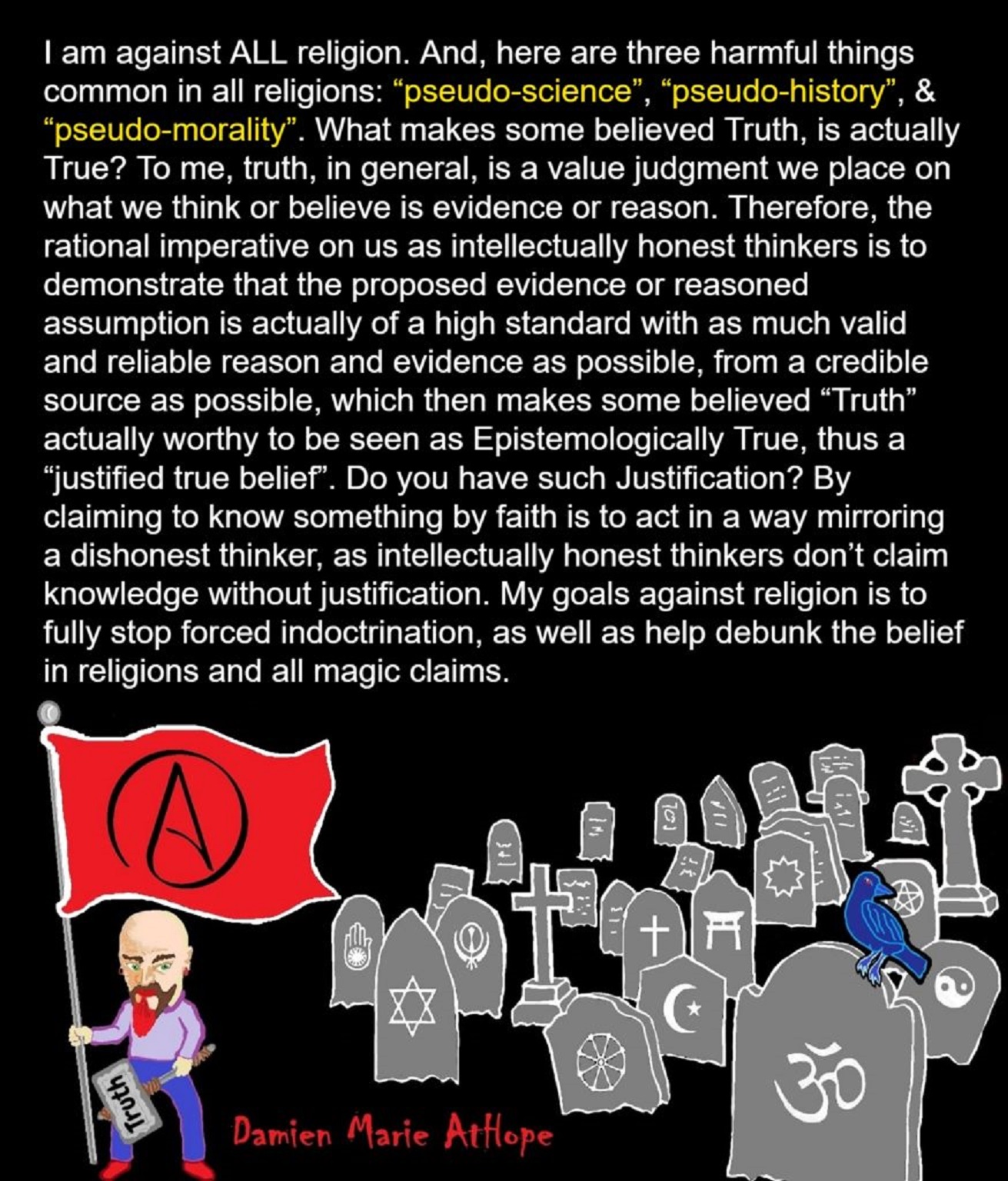

Art by Damien Marie AtHope
Damien Marie AtHope (Said as “At” “Hope”)/(Autodidact Polymath but not good at math):
Axiological Atheist, Anti-theist, Anti-religionist, Secular Humanist, Rationalist, Writer, Artist, Jeweler, Poet, “autodidact” Philosopher, schooled in Psychology, and “autodidact” Armchair Archaeology/Anthropology/Pre-Historian (Knowledgeable in the range of: 1 million to 5,000/4,000 years ago). I am an anarchist socialist politically. Reasons for or Types of Atheism
My Website, My Blog, My (free accesses) Patreon, My (free accesses) Patreon Blog & Short-writing or Quotes My YouTube, Twitter: @AthopeMarie, and My Email: damien.marie.athope@gmail.com

